9.1: Deploying Supporting Materials
9.1.1: Types of Supporting Materials
There are many types of supporting materials, some of which are better suited for logical appeals and some for emotional appeals.
Learning Objective
Discuss the advantages and disadvantages of using different types of supporting materials
Key Points
- Scientific evidence includes all factual information. It is necessary and particularly useful for logical appeals.
- Testimonials, personal experience, intuition, and anecdotal evidence are all great for emotional appeals.
- Non-scientific supporting materials may be useful, but are not necessarily reflective of broader truths.
Key Term
- anecdote
-
An account or story which supports an argument, but which is not supported by scientific or statistical analysis.
There are a number of types of supporting materials, each of which has its own advantages and disadvantages. Not every type of supporting material is useful or effective in every situation, but each has its own niche.
Scientific Evidence
Scientific evidence is evidence which serves to either support or counter a scientific theory or hypothesis. Such evidence is expected to be empirical and in accordance with scientific method. Standards for scientific evidence vary according to the field of inquiry, but the strength of scientific evidence is generally based on the results of statistical analysis and the strength of scientific controls.More broadly, scientific evidence can be any statistic or fact that has been proven to be true through rigorous scientific methods. Facts and figures are necessary for logical appeals .

Scientific Evidence
Statistics are a type of scientific evidence that can bolster arguments.
Personal Experience
Personal experience is the retelling of something that actually happened to the speaker. Personal experience is useful for emotional appeals, but is not always good for more scientific arguments.
Anecdotal Evidence
Anecdotal evidence is evidence from anecdotes (stories). Because of the small sample, there is a larger chance that it may be unreliable due to cherry-picked or otherwise non-representative samples of typical cases. Anecdotal evidence is considered dubious support for a claim; it is accepted only in lieu of more solid evidence. However, it is particularly useful for making emotional appeals.
Intuition
Intuition is the ability to acquire knowledge without inference or the use of reason. Intuition provides us with beliefs that we cannot justify in every case. For this reason, intuition is not a particularly strong supporting material.
Testimonial
A testimonial is when someone speaks on behalf of another idea, product, or person. For example, weight loss commercials often utilize testimonials. The power lies in how convincing the person giving the testimonial is.
9.1.2: Using Supporting Materials
Supporting materials bolster arguments and can make them more persuasive to audience members.
Learning Objective
Identify reasons to use supporting materials and which types of materials are appropriate in a given situation
Key Points
- Scientific evidence is used to prove that a set of facts exist in the world.
- Non-scientific evidence is often used to create emotional connections with the audience, which can make them more receptive to the argument.
- Misused supporting materials can ruin your perceived reliability as a speaker and cause the audience to stop taking your argument seriously.
Key Term
- scientific evidence
-
Empirical, true facts or figures.
Supporting materials are necessary to turn an opinion into a persuasive argument. Being able to say something and have others immediately accept it as truth is a privilege afforded few speakers in few settings. In the vast majority of cases, audiences will not just want to hear the view you are asking them to accept, but also why they should accept it.
Supporting materials come in many different forms, from scientific evidence to personal experiences. Each is useful in different situations, but all are used to cause the audience to stop rejecting your idea as foreign and instead internalize it as truth.
Not all supporting evidence, however, is created equally. For example, scientific evidence is absolutely necessary in settings such as an exam. Appealing to the emotions of the professor is unlikely to yield a positive result, while articulating and analyzing the correct facts is. Scientific evidence is used to prove that a set of facts or conditions is present in the world.

Scientific Evidence
In most subjects, exam questions test the individual’s grasp of empirical evidence (scientific evidence).
In other instances, more experiential evidence will help you connect to the audience on a personal level. Personal experiences and anecdotes are great for establishing an emotional connection with the audience. Being able to connect emotionally helps to mitigate some of the boredom that often accompanies appeals that are just facts.
Using non-scientific evidence comes with some dangers, however. Non-scientific information is not often generalizable. That is, just because there is a story (or series of stories) does not mean that they necessarily represent the broader truth. Some audiences are skeptical of non-scientific supporting materials for this very reason. Using an anecdote of a boat sinking, for example, is unlikely to persuade most audiences that all boats sink. Attempting to use this type of evidence can actually weaken the appeal by decreasing your perceived reliability as a source.
9.1.3: Using Supporting Materials Effectively
Supporting materials are effective only if they help persuade the audience.
Learning Objective
Name elements to be considered when deciding what type of supporting materials to deploy
Key Points
- Regardless of the type of supporting material used, they are effective only if they fulfill the speaker’s burden of proof.
- Supporting materials must exist in order to be used; not all types exist for all arguments.
- The supporting evidence used depends on the idea being supported. Some ideas are more effectively supported by certain types of materials.
- Not all types of supporting materials are effective for every appeal. Speakers should select the materials that make their specific appeal most effective.
- The type of supporting material used also depends on the audience. If the audience cannot comprehend the material, it is not effective.
Key Term
- comprehensible
-
Able to be comprehended; understandable.
Using Supporting Materials Effectively
Supporting materials are the difference between an opinion and a convincing argument. Supporting materials are effective only if they help to persuade the audience. The type of supporting materials that should be deployed depend on the following:
- Available supporting material: not all types of supporting materials exist for all arguments. If there is no evidence, it obviously cannot be used.
- The idea being supported: if you are trying to explain that your favorite ice cream is chocolate, then scientific evidence about the molecular composition of chocolate ice cream is not as effective as personal accounts .
- The type of appeal: emotional and logical appeals tend to be supported by different types of materials. All types of supporting material can be used for emotional appeals, but providing data may not be as effective as providing anecdotes for connecting with the audience. For logical appeals, all types can again be used, though the most effective support is scientific evidence, because it is empirical and true.
- The audience: different audiences respond differently to different types of supporting evidence. It is the speaker’s job to determine what supporting materials will be most comprehensible and effective.

Gathering Evidence
An individual must have enough supporting material (evidence) in order to write a convincing speech.
Regardless of the type of supporting material used, they are effective only if they fulfill the speaker’s burden of proof. If the supporting materials are not delivered in a way that advances that goal, they are not deployed effectively.
For example, if you are speaking in front of a large crowd, and use a chart printed out on a sheet of paper, it doesn’t really matter what the chart says. If the audience cannot see the chart, then it will not be understood or effective. The same goes for other types of supporting materials; they are only effective if they can convince the audience.
9.2: Using Examples
9.2.1: Types of Examples: Brief, Extended, and Hypothetical
Brief, extended, and hypothetical examples can be used to help an audience better understand and relate to key points of a presentation.
Learning Objective
List the three types of examples
Key Points
- Examples include specific situations, problems or stories intended to help communicate a more general idea.
- Brief examples are used to further illustrate a point that may not be immediately obvious to all audience members but is not so complex that is requires a more lengthy example.
- Extended examples are used when a presenter is discussing a more complicated topic that they think their audience may be unfamiliar with.
- A hypothetical example is a fictional example that can be used when a speaker is explaining a complicated topic that makes the most sense when it is put into more realistic or relatable terms.
Key Term
- Hypothetical
-
A fictional situation or proposition used to explain a complicated subject.
There are many types of examples that a presenter can use to help an audience better understand a topic and the key points of a presentation. These include specific situations, problems, or stories intended to help communicate a more general idea. There are three main types of examples: brief, extended, and hypothetical.
Brief Examples
Brief examples are used to further illustrate a point that may not be immediately obvious to all audience members but is not so complex that is requires a more lengthy example. Brief examples can be used by the presenter as an aside or on its own. A presenter may use a brief example in a presentation on politics in explaining the Electoral College. Since many people are familiar with how the Electoral College works, the presenter may just mention that the Electoral College is based on population and a brief example of how it is used to determine an election. In this situation it would not be necessary for a presented to go into a lengthy explanation of the process of the Electoral College since many people are familiar with the process.
Extended Examples
Extended examples are used when a presenter is discussing a more complicated topic that they think their audience may be unfamiliar with. In an extended example a speaker may want to use a chart, graph, or other visual aid to help the audience understand the example. An instance in which an extended example could be used includes a presentation in which a speaker is explaining how the “time value of money” principle works in finance . Since this is a concept that people unfamiliar with finance may not immediately understand, a speaker will want to use an equation and other visual aids to further help the audience understand this principle. An extended example will likely take more time to explain than a brief example and will be about a more complex topic.

Extended Example
An equation is an extended example that’s used as a visual aid to help the audience understand a complicated topic.
Hypothetical Examples
A hypothetical example is a fictional example that can be used when a speaker is explaining a complicated topic that makes the most sense when it is put into more realistic or relatable terms. For instance, if a presenter is discussing statistical probability, instead of explaining probability in terms of equations, it may make more sense for the presenter to make up a hypothetical example. This could be a story about a girl, Annie, picking 10 pieces of candy from a bag of 50 pieces of candy in which half are blue and half are red and then determining Annie’s probability of pulling out 10 total pieces of red candy. A hypothetical example helps the audience to better visualize a topic and relate to the point of the presentation more effectively.
9.2.2: Communicating Examples
Examples help the audience understand the key points; they should be to the point and complement the topic.
Learning Objective
Use examples to help your audience understand the message being presented
Key Points
- Examples are essential to a presentation that is backed up with evidence, and they help the audience effectively understand the message being presented. An example is a specific situation, problem, or story intended to help communicate a more general idea.
- One method of effectively communicating examples is by using an example to clarify and complement a main point of a presentation.
- A speaker should be careful to not overuse examples, as too many examples may confuse the audience and distract them from focusing on the key points that the speaker is making.
Key Terms
- phenomenon
-
A fact or event considered very unusual, curious, or astonishing by those who witness it.
- abstract
-
Difficult to understand; abstruse.
Communicating Examples
Examples are essential to a presentation that is backed up with evidence, and they help the audience effectively understand the message being presented. An example is a specific situation, problem, or story intended to help communicate a more general idea. Examples are most effective when they are used as a complement to a key point in the presentation and focus on the important topics of the presentation.

Giving an Example
An example can make an abstract idea clearer.
Using Examples to Complement Key Points
One method of effectively communicating examples is by using an example to clarify and complement a main point of a presentation. If an orator is holding a seminar about how to encourage productivity in the workplace, he or she might use an example that focuses on an employee receiving an incentive (such as a bonus) to work harder, and this improved the employee’s productivity. An example like this would act as a complement and help the audience better understand how to use incentives to improve performance in the workplace.
Using Examples That Are Concise and to the Point
Examples are essential to help an audience better understand a topic. However, a speaker should be careful to not overuse examples, as too many examples may confuse the audience and distract them from focusing on the key points that the speaker is making.
Examples should also be concise and not drawn out so the speaker does not lose the audience’s attention. Concise examples should have a big impact on audience engagement and understanding in a small amount of time.
9.3: Using Statistics
9.3.1: Understanding Statistics
Statistics can be a powerful tool in public speaking if the speaker appropriately explains their use and significance.
Learning Objective
Use appropriate statistics in your speech in a way that is easy for your audience to understand
Key Points
- Understanding statistics requires creating a persuasive narrative that explains the data and an adequate explanation of why a statistic is being used, what it means and its source.
- The persuasive use of statistics is one of the most powerful tools in any rational argument, especially in public presentations.
- There are many ways to interpret statistics, however a public speaker should be mindful that they are presenting a statistic in an accurate way and not misleading the audience through a misrepresentation of a statistic.
Key Term
- statistics
-
A systematic collection of data on measurements or observations, often related to demographic information such as population counts, incomes, population counts at different ages, etc.
Understanding Statistics
Using statistics in public speaking can be a powerful tool. It provides a quantitative, objective, and persuasive platform on which to base an argument, prove a claim, or support an idea. Before a set of statistics can be used, however, it must be made understandable by people who are not familiar with statistics. The key to the persuasive use of statistics is extracting meaning and patterns from raw data in a way that is logical and demonstrable to an audience. There are many ways to interpret statistics and data sets, not all of them valid.
Guidelines for Helping Your Audience Understand Statistics
- Use reputable sources for the statistics you present in your speech such as government websites, academic institutions and reputable research organizations and policy/research think tanks.
- Use a large enough sample size in your statistics to make sure that the statistics you are using are accurate (for example, if a survey only asked four people, then it is likely not representative of the population’s viewpoint).
- Use statistics that are easily understood. Many people understand what an average is but not many people will know more complex ideas such as variation and standard deviation.
- When presenting graphs, make sure that the key points are highlighted and the graphs are not misleading as far as the values presented.
- Statistics is a topic that many people prefer to avoid, so when presenting statistical idea or even using numbers in your speech be sure to thoroughly explain what the numbers mean and use visual aids to help you explain.
Common Uses of Statistics in a Speech
Some common uses of statistics in a speech format may include:
- Results from a survey and discussion of key findings such as the mean, median, and mode of that survey.
- Comparisons of data and benchmarking results—also using averages and comparative statistics.
- Presenting findings from research, including determining which variables are statistically significant and meaningful to the results of the research. This will likely use more complicated statistics.
Common Misunderstandings of Statistics
A common misunderstanding when using statistics is “correlation does not mean causation. ” This means that just because two variables are related, they do not necessarily mean that one variable causes the other variable to occur. For example, consider a data set that indicates that there is a relationship between ice cream purchases over seasons versus drowning deaths over seasons. The incorrect conclusion would be to say that the increase in ice cream consumption leads to more drowning deaths, or vice versa. Therefore, when using statistics in public speaking, a speaker should always be sure that they are presenting accurate information when discussing two variables that may be related. Statistics can be used persuasively in all manners of arguments and public speaking scenarios—the key is understanding and interpreting the given data and molding that interpretation towards a convincing statement.
9.3.2: Communicating Statistics
Visual tools can be an effective way of incorporating statistics in your persuasive speech.
Learning Objective
Illustrate your argument by incorporating accurate statistics via visual tools.
Key Points
- Your audience is much more likely to believe you if you incorporate statistics.
- Consider using visual tools such as tables, graphs, and maps to make statistics more understandable for your audience.
Key Term
- statistics
-
A systematic collection of data on measurements or observations, often related to demographic information such as population counts, incomes, population counts at different ages, etc.
Using Visuals
Statistics is the study of the collection, analysis, interpretation, presentation, and organization of data.
Because data represent facts, incorporating statistics in your persuasive speech can be an effective way of adding both context and credibility to your argument. Your audience is much more likely to believe you if you incorporate statistics.
Statistics can be difficult to understand on their own, though. As a result, consider using visual tools such as tables, graphs, and maps to make statistics more understandable for your audience. These visuals are often easier to understand than raw data.

Using a Map
A map, a type of visual representation, can make data easier for the audience to understand.
9.4: Using Testimony
9.4.1: Expert vs. Peer Testimony
There are two types of testimony: expert testimony and peer testimony.
Learning Objective
Differentiate between expert testimony and peer testimony
Key Points
- A testimony is an assertion made by someone who has experience or knowledge of a particular matter.
- Expert testimony is testimony given by a person who is considered an expert by virtue of education, training, certification, skills, and/or experience in a particular matter.
- Peer testimony is given by a person who does not have expertise in a particular matter.
Key Terms
- Expert testimony
-
Testimony given by a person who is considered an expert by virtue of education, training, certification, skills, and/or experience in a particular matter.
- Peer testimony
-
Testimony given by a person who does not have expertise in a particular matter.
- testimony
-
An assertion made by someone who has knowledge or experience in a particular matter.
Introduction
A testimony is an assertion made by someone who has knowledge or experience in a particular matter.
Testimony is used in various contexts for a wide range of purposes. For example, in the law, testimony is a form of evidence that is obtained from a witness who makes a solemn statement or declaration of fact.
There are two major types of testimony: peer testimony and expert testimony.
Expert Testimony
Expert testimony, as the name suggests, is testimony given by a person who is considered an expert by virtue of education, training, certification, skills, and/or experience in a particular matter. Because experts have knowledge beyond that of a typical person, expert testimony carries considerable weight. Though an expert is an authority in a particular subject, his or her testimony can certainly be called into question by other facts, evidence, or experts.

Providing Testimony
Chairman of the Joint Chiefs of Staff Marine Gen. Joseph F. Dunford Jr. provides testimony to the Senate Armed Services Committee on counter-ISIL operations and Middle East strategy.
Peer Testimony
Peer testimony, unlike expert testimony, is given by a person who does not have expertise in the subject in question. As a result, those who provide peer testimony are sometimes referred to as “anti-authorities.”
A person who provides peer testimony might not have expertise in a particular area, but he or she likely has personal experience with the issue at hand. Though peer testimony can easily be challenged, it can still be a powerful tool in persuading an audience, particularly when delivered or provided by a well-liked celebrity.
Questions to Consider Before Using Testimony
Before incorporating testimony, ask yourself:
- Are you quoting the testimony accurately?
- Is the testimony biased? In what way?
- Is the person providing the testimony competent and/or well respected?
- Is the testimony current?
- How will your audience respond to the testimony?
9.4.2: How to Incorporate Expert Testimony
Expert testimony can be incorporated after introducing a point of your argument.
Learning Objective
State why it is beneficial to incorporate expert testimony into a speech
Key Points
- Expert testimony should be incorporated to support, defend, or explain the main point or subpoint of a speech.
- Limiting your main points, subpoints, and support points to three or four points each improves the ability for your speech to communicate with the audience.
- Noticing how professionals use the testimony of experts can provide creative examples for how to incorporate expert testimony into a speech.
Key Terms
- expert
-
A person with extensive knowledge or ability in a given subject.
- TED
-
Technology Entertainment Design, a series of global conferences.
Introduction
Once you have found experts to support your ideas, you may wonder how to incorporate their testimony into your speech. The following will give you an idea of how to incorporate expert testimony in order to support your argument and improve your speech.
What the Body of Your Speech Should Include
The body of your speech should help you elaborate and develop your main objectives clearly by using main points, subpoints, and support for your sub points. To ensure that your speech clearly communicates with your audience, try to limit both your main points and subpoints to three or four points each;this applies to your supporting points, as well. Expert testimony is considered supporting point; it is used to support the main and subpoints of your speech.
When a claim or point is made during a speech, the audience initially may be reluctant to concede or agree to the validity of the point. Often this is because the audience does not initially accept the speaker as a trustworthy authority. By incorporating expert testimony, the speaker is able to bolster their own authority to speak on the topic.
Therefore, expert testimony is commonly introduced after a claim is made. For example, if a speech makes the claim, “Manufacturing jobs have been in decline since the 1970s,” it should be followed up with expert testimony to support that claim. This testimony could take a variety of forms, such as government employment statistics or a historian who has written on a particular sector of the manufacturing industry. No matter the particular form of expert testimony, it is incorporated following a claim to defend and support that claim, thus bolstering the authority of the speaker.
Example of Incorporating Expert Testimony
Search for and watch a TED talk by Barry Schwartz, Professor of Social Theory and Social Action at Swarthmore College. Notice how Schwartz references expert testimony in the course of his speech to justify his point to the audience.

Barry Schwartz
Incorporating testimony from experts supports and clarifies claims made during a speech.
Schwartz begins by showing the job description of a hospital janitor, noting that the tasks do not require interaction with other people. However, Schwartz introduces the expert testimony of actual hospital janitors as a way to complicate the apparent solo nature of janitorial work. Schwartz personalizes the experts with proper names, “Mike,” “Sharleene,” and “Luke,” and uses their testimony to demonstrate that despite the job description, janitors take social interaction to be an important part of their job.
In this instance, Schwartz incorporates the expert testimony of actual janitors as a both a foil and a support. The testimony shows that in fact janitorial work does include interaction with other people, thus foiling the initial presentation of janitorial work as solitary. In addition, Schwartz uses the testimony of these experts to show that they embody the characteristics of wisdom that Schwartz will describe in the remainder of the speech.
9.5: Using Other Supporting Materials
9.5.1: Analogies
Analogies draw comparisons between ideas or objects that share certain aspects or characteristics, but are dissimilar in other areas.
Learning Objective
Define analogies and how they can be used as a linguistic tool in public speaking
Key Points
- Analogies compare something new and different (the main topic of a speech) to people, places, objects, and ideas familiar to audience members.
- Public speakers often use analogies to strengthen political and philosophical arguments, even when the semantic similarity is weak or non-existent.
- Analogies that begin with phrases including “like”, “so on,” and “as if” rely on an analogical understanding by the receiver of a message that includes such phrases.
- Considering audience demographics, and constructing similar rather than extreme analogies, are tactics public speakers use to create effective analogies.
Key Terms
- homomorphism
-
A similar appearance of two unrelated organisms or structures.
- iconicity
-
The state of being iconic (in all meanings).
- isomorphism
-
A one-to-one correspondence.
Example
- Some examples of analogies: the human eye is like a camera, love is a kind of game, sound waves are like the circular ripples that spread from a stone dropped in water.
Analogies
Analogies draw comparisons between ideas or objects that share certain aspects or characteristics, but are dissimilar in other areas. This cognitive process transfers information or meaning from one particular subject (the analogue or source) to another particular subject (the target) to infer meaning or prove an argument. In public speaking, analogy can be a powerful linguistic tool to help speakers guide and influence the perception and emotions of the audience.

Using Analogies
Analogies often use the structure “A is like B.” For example, the human eye is like a camera.
Analogies in Public Speaking
Linguistically, an analogy can be a spoken or textual comparison between two words (or sets of words) to highlight some form of semantic similarity between them. Thus, public speakers often use analogies to strengthen political and philosophical arguments, even when the semantic similarity is weak or non-existent (if crafted carefully for the audience).
Often presenters speak about topics, concepts, or places that may seem alien or abstract for audiences. To build trust and credibility on stage, speakers repeatedly link their main topic or argument to the values, beliefs, and knowledge of their audience. Demonstrating how the relationship between one set of ideas is comparable or similar to a different set ideas helps bridge this gap in understanding for listeners unable to formulate the relationship on their own. Likewise, analogies are sometimes used to persuade those that cannot detect the flawed or non-existent arguments within the speech.
The Construction and Role of Analogies in Language
Analogies that begin with phrases including “like,” “so on,” and “as if” rely on an analogical understanding by the receiver of a message that includes such phrases. Analogy is important not only in ordinary language and common sense (where proverbs and idioms give many examples of its application ), but also in science, philosophy, and the humanities. Presenters and writers also use analogies to enhance and enliven descriptions, and to express thoughts and ideas more clearly and precisely.
The concepts of association, comparison, correspondence, mathematical and morphological homology, homomorphism, iconicity, isomorphism, metaphor, resemblance, and similarity are closely related to analogy. In cognitive linguistics, the notion of conceptual metaphor may be equivalent to that of analogy.
Tips for Using Analogies
- Think about audience demographics. What are their interests, beliefs, and values? Choose a suitable analogy that the audience will be able to connect with and relate to.
- Keep analogies short and simple. Extreme analogies can weaken rather than strengthen an argument.
- Use analogies as a springboard rather than as the main focus of the presentation.
- Use analogies from personal experiences to create authenticity and credibility with the audience.
9.5.2: Definitions
It is easier to support your ideas when you provide definitions ensuring that you and your audience are working with the same meaning.
Learning Objective
State how defining key terms creates credibility for public speakers
Key Points
- Providing the definition of the key terms also works as a signal to your audience that you know what you’re talking about.
- In order to define the key terms, you first have to bluntly state what they are.
- Very often, you’ll use the work of somebody else to help you define the key terms.
Key Term
- concept
-
An understanding retained in the mind, from experience, reasoning and/or imagination; a generalization (generic, basic form), or abstraction (mental impression), of a particular set of instances or occurrences (specific, though different, recorded manifestations of the concept).
Example
- You can define fruit salad as consisting of bananas, pineapples, and yellow apples (ideally you would have a reason for this, too). Having done so, your audience will not object when you later state that fruit salad lacks the vital bits of red. Your definition of a fruit salad has supported this idea.
Introduction
During the introduction to your speech or presentation, you’ve given your audience a promise. You’ve told them that in exchange for their attention, you are going to deliver some information that answers the question which spawned the presentation in the first place.
Now you are giving the main part of your speech, and your audience expects you to deliver as promised.
There’s just one problem. Even though you’ve already decided what to include in the answer, you realize that there are times when the listeners may lose focus because they aren’t following you.
One way to make sure that your answer is focused is to tell your audience what you are talking about. In other words, define your key terms. In doing this, you do two things: First, you show that you know what you are speaking about. Second, you avoid misunderstandings by settling on a single understanding of the key terms. It might be that your audience understands power in a Marxist way, and you want to approach the presentation from a feminist point of view. By providing a brief definition, there will be no misunderstanding. Your audience may not agree with you, but that is not necessary to get your point across.
A definition makes sure you and your audience are talking about the same things.
For example, you can define fruit salad as consisting of bananas, pineapples, and yellow apples (ideally you would have a reason for this, too). Having done so, your audience will not object when you later state that fruit salad lacks the vital bits of red. Your definition of a fruit salad has supported this idea.

Using a Dictionary
A dictionary is the most obvious place to find definitions, but other sources can be used as well.
Providing Definitions
In order to define the key terms, you first have to bluntly state what they are. Always include the key words included in the question. These have been identified as central concepts for you, and by excluding them, you’ll be very likely answering a different question from the one set.
There are often other key terms you want to include, and it’s usually worth spending some time thinking about which ones are the key concept. The number of definitions you include will depend on the length of your speech. Sometimes it takes a bit of time to think which terms are the central ones. This is time worth spending, because you can later use the concepts without giving any further qualifications or comments. For this reason, you should also define the terms carefully.
Having defined “power” in a particular way, every time you use the term in the presentation, it will have the meaning you desire.
Providing the definition of the key terms also works as a signal to your audience that you know what you’re talking about. By defining “power” in a certain way, you demonstrate that you’re aware of other interpretations. In fact, it will usually not be necessary to state what the other interpretations are, unless the distinction is a key aspect of the argument.
It is easy to support your ideas once you’ve created credibility.
Examples
Very often, you’ll use the work of somebody else to help you define the key terms. The following two paragraphs define the concepts “social disadvantage” and “siblings. ” The definitions are taken from a range of sources, and referenced accordingly. In the context of another speech or presentation, these definitions may be too long or too short.
Social disadvantage, to start with, refers to a range of difficulties a person can be exposed to. According to McLanahan and Sandefur, social disadvantages include a lower expectancy in educational attainment, lower prospects at work, or lower status in society. Steinberg demonstrated that social and economic disadvantages in society often come together, leading some sociologists talking about underclasses. Social disadvantage, however, does not necessarily have to be as extreme as that: it describes a relative difficulty in reaching a similar position in society than people not disadvantaged.
Siblings, finally, in the context of this presentation, refer to brothers and sisters of the same birth family. This
means
that siblings are biologically related, as well as living in the same family.
9.5.3: Visual Demonstrations
Visual aids are often used to help audiences of informative and persuasive speeches understand the topic being presented.
Learning Objective
List the different ways visual aids add impact to a presentation
Key Points
- Visual aids are often used to help audiences of informative and persuasive speeches understand the topic being presented.
- The use of objects as visual aids involves bringing the actual object to demonstrate on during the speech.
- Models are representations of another object that serve to demonstrate that object when use of the real object is ineffective for some reason (e.g., the solar system).
- Maps show geographic areas that are of interest to the speech. They often are used as aids when speaking of differences between geographical areas or showing the location of something.
- Drawings or diagrams can be used when photographs do not show exactly what the speaker wants to show or explain.
Visual aids are often used to help audiences of informative and persuasive speeches understand the topic being presented. Visual aids can play a large role in how the audience understands and takes in information that is presented. There are many different types of visual aids that range from handouts to PowerPoints. The type of visual aid a speaker uses depends on their preference and the information they are trying to present. Each type of visual aid has pros and cons that must be evaluated to ensure it will be beneficial to the overall presentation. Before incorporating visual aids into speeches, the speaker should understand that if used incorrectly, the visual will not be an aid, but a distraction.
Planning ahead is important when using visual aids. It is necessary to choose a visual aid that is appropriate for the material and audience. The purpose of the visual aid is to enhance the presentation.
Objects
The use of objects as visual aids involves bringing the actual object to demonstrate on during the speech. For example, a speech about tying knots would be more effective by bringing in a rope.
- Pro: the use of the actual object is often necessary when demonstrating how to do something so that the audience can fully understand procedure.
- Con: some objects are too large or unavailable for a speaker to bring with them.
Models
Models are representations of another object that serve to demonstrate that object when use of the real object is ineffective for some reason. Examples include human skeletal systems, the solar system, or architecture.
- Pros: models can serve as substitutes that provide a better example of the real thing to the audience when the object being spoken about is of an awkward size or composure for use in the demonstration.
- Cons: sometimes a model may take away from the reality of what is being spoken about. For example, the vast size of the solar system cannot be seen from a model, and the actual composure of a human body cannot be seen from a dummy.
Graphs
Graphs are used to visualize relationships between different quantities. Various types are used as visual aids, including bar graphs, line graphs, pie graphs, and scatter plots.
- Pros: graphs help the audience to visualize statistics so that they make a greater impact than just listing them verbally would.
- Cons: graphs can easily become cluttered during use in a speech by including too much detail, overwhelming the audience and making the graph ineffective.
Maps
Maps show geographic areas that are of interest to the speech. They often are used as aids when speaking of differences between geographical areas or showing the location of something.
- Pros: when maps are simple and clear, they can be used to effectively make points about certain areas. For example, a map showing the building site for a new hospital could show its close location to key neighborhoods, or a map could show the differences in distribution of AIDS victims in North American and African countries.
- Cons: inclusion of too much detail on a map can cause the audience to lose focus on the key point being made. Also, if the map is disproportional or unrealistic, it may prove ineffective for the point being made.
Tables
Tables are columns and rows that organize words, symbols, and/or data.
- Pros: Good tables are easy to understand. They are a good way to compare facts and to gain a better overall understanding of the topic being discussed. For example, a table is a good choice to use when comparing the amount of rainfall in 3 counties each month.
- Cons: Tables are not very interesting or pleasing to the eye. They can be overwhelming if too much information is in a small space or the information is not organized in a convenient way. A table is not a good choice to use if the person viewing it has to take a lot of time to be able to understand it. Tables can be visual distractions if it is hard to read because the font is too small or the writing is too close together. It can also be a visual distraction if the table is not drawn evenly.
Photographs
- Pros: Photographs are good tools to make or emphasize a point or to explain a topic. For example, when explaining the shanty-towns in a third word country it would be beneficial to show a picture of one so the reader can have a better understanding of how those people live. A photograph is also good to use when the actual object cannot be viewed. For example, in a health class learning about cocaine, the teacher cannot bring in cocaine to show the class because that would be illegal, but the teacher could show a picture of cocaine to the class. Using local photos can also help emphasize how your topic is important in the audience’s area.[8]
- Cons: If the photograph is too small it just becomes a distraction. Enlarging photographs can be expensive if not using a power point or other viewing device.
Drawings or diagrams

Using a Diagram
Diagrams are used to convey detailed information.
- Pros: Drawings or diagrams can be used when photographs do not show exactly what the speaker wants to show or explain. It could also be used when a photograph is too detailed. For example, a drawing or diagram of the circulatory system throughout the body is a lot more effective than a picture of a cadaver showing the circulatory system.
- Cons: If not drawn correctly a drawing can look sloppy and be ineffective. This type of drawing will appear unprofessional.
9.6: Using Life Experience (Narrative)
9.6.1: The Importance of Stories
Because human life is narratively rooted, incorporating story telling into public speaking can be a powerful way of reaching your audience.
Learning Objective
State why effective storytelling is a key component of public speaking
Key Points
- Storytelling is the conveying of events in words, sound and/or images, often by improvisation or embellishment.
- Stories are universal in that they can bridge cultural, linguistic and age-related divides.
- Communicating by using storytelling techniques can be a more compelling and effective route of delivering information than that of using only dry facts.
Key Term
- Storytelling
-
The conveying of events in words, sound and/or images, often by improvisation or embellishment.
Storytelling
Storytelling is the conveying of events in words, sound and/or images, often by improvisation or embellishment. Stories or narratives have been shared in every culture as a means of entertainment, education, cultural preservation and instilling moral values.

Telling a Story
A seafarer tells the young Sir Walter Raleigh and his brother the story of what happened out at sea.
The Power of Storytelling
Storytelling is a powerful tool, a means for sharing experiences and knowledge. It’s one of the ways we learn. Peter L. Berger says human life is narratively rooted, humans construct their lives and shape their world into homes in terms of these groundings and memories. Stories are universal in that they can bridge cultural, linguistic and age-related divides.
The Utility of Storytelling in Public Speaking
Because human life is narratively rooted, incorporating story telling into public speaking can be a powerful way of reaching your audience. For example, communicating by using storytelling techniques can be a more compelling and effective route of delivering information than that of using only dry facts.
9.6.2: How and When to Use Narrative
Presenters use narratives to support their points and make their speeches more compelling.
Learning Objective
Explain how to use narrative in speeches
Key Points
- A narrative is relayed in the form of a story.
- The greatest story commandment is to make the audience care.
- Your story should not be forced; the audience should perceive it as natural part of your speech.
Key Term
- narrative
-
The systematic recitation of an event or series of events. (see also storytelling)
How and When to Use Narrative
Whatever the purpose of your speech, you’re going to need a way to support your statements to prove their accuracy, but a good speech also makes its points interesting and memorable.
The most common forms of support are facts, statistics, testimony, narrative, examples, and comparisons. In this unit, we are going to address narrative .

Using a Narrative
Narratives can be used to support a point that has been made or is about to be made.
The Narrative
Narrative takes the form of a story. Presenters use narratives to support a point that was already made or to introduce a point that will soon be made. Narratives can be combined with facts or statistics to make them even more compelling.
How to Use a Narrative
- Storytelling points toward a single goal. Your story should not be forced, but should come across as a natural part of your speech. If your audience thinks you’re telling a story just because you read that it was a good idea to do so, your story won’t work.
- The task of a story is to make the audience care. Your narrative should be something that your audience can easily understand and relate to.
- Keep it short and sweet. Limit your narrative to three or four minutes at the most. Remember, you are using it to support or clarify your point. Once you’ve done that, move on.
- Your story is not there to replace information. It is there to put something you have said into perspective.
- The best stories paint a picture. They allow your audience to visualize what you are saying.
- Make sure your story builds over time and doesn’t get boring. Keep your audience interested until the end.
- Don’t overuse stories.
- Of course, as the old adage says, “use what you know.” Stories are not just about facts—they’re also about communicating what you have experienced and what you personally know, and feel, to be true.
Chapter 8: Topic Research: Gathering Materials and Evidence
8.1: Gathering Evidence: An Overview
8.1.1: The Importance of Gathering Information
Gathering information can help speakers gain credibility and make their speech current and relevant.
Learning Objective
Explain how gathering research can provide additional credibility to a speech
Key Points
- Don’t simply rely on your own expertise to carry you through the speech. Seek out information to support your arguments and gain credibility with the audience.
- Instead of relying on generalizations or common sense, find current information to update your interpretation of the topic.
- Gather specialized information that will make your speech more relevant to your particular audience.
Key Term
- evidence
-
The available body of facts or information indicating whether a belief or proposition is true or valid.
Example
- See which of these two statements is more insightful: 1. Teenagers spend too much time with their electronic gadgets. This obsession takes them away from the real world and leaves them unprepared for adult life. 2. According to a recent study from the Kaiser Family Foundation, teenagers spend over seven and a half hours a day using electronic devices—mainly smartphones, computers, and TVs. This preoccupation leaves little time to give undivided attention to homework, family time, and extracurricular activities, all of which are essential steps toward adult life.
Why Gather Information?
If you are already an expert on your topic, why should you take the time to gather more information? Personal expertise is a great source of anecdotes, illustrations, and insights about important issues and questions related to your topic. However, one person’s opinion holds less weight than an opinion that is shared by other experts, supported by evidence, or validated by testimonials. The process of gathering information provides opportunities to step beyond the limitations of your own experience and enrich your own understanding of your topic. Here are a few of the benefits you can reap from gathering information:
Gain Credibility
If you want the audience to trust your claims, back them up. Don’t expect the audience to take your word for it, no questions asked. Find evidence, illustrations, anecdotes, testimonials, or expert opinions that support your claims. Compare these two statements—the first is a personal opinion, and the second is an argument supported with evidence. Which statement sounds more credible?
- I believe that building a parking garage near the town square would bring more traffic to local businesses and boost the local economy. Everyone knows it’s impossible to find parking on weekends here, and that keeps a lot of people at home on weekends.
- Small businesses in our sister city, Springfield, reported losses comparable to ours after the financial crisis. However, everything changed for them last year: businesses reported that sales were up, and a few new businesses opened in the center of town, creating new jobs. Why didn’t we get the same result? The mayor of Springfield credits the change to a new parking garage near the city center, which eased the parking shortage and brought more people into town on weekends. What can we learn from this story? There are people out there who want to patronize local businesses but are being driven away by the lack of parking. The plan for a new parking garage in our town square could bring us the same success we saw in Springfield.

Gaining Credibility
A parking garage in another city provides “concrete” evidence (pun intended) to support your argument that the structure encourages people to shop downtown.
The first statement relies on a “common sense” idea about parking convenience, which the audience may or may not agree with. By providing an example of a similar situation, the second statement lends credibility to the claim that a new parking garage would help the local economy.
Make It Current
If you want to assure your audience that you are well-informed about your topic, provide current information about it. Instead of relying on generalizations, gather up-to-date information about the particulars of your topic. See which of these two statements is more insightful:
- Teenagers spend too much time with their electronic gadgets. This obsession takes them away from the real world and leaves them unprepared for adult life.
- According to a recent study from the Kaiser Family Foundation, teenagers spend over seven and a half hours a day using electronic devices—mainly smartphones, computers, and TVs. This preoccupation leaves little time to give undivided attention to homework, family time, and extracurricular activities, all of which are essential steps toward adult life.
The first statement relies on unfounded opinions, leaving gaping holes in its argument. Perhaps teenagers do spend too much time with their devices, but how much time do they spend and why is it a problem? It sounds like a curmudgeonly rant about “kids these days.” The second statement backs its claim up with evidence from a recent study and lists specific problems. Recent information makes it possible to define the problem clearly.
Keep It Relevant
Different audiences have different needs. When you conduct an audience analysis, you will gain valuable demographic information—and you should use that information to guide the search for supporting evidence and illustrations. What would resonate with that particular group of people?
Let’s say you are counseling an audience of nursing students in Florida about their job prospects. If you have general knowledge about nursing jobs, you have a good starting point. If you seek out information about the current market for nursing jobs in Florida, you will have information that is even more valuable to your audience. Make sure your speech is relevant to your audience: take the time to build on your area of expertise by gathering specialized information to fit the occasion.
8.1.2: Sources of Information
When you begin the research process, explore a variety of sources to discover the most useful information.
Learning Objective
State the best practices for conducting research
Key Points
- Research librarians can help you get started on the research process. They can also help you refine your research and save time.
- If you’re looking for the most current information about your topic, look for articles. Make sure their sources are trustworthy, though!
- When you are evaluating the credibility of a source, use the ADAM protocol: Age (how old is the information), Depth (how detailed is the information), Author (how qualified and reputable is the author), and Money (how monetary benefits may have produced biased information).
Key Term
- bibliography
-
A list of books or documents relevant to a particular subject or author.
Sources of Information

Library
Libraries provide many different resources for research, including research librarians, specialized databases, scholarly journals, and, of books.
Research Librarians
When it comes to research, do you feel completely lost, with no idea how or where to start looking for information? In these cases, a research librarian can be a real godsend. Research librarians are trained to give helpful advice about structuring the research process and looking in the right places for relevant information. Even if you’re comfortable with research, a research librarian may be able to save a lot of time by helping you refine your search.
Bibliographies
A bibliography is a collection of publication information about books, articles, and other resources that address a particular topic. You may be surprised to discover how many topics have bibliographies dedicated specifically to them, from very specific topics such as the novel David Copperfield to broader topics such as American environmental history. Annotated bibliographies are especially helpful, since they provide a summary of each resource listed.
Books
If you are looking for general information about your topic, encyclopedias and other reference books are a great place to start. If you want something more specific, search for informative books about your topic and anthologies that include essays or articles about relevant issues.
Specialized Search Engines and Databases
Specialized search engines and databases make it easier to target specific information and filter out irrelevant material. If you are affiliated with a university, you probably have free access to research databases such as JSTOR, EBSCO, ProQuest, and LexisNexis Academic. These services provide a variety of search criteria for finding relevant academic articles and news stories. If you are conducting independent research, try Google Scholar, which is free for everyone.
Articles
If you want the most up-to-date sources of information about your topic, look for articles in academic journals and news publications. The Internet is a great resource for finding articles, but you have to be careful—make sure your sources are trustworthy. Books and articles published in academic journals usually go through a lengthy peer review process that verifies the author’s expertise and the material’s accuracy. Online publications and blogs may not have such reliable fact-checking procedures. If you find useful information in an unfamiliar online source, try to verify it elsewhere before incorporating it into your speech.
ADAM
The “ADAM” protocol is a great way to evaluate the credibility of a resource. Consider these criteria:
- Age: Is the source recent? For most topics, current articles are more reliable than old articles, although some topics call for older research.
- Depth: How deep and detailed is the analysis? Are its claims supported by valid evidence?
- Author: What are the author’s qualifications? Do the author’s biography and reputation raise the possibility of potential conflicts of interest or biases? What is the author’s agenda in writing the article?
- Money: Are the authors or publishers affiliated with institutions or corporations that have material benefits at stake in the issue?
News Sources vs. Scholarly Sources
News sources often contain both factual content and opinion content. News reporting from less-established outlets is generally considered less reliable for statements of fact. Editorial commentary, analysis and opinion pieces, whether written by the editors of the publication (editorials) or outside authors (op-eds) are reliable primary sources for statements attributed to that editor or author, but are rarely reliable for statements of fact. When taking information from opinion content, the identity of the author may help determine reliability. The opinions of specialists and recognized experts are more likely to be reliable and to reflect a significant viewpoint.
For information about academic topics, scholarly sources and high-quality non-scholarly sources are generally better than news reports. News reports may be acceptable depending on the context. Articles which deal in depth with specific studies, as a specialized article on science, are apt to be of more value than general articles which only tangentially deal with a topic. Frequently, although not always, such articles are written by specialist writers who may be cited by name.
8.1.3: Research Tips: Start Early, Use a Bibliography, and Evaluate Material Critically
Start the research process early, consult a bibliography to find credible sources, and evaluate those sources critically.
Learning Objective
Explain why starting research early, using a bibliography, and evaluating material critically is crucial to the research process
Key Points
- Even seasoned public speakers start preparing early—follow their lead!
- Bibliographies, which compile many different sources that address a particular topic, are great research tools.
- Make sure you understand the context of your research, especially if you are looking at unfamiliar sources.
Key Terms
- critical thinking
-
he application of logical principles, rigorous standards of evidence, and careful reasoning to the analysis and discussion of claims, beliefs, and issues
- bibliography
-
A list of books or documents relevant to a particular subject or author.
By failing to prepare you are preparing to fail. -Benjamin Franklin
Well begun is half done. -Aristotle
Start Early
Mark Twain once said, “It usually takes me more than three weeks to prepare a good impromptu speech. ” If it took that long for Mark Twain, one of the most eloquent speakers in American history, to write a “good impromptu speech,” students of public speaking should take note and get a nice, early start on the research process. American philosopher Wayne Burgraff estimated that speakers should spend one hour of preparation for every minute of presentation .

The Early Bird
As the saying goes, “the early bird gets the worm. ” When you start the research process early, you have time to find and incorporate the most relevant sources.
Use a Bibliography
Consulting a bibliography will make your research process more efficient. Bibliographies compile publication information about books, articles, and other resources that address a particular topic. Some bibliographies appear as standalone books, while others appear in academic journals or online resources. Annotated bibliographies summarize the main argument of each resource. If a bibliography is recent enough, it can be a one-stop shop for all of your research needs, pointing to many credible sources. However, if the bibliography is old, or if you need the most current information about your topic, you should fill the gap between the end of the bibliography and the present time by looking for articles and books from that time period.
Evaluate Material Critically
90% of everything is garbage! -Theodore Sturgeon
“90% of everything” might be an exaggeration, but, sadly, there is a lot of garbage out there. If you carefully evaluate your sources to make sure they are credible, you stand to save yourself a lot of trouble. Here’s a cautionary tale: Iranian news outlet Fars became a laughingstock after it picked up an American news story claiming that the majority of white Americans in rural areas would rather vote for Iranian President Mahmoud Ahmadinejad than President Barack Obama. That doesn’t sound quite right, does it? Of course, the original story came from The Onion, a satirical newspaper. If the journalists at Fars had checked out their source, they could have avoided an embarrassing mistake. Use your critical thinking skills to make sure you understand the context of your research!
Reliable sources must be strong enough to support the claim. A lightweight source may sometimes be acceptable for a lightweight claim, but never for an extraordinary claim.Questionable sources are those with a poor reputation for checking the facts, or with no editorial oversight. Such sources include websites and publications expressing views that are widely acknowledged as extremist, that are promotional in nature, or which rely heavily on rumors and personal opinions. Questionable sources are generally unsuitable for citing contentious claims about third parties, which includes claims against institutions, persons living or dead, as well as more ill-defined entities. The proper uses of a questionable source are very limited.
Sometimes “non-neutral” sources are the best possible sources for supporting information about the different viewpoints held on a subject. When dealing with a potentially biased source, editors should consider whether the source meets the normal requirements for reliable sources, such as editorial control and a reputation for fact-checking. Editors should also consider whether the bias makes it appropriate to use in-text attribution to the source. Each source must be carefully weighed to judge whether it is reliable for the statement being made and is an appropriate source for that content. In general, the more people engaged in checking facts, analyzing legal issues, and scrutinizing the writing, the more reliable the publication.
8.2: Library Research
8.2.1: Finding Materials in a Library
Physical materials are categorized by a numbering system, and digital materials are easily searchable on library computers.
Learning Objective
Summarize the best practices for finding library materials
Key Points
- All physical materials such as books and DVDs are labeled according to a system, such as the Dewey Decimal Classification. The label corresponds to the material’s location in the library.
- Digital materials, such as databases, are easily searchable from the library’s computers. The homepage will help you determine which source to use and will then direct you to the source.
- Librarians remain one of the best ways to find materials in a library. Their knowledge and expertise can make research must easier.
Key Terms
- database
-
A structured collection of data, typically organized to model relevant aspects of reality (for example, the availability of rooms in hotels), in a way that supports processes requiring this information (for example, finding a hotel with vacancies).
- Dewey Decimal Classification
-
A system that sorts and organizes all of a library’s physical materials. The most common categorization system in American public libraries.
Introduction
Finding the correct information in a library can be a daunting task given the sheer number of resources. To make things easier, libraries have adopted classification systems.
Searching for Materials
There are a number of ways to begin the search for materials.
- You can just jump right in and start searching which is great if you know where to look, but frustrating if you don’t.
- You can go to the library computers which are linked to the library database of material. This allows you to put in the name of the author, the title, or a keyword to find out what materials might contain the information you are looking for.
- You can also simply ask a librarian. Even as more and more information is digitalized, asking a librarian remains one of the most effective ways to find information.
Finding Physical Materials
Physical materials (e.g., books, manuscripts, CDs) are categorized by a series of numbers and letters. The main systems of classification are the Dewey Decimal Classification, the Library of Congress Classification, and the Colon Classification. Though most public libraries use the Dewey Decimal Classification, all of the systems work in essentially the same way.
Each physical piece of material is assigned a number that relates to a hierarchical structure. The first numbers will be the broad subject (e.g., 300 is economics), the following numbers correspond to a subcategory (e.g., .94 is European economy) and so on.

Dewey Decimal Categorization
Library books have a sticker with a categorization number on them. Books are sorted and organized based on the numbers.
Since the materials are placed in order on the shelves, finding the material is a matter of just finding the section with the corresponding codes.
Of course, not all materials are on the shelves at all times. Libraries can reserve a copy or order it from a partner library. They will contact you when the material comes in so you can come pick it up.
Finding Digital Materials
To use the library’s digital materials, such as e-books or subscription-based databases, you need to use one of the library’s computers. In some libraries, it’s enough to just be using the library’s wifi, but either way, the materials are not accessible without being at the library.
The library computers should provide links to different databases with a brief description of what the database is good for. Then, you can go to the database and search the materials just as you would on Google.
8.2.2: Types of Material in a Library
Libraries offer physical, digital, and human resources which can help you research subjects efficiently.
Learning Objective
Discuss how borrowers can take advantage of physical, digital, and people resources in libraries
Key Points
- Librarians can help you determine the best resources to use and introduce you to any technology or software you might need to access them.
- Libraries have physical resources such as books, maps, manuscripts, and periodicals.
- Libraries can provide free access to digital resources such as e-books and databases that are often inaccessible without a subscription.
Key Term
- database
-
A structured collection of data, typically organized to model relevant aspects of reality (for example, the availability of rooms in hotels), in a way that supports processes requiring this information (for example, finding a hotel with vacancies).
Although libraries are normally associated with books, they have numerous other research resources, many of which are beyond the scope of what is easily accessible at home or on the Internet. Moreover, while libraries have a plethora of both physical and digital resources, some of their most valuable assets are their human resources. Librarians are knowledgeable about what information is accessible from each resource and can make your research efforts easier and more efficient.
Physical Resources
Libraries house a number of resources that you can locate, handle, and use immediately . These physical resources include periodicals, magazines, newspapers, maps, and manuscripts, though some may be used only at the library. In addition, many libraries provide media resources such as films, prints, CDs, cassettes, and videos that you can access during your visit. Of course, libraries also have books on a variety of subjects and often have book-sharing arrangements with other libraries, too. If you need a book that is not on the shelves, ask a librarian to order it for you, if possible. Some libraries can also arrange inter-library loans of media resources, too.

Melk Abbey Library
Books are the primary resource in a library, but there are many more resources that can aid in research.
Digital Resources
The advent of digital resources has greatly expanded the walls of libraries. Now, libraries have resources such as e-books and online databases which are not limited to physical locations within the library.
Databases, in particular, are useful for researchers because they allow you to search for information by topic, category, author, date or other useful traits. However, many of the best databases are subscription based, so unless you work for a company that has a subscription or attend a university with one, the only practical (and affordable) place to get access is in the library.
Databases may specialize in a certain field such as medicine, business, or engineering. These databases provide access to not only historical information, but also information that is not easily found through search engines like Google. The in-depth and historical information makes these databases one of the most valuable resources in the library.
Human Resources
Because libraries can house and/or access so much information, you may not discover what you need until you have spent a lot of time exploring what is available. Enlisting the help of a librarian can often save you time because librarians are trained to evaluate all of their libraries’ resources, including the best ways for you to access them and whether they are the appropriate given your specific needs or interests. Librarians can also help you quickly learn to use technology or software, such as microfiche readers or database search programs, which you may need to complete your research.
8.3: Internet Research
8.3.1: Finding Materials on the Internet
Internet search engines are powerful tools for delivering easily accessible sources of information in the research process.
Learning Objective
Identify ways to use search engines to find information on the Internet
Key Points
- If you find yourself with an unfamiliar topic, you can orient yourself by conducting a general, preliminary overview search using Internet search engines.
- Don’t limit yourself to just one search engine; Google, Bing, Yahoo!, Ask, and AOL Search comprise the top five search engines in the U.S. and each do certain types of searches better than others.
- Use Boolean operators like AND, OR, and NOT to refine and specify your search queries for accurate research results.
Key Terms
- search engine
-
an application that searches for, and retrieves, data based on some criteria, especially one that searches the Internet for documents containing specified words
- keyword
-
To tag with keywords, as for example to facilitate searching.
Using the Internet As a Research Source
As you gather research for your speech, you’ll want to have a variety of sources from which to compile supporting evidence and facts. With the advent of digital archiving, social media, and open-source education, it’s easier than ever before to find information on the Internet .

Using the Internet
With such widespread accessibility, the Internet allows you to conduct research from just about anywhere.
Why Use the Internet?
The Internet is pervasive, easily accessible, and continually updated. It only makes sense to capitalize on this ever-evolving technology as a resource for your speech research.
In addition to convenience and accessibility, the Internet allows you to access resources to which you may not have the physical means to get previously. You might not be able to just hop on a plane to Paris and see DaVinci’s La Jaconde (more commonly known as the Mona Lisa), but thanks to the Internet, you can now browse the hundreds of works at Le Louvre right from the convenience of your laptop.
The Internet is also an excellent way to familiarize or orient yourself with an unfamiliar speech topic. While you might not be able to cite every informational source you find, using the Internet in your research process is a fast way to get yourself familiar with the basics of your speech topic, thesis, or key supporting points and arguments.
The Art Of the Search Query
When getting started with most Internet research, the first thing you’ll do is open up your Internet browser and open to a search engine. While Google may dominate the search engine market, recognize that Bing, Yahoo!, Ask, and AOL Search round out the top five most popular search engines in the United States. Other popular search engines include Wolfram Alpha and Instagrok.com. Using different search engines may yield different results, so don’t limit yourself to just one search engine. Additionally, some search engines excel at certain types of information and searches more than others.
Internet information, particularly of a certain quality or standard, can be organized in other ways besides word choice and prominence (as attended by global search engines). Some information may also require further search skills to retrieve. A familiarity with midpoints like directories, “invisible” databases and an attentiveness to further types of organization may reveal the key to finding missing information. A thesaurus, for example, may prove critical to connecting information organized under the business term “staff loyalty” to information addressing the preferred nursing term “personnel loyalty” (MeSH entry for Medline by the [US] National Library of Medicine).
While each search engine may have specific search query shorthand, almost all major search engines function by using Boolean logic and Boolean search operators. Boolean logic symbolically represents relationships between entities and uses three key search operators. These operators help you form your search query:
- AND: The AND operator connects two or more terms to retrieve information that matches all of those terms. If, for example, you were searching for information about the freedom of speech in the United States, you might search for “freedom AND United States. “
- OR: The OR operator searches for information that includes at least one of the keywords included in your query. If you were researching on court cases about freedom of speech, you might search for “freedom of speech OR amendment. “
- NOT: The NOT operator excludes any keywords following the operator and retrieves the appropriate information excluding those terms. If you wanted to find out more about free speech in schools but not anything related to Supreme Court cases, you might search for “freedom of speech NOT Supreme Court. “
8.3.2: Types of Material on the Internet
The Internet can provide you with a wealth and variety of resources for your research process.
Learning Objective
List types of sources that can be found using the Internet
Key Points
- The Internet is a constantly expanding virtual library with over a million terabytes of data and information to be found and millions more gigabytes added daily.
- The Internet can provide you with a variety of sources including: scholarly databases and journals, online encyclopedias, books, and videos.
- Even social media platforms such as Twitter and Facebook can provide you with unique and comprehensive sources of citizen journalism.
Key Terms
- peer review
-
The scholarly process whereby manuscripts intended to be published in an academic journal are reviewed by independent researchers (referees) to evaluate the contribution, i.e. the importance, novelty and accuracy of the manuscript’s contents.
- database
-
A structured collection of data, typically organized to model relevant aspects of reality (for example, the availability of rooms in hotels), in a way that supports processes requiring this information (for example, finding a hotel with vacancies).
- citizen journalism
-
Independent reporting, often by amateurs on the scene of an event, and disseminated via new media.
Types of Material on the Internet

Virtual Library
The Internet is like an endless virtual library where thousands of new sources of information are added every second of the day.
The Internet is like an endless virtual library where thousands of new sources of information are added every second of the day. That being said, there are many different types of information to be found across the vast expanse of the Internet.
Scholarly Journals and Databases
The most common source of reliable, credible information you will find on the Internet is through scholarly journals and databases. These academic, peer reviewed collections provide you with extensive reports, case studies, articles and research studies to help bolster your research process. Most online scholarly journals are categorized by certain subjects, professions, and fields of study and allow you to seek out the most targeted information possible. Many online journals and databases will only let you preview an article abstract or summary, requiring a paid per-article or subscription fee to view the complete article. However, many college and university libraries have arrangements such that you don’t have to pay to view articles. Check with your library to see if they can get you a copy of complete articles that you can’t access online. Popular online scholarly databases include:
- Academic Search Premier
- EBSCO Host
- Entrez-PubMed
- JSTOR
- Lexus Nexus Academic Search
- Project MUSE
- ProQuest
Online Encyclopedias
Several major encyclopedia publishers have online versions of their materials. Some charge an access fee to view full entries. In 2001, Wikipedia sought to change this by creating an open-source encyclopedia edited and curated by the Internet. With over 23 million articles, entries in Wikipedia are collaboratively written by volunteers around the globe. Because of this, the quality of writing may not make it the most reliable or accurate source of information. However, if you’re just looking to get a handle on basic ideas about your speech topic, Wikipedia is a great first source to check out. Also, make sure to click through and investigate a Wikipedia’s article’s references list to find other, more quality and reliable, sources of information on the same subject.
Video
With over 48 hours of content uploaded to YouTube every minute, YouTube has compiled more videos across every two week span (8 years of video per day) than total number of years that motion pictures have existed (117 years in 2012). Video can provide you a rich, visual depth to your Internet research, providing you with first-hand accounts, video tutorials and diaries, and citizen journalism.
Online Books
Online tools such as Project Gutenberg and Google Books now allow you to access full books from the comfort of your Internet browser. Project Gutenberg is an open-source collective of full texts now in the public domain. Google Books offers both full texts and partial previews on millions of books. Because both of these resources index the content of each full text, they are searchable to find the exact content and information you need.
The Impact of Social Media
While many would dismiss the credibility and reliability of information garnered from social media sources, both Twitter and Facebook can provide intrinsic value to your Internet search. Most mainstream journalism outlets can no longer keep up social media’s immediacy of information sharing, making some into a form of citizen journalism that provides real-time, first-person accounts of world events. If you were preparing a speech about the Arab Spring or the 2012 Presidential Election, social media would be invaluable to your research tracking populist sentiment and eyewitness accounts in real-time reporting.
8.3.3: Evaluating Material from the Internet
Given the widespread authorship of the Internet, carefully evaluate all Internet sources for credibility, reliability, bias, and accuracy.
Learning Objective
Evaluate online sources to assure that they are credible, reliable, and accurate
Key Points
- Failure to accurately evaluate your Internet sources leaves you and your speech subject to intense scrutiny and questions of credibility.
- Consider the “age, depth, author and money” of every source you use from the Internet. The ADAM approach can help you determine whether or not you should proceed with using a particular source.
- Looking at a website’s top-level domain can give you clues about its reliability. Generally speaking, it’s safe to trust information from sites with domain names that end in .edu, .gov and .ngo and sometimes .org.
- When using and evaluating social media sources, researchers should be aware of sites that have a poor reputation for checking facts or moderating content.
Key Term
- credibility
-
The objective and subjective components of the believability of a source or message.
Evaluating Internet Material
The biggest advantage of using the Internet as a research tool is the ease with which you can find information. The biggest disadvantage, then, is parsing through the bevy of information to find credible, reliable, accurate information. The burden of filtering truth from fiction in your Internet searches lies solely with you as the researcher.
What is Search Engine Bias?
The first thing to understand about using the Internet as a source of information is that search engines are biased gateways to the information you seek. This bias may be driven by proprietary search algorithms dictated by corporate sponsors, ad revenue, and even politics, thus affecting the type of search results your queries will display. Understand that just because you’re searching for something on a popular search engine, it doesn’t mean you’re getting the full spectrum of available information about your search query.
Essential Questions to Ask When Evaluating Internet Material
When searching for reliable information on the Internet, there are several questions you should ask yourself with each source of information you find. This may seem tedious, but you don’t want your thesis to be undone by someone questioning the credibility of your research, or worse, you as a speaker.
The ADAM Approach
The ADAM approach is an acronym to help you remember the four most important things to consider when evaluating the quality of your materials found via the Internet:
- Age: How recent is the data or information presented in your source? When was the website last updated? Use only the most current information you can find.
- Depth: Does your material go in depth with your subject or merely cover the basics? Are the details from scholarly or academic sources? Look for sources that go in depth rather than provide you with just an overview of your subject.
- Author: Who wrote your source? What are their credentials? What makes them an authoritative expert on this subject? What biases might they have? Try to seek out impartial, authoritative experts when you can.
- Money: Who funds the website? Is the website trying to sell you anything? Who advertises at the website? Where else might this website be advertised? Again, you’ll want to seek out as many impartial sources as you can and you want to make sure that you fully investigate the transparency of any agenda a website might have.
Domain Credibility
Sometimes the clue to a website’s authenticity and credibility is within the actual website address itself. The following top-level domains (TLD) can give you an idea of how reliable and accurate the information may be:
- .com: The most popular TLD worldwide, originally used by commercial entities, now a de facto standard on the Internet. Reliability and credibility not always guaranteed.
- .edu: Only schools, colleges, universities and other educational institutions can use this TLD, often indicating a reliable source of information.
- .gov: Only government organizations may use this TLD. Guaranteed to be both accurate and credible.
- .org: Originally reserved for non-profit organizations (NPO) or non-government organizations (NGO), this TLD can be used by commercial entities. In 2012, a .ngo TLD has been added to the Internet Corporation for Assigned Names and Numbers (ICANN) as a domain extension.
- .net: Primarily used by internet service providers. Depending on what kind of information you’re looking for, sites with a .net TLD may or may not provide you with any useful information.
Social Media and Multimedia Sources
Audio, video, and multimedia materials that have been recorded, then broadcast, distributed, or archived by a reputable party may also meet the necessary criteria to be considered reliable sources. Like text sources, media sources must be produced by a reliable third party and be properly cited. Additionally, an archived copy of the media must exist. It is convenient, but by no means necessary, for the archived copy to be accessible via the Internet.
The rapid growth of social media and its ability to disseminate relevant information to multiple users based on shared interests and relationships has increased its importance in the world of Internet research. Wikipedia, one of the most popular wiki websites in the world, relies on scholarly material and crowdsourcing to provide accurate, targeted, and comprehensive information to the masses.
When using social media sources, researchers should be aware of sites that have a poor reputation for checking facts or for moderating content. Such sources also attract publishers expressing extremist views, promoting products, or posting false and inaccurate information.
For that reason, self-published media—whether e-books, newsletters, open wikis, blogs, social networking pages, Internet forum postings, or tweets—should be used with caution. Self-published material may be acceptable when it has been produced by an established expert on the topic at hand, and whose work in the relevant field has been previously published by reliable third-party publications.
8.4: Interviewing
8.4.1: Interview Preparation
Prepare for your interview by researching your interview subject and coming up with a list of prepared questions.
Learning Objective
Discuss how interviewers should best prepare for an interview
Key Points
- Thoroughly doing your homework on a potential interview subject not only helps you to build rapport with him or her during your interview, it helps to confirm whether or not your interviewee makes an appropriate primary source.
- Whether you write out talking points or specific questions, make sure to pay attention during your interview to look for opportunities to ask follow-up questions.
- Both interviewers and interviewees should keep in mind factors such as timing and pacing to keep the discussion focused.
Key Terms
- talking point
-
A specific topic raised in a conversation or argument which is intended as a basis for further discussion, especially one which represents a point of view.
- interview
-
A formal meeting in person, for the assessment of a candidate or applicant.
Preparing for Your Interview

Preparing for Your Interview
Make sure you’ve done your homework and research before heading to an interview!
An interview is a conversation between two or more people where questions are asked by the interviewer to elicit facts or statements from the interviewee. Interviews are used for purposes that range from evaluating job candidates to collecting market research and creating news stories. Interviews are usually led and completed by the interviewer based on what the interviewee says. They tend to be far more personal than questionnaires and surveys, as the interviewer works directly with the interviewee. The format also ranges depending on the context, purpose, and constraints for both parties.
Question Preparation
Once you’ve figured out everything you need to know about your interview subject or interviewer, it is time to prepare your questions. There are two approaches to this. First, you can make a list of talking points. These aren’t necessarily specific questions, however they serve as a guide for main points you want to make sure you hit over the course of your interview. Alternatively, you can be even more prepared by coming up with a set of questions for your interview subject or interviewer. Make sure you ask enough questions to get the information, or to demonstrate your knowledge of a certain subject or industry. Keep in mind timing and pacing during the interview. It is easy to overwhelm or appear aggressive if you ask too many probing or irrelevant questions.
As an interviewer, you may use open-ended and close-ended questions. Close-ended questions typically have a yes or no answer, or some kind of definitive fact. Open-ended questions are those that are open to interpretation and experience.
Preparation for Interviewers
Even if you are planning to interview the foremost expert in your subject field, you should always do some research into your interview subject no matter how famous they might be. You’ll want to do this for a couple of reasons.
First, you’ll want to establish rapport right away with your interview subject, even from the very first communication you have with the person asking if they’ll consent to being a primary source for your research. Second, you’ll want to evaluate that you have in fact selected the best person with the most credibility and authority to speak to that information for which you seek.
8.4.2: Interview Conduct
Listen to your interviewee, ask questions, respect boundaries, avoid leading questions, and don’t interrupt to ensure a successful interview.
Learning Objective
State the best practices for conducting an interview
Key Points
- An interview, in qualitative research, is a conversation where questions are asked to elicit information, usually pertaining to a product or service, as a means of gaining a better understanding of how a consumer thinks.
- It is important to listen not only to what the participant is actually saying but also to the subtext and flow of the conversation.
- It is essential that while the participant is being interviewed they are being encouraged to explore their experiences in a manner that is sensitive and respectful.
- Ask open-ended questions, not leading ones.
- Participants should feel comfortable and respected throughout the entire interview—thus interviewers should avoid interrupting participants whenever possible.
An interview, in qualitative research, is a conversation where questions are asked to elicit information, usually pertaining to a product or service, as a means of gaining a better understanding of how a consumer thinks. The interviewer is usually a professional or paid researcher, sometimes trained, who poses questions to the interviewee, in an alternating series of usually brief questions and answers.They are a standard part of qualitative research, in contrast to focus groups in which an interviewer questions a group of people at the same time. The qualitative research interview seeks to describe and the meanings of central themes in the life world of the subjects. The main task in interviewing is to understand the meaning of what the interviewees say. Interviewing, when considered as a method for conducting qualitative research, is a technique used to understand the experiences of others.
Approach to Interviewing
When choosing to interview as a method for conducting qualitative research, it is important to be tactful and sensitive in your approach. Interviewer and researcher, Irving Seidman, devotes an entire chapter of his book, Interviewing as Qualitative Research, to the import of proper interviewing technique and interviewer etiquette. Some of the fundamentals of his technique are summarized below.
Listen
According to Seidman, listening is both the hardest as well as the most important skill in interviewing. Furthermore, interviewers must be prepared to listen on three different levels: they must listen to
- what the participant is actually saying,
- the “inner voice” or subtext of what the participant is communicating, and
- the process and flow of the interview, so as to remain aware of how tired or bored the participant is.
The listening skills required in an interview require more focus and attention to detail than what is typical in normal conversation. Therefore, it is often helpful for interviewers to take notes while the participant responds to questions or to tape-record the interviews themselves to as to be able to more accurately transcribe them later.
Ask Questions
While an interviewer generally enters each interview with a predetermined, standardized set of questions, it is important that they also ask follow-up questions throughout the process. Such questions might encourage a participant to elaborate upon something poignant that they’ve shared and are important in acquiring a more comprehensive understanding of the subject matter. Additionally, it is important that an interviewer ask clarifying questions when they are confused.
Respect Boundaries
Seidman explains this tactic as “Explore, don’t probe.” It is essential that while the participant is being interviewed they are being encouraged to explore their experiences in a manner that is sensitive and respectful. They should not be “probed” in such a way that makes them feel uncomfortable or like a specimen in lab. If too much time is spent dwelling on minute details or if too many follow-up questions are asked, it is possible that the participant will become defensive or unwilling to share. Thus, it is the interviewer’s job to strike a balance between ambiguity and specificity in their questions.
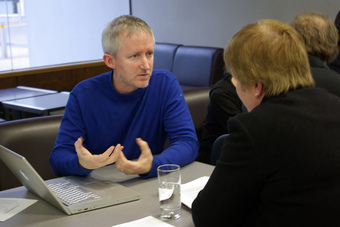
Conducting Your Interview
Be respectful and practice active listening to get the most out of your interview time.
Avoid Leading Questions
Leading questions are questions that suggest or imply a particular answer. While they are often asked innocently, they risk of altering the validity of the responses obtained as they discourage participants from using their own language to express their sentiments. It is instead preferable that interviewers ask open-ended questions. For example, instead of asking “Did the experience make you feel sad?”, it would be better to ask “How did the experience make you feel?” which suggests no particular feeling.
Don’t Interrupt
Participants should feel comfortable and respected throughout the entire interview—thus interviewers should avoid interrupting participants whenever possible. While participants may digress in their responses and while the interviewer may lose interest in what they are saying at one point or another it is critical that they be tactful in their efforts to keep the participant on track and to return to the subject matter in question.
8.4.3: Interview Followup
Content analysis is an essential part of the follow-up, in order to summarize who said what and when.
Learning Objective
Explain how the different interview methods influence content analysis during follow-up
Key Points
- If you have interviewed synchronously one or two experts in person, telephone, or video conference, then you should listen to the recording of the interview and mark points of interest.
- If you have conducted an online synchronous interview using chat, make sure that you have actually activated the archive feature so that you have a recorded transcript of the chat and are able to review each of the questions and responses at a later time.
- If you conducted an online asynchronous interview, you may have a large sample of geographically dispersed respondents. You will need to summarize the content or tabulate the ratings if you used rating scales for the interview questions.
- Once you have completed your content analysis, you will want to consider how to cite or credit the source(s) of the “personal communication” in order to indicate the person, the date, and the type of interview or manner of data collection.
Key Term
- content analysis
-
A methodology in the social sciences for studying the content of communication. Harold Lasswell formulated the core questions of content analysis: “Who says what, to whom, why, to what extent and with what effect? “
Content Analysis is Essential Follow-up
Content analysis is an essential part of the follow-up to any type of interview. You want to summarize or describe the responses and associate them with the source or group of sources, who were the sample of people who responded. You want to summarize who said what, and when. If have engaged in a one-on-one in-person interview, the you will want to use your best informational listening and note-taking skills to capture the content of what was said. If you used an online synchronous or asynchronous interview method, you will already have a transcript or archive of the content, but will need to reliably summarize the responses to your interview questions. The different methods of interviewing will require different methods of follow-up to capture the content and prepare it for use.
In-person Interview
If you have interviewed synchronously one or two experts in person, telephone, or video conference, then you will want to listen to the recording of the interview and mark points of interest . You can either take notes, transcribe relevant answers, or mark with a time stamp the location of important content that relates to your topic for replay or review later.

In-person Interview
Record the interview for playback and analysis.
Online Synchronous Interview
Online synchronous interviews use simple text chat functions that can be recorded or archived for later analysis. If you have conducted an online synchronous interview using chat, make sure you have actually activated the archive feature so that you have a recorded transcript of the chat and are able to review each of the questions and responses at a later time. Since you can chat interview with a number of people about your topic, you may eventually want to summarize and analyze the data for patterns in the responses.
Online Asynchronous Interview
An asynchronous online interview is one where the researcher and the researched do not need to be online at the same time. Typically these interviews will use email, but other technologies might also be employed.
If you conducted an online interview asynchronously, you may have a large sample of geographically dispersed respondents. You will need to summarize the content or tabulate the ratings if you used rating scales for the interview questions.
If you asked closed questions, you can tabulate the frequency of responses in the different categories. However, if you asked more open-ended questions, you will find it useful to code the content of the interviews with some system so that you can group the responses into meaningful categories in order to summarize the results.
Citing the Interview
Once you have completed your content analysis, you will want to consider how to cite or credit the source(s) of the respondents. Since the results of your interview are usually not published, they will be considered “personal communication. ” Generally, you will indicate the person, date, and manner of data collection. Here are some examples:
Personal Interview face to face—Expert , A. (2013, May 2) Personal Interview.
Personal interview by telephone or chat—Expert, A (2013, May 3) Telephone (chat) Interview.
Personal interview by email—Expert, A. ( 2013, May 4) Email Interview.
Chapter 7: Analyzing the Audience
7.1: The Importance of Audience Analysis
7.1.1: The Benefits of Understanding Your Audience
The more you know and understand about the background and needs of your audience, the better you can prepare your speech.
Learning Objective
Explain why it is important to understand your audience prior to delivering a speech
Key Points
- Knowing your audience—their general age, gender, education level, religion, language, culture, and group membership—is the single most important aspect of developing your speech.
- Analyzing your audience will help you discover information that you can use to build common ground between you and the members of your audience.
- A key characteristic in public speaking situations is the unequal distribution of speaking time between the speaker and the audience. This means that the speaker talks more and the audience listens, often without asking questions or responding with any feedback.
Key Terms
- Audience-centered
-
Tailored to an audience. When preparing a message, the speaker analyzes the audience in order to adapt the content and language usage to the level of the listeners.
- audience
-
One or more people within hearing range of some message; for example, a group of people listening to a performance or speech; the crowd attending a stage performance.
- audience analysis
-
A study of the pertinent elements defining the makeup and characteristics of an audience.
Benefits of Understanding Audiences
When you are speaking, you want listeners to understand and respond favorably to what you are saying. An audience is one or more people who come together to listen to the speaker. Audience members may be face to face with the speaker or they may be connected by communication technology such as computers or other media. The audience may be small and private or it may be large and public. A key characteristic of public speaking situations is the unequal distribution of speaking time between speaker and audience. As an example, the speaker usually talks more while the audience listens, often without asking questions or responding with any feedback. In some situations, the audience may ask questions or respond overtly by clapping or making comments.

Understanding the Audience
It’s important to understand the audience and generate a clear message before giving a speech.
Audience-Centered Approach to Speaking
Since there is usually limited communication between the speaker and the audience, there is limited opportunity to go back to explain your meaning either during the speech or afterward. When planning a speech, it is important to know about the audience and to adapt the message to the audience. You want to prepare an audience-centered speech, a speech with a focus on the audience.
In public speaking, you are speaking to and for your audience; thus, understanding the audience is a major part of the speech-making process. In audience-centered speaking, getting to know your target audience is one of the most important tasks that you face. You want to learn about the major demographics of the audience, such as general age, gender, education, religion, and culture, as well as to what groups the audience members belong. Additionally, learning about the values, attitudes, and beliefs of the members of your audience will allow you to anticipate and plan your message.
Finding Common Ground by Taking Perspective
You want to analyze your audience prior to your speech so that during the speech you can create a link between you, the speaker, and the audience. You want to be able to figuratively step inside the minds of audience members to understand the world from their perspectives. Through this process, you can find common ground with your audience, which allows you to align your message with what the audience already knows or believes.
Gathering and Interpreting Information
Audience analysis involves gathering and interpreting information about the recipients of oral, written, or visual communication. There are very simple methods for conducting an audience analysis, such as interviewing a small group about its knowledge or attitudes or using more involved methods of analyzing demographic studies of relevant segments of the population. You may also find it useful to look at sociological studies of different age groups or cultural groups. You might also use a questionnaire or rating scale to collect data about the basic demographic information and opinions of your target audience. These examples do not form an all-inclusive list of methods to analyze your audience, but they can help you obtain a general understanding of how you can learn about your audience. After considering all the known factors, a profile of the intended audience can be created, allowing you to speak in a manner that is understood by the intended audience.
Practical Benefits for the Speaker
Understanding who makes up your target audience will allow you to carefully plan your message and adapt what you say to the level of understanding and background of the listeners. Two practical benefits of conducting an audience analysis are (1) to prevent you from saying the wrong thing, such as telling a joke which offends, and (2) to help you speak to your audience in a language they understand about things that interest them. Your speech will be more successful if you can create a message that informs and engages your audience.
7.1.2: What to Look For
Analyze the audience to find the mix of ages, genders, sexual orientations, educational levels, religions, cultures, ethnicities, and races.
Learning Objective
Examine your audience based on demographics
Key Points
- A speaker should look at his or her own values, beliefs, attitudes, and biases that may influence his or her perception of others.
- Guard against egocentrism. A speaker must not regard his or her own opinions or interests as being the most important or valid.
- Look at others to understand their background, attitudes, and beliefs.
- Focus on audience demographics such as age, gender, sexual orientation, education, religion, and other relevant population characteristics to analyze the audience.
- The depth of the audience analysis depends of the size of the intended audience and the method of delivery.
Key Terms
- egocentrism
-
Preoccupation with one’s own internal world; the belief that one’s own opinions or interests are the most important or valid.
- demographics
-
The characteristics of population such as age, gender, sexual orientation, occupation, education; classification of the characteristics of the people.
Look Inward to Uncover Blinders
A public speaker should turn her mental magnifying glass inward to examine the values, beliefs, attitudes, and biases that may influence her perception of others. The speaker should use this mental picture to look at the audience and view the world from the audience’s perspective. By looking at the audience, the speaker understands their reality.

Magnifying Glass
Speakers should use a metaphorical magnifying glass to examine their values, beliefs, and attitudes.
When the speaker views the audience only through her mental perception, she is likely to engage in egocentrism. Egocentrism is characterized by the preoccupation with one’s own internal world. Egocentrics regard themselves and their own opinions or interests as being the most important or valid. Egocentric people are unable to fully understand or cope with other people’s opinions and a reality that is different from what they are ready to accept.
Understanding Audience Background, Attitudes, and Beliefs
Public speakers must look at who their audience is, their background, attitudes, and beliefs. The speaker should attempt to reach the most accurate and effective analysis of her audience within a reasonable amount of time. For example, speakers can assess the demographics of her audience. Demographics are detailed accounts of human population characteristics and usually rendered as statistical population segments.
For an analysis of audience demographics for a speech, focus on the same characteristics studied in sociology. Audiences and populations comprise groups of people represented by different age groups that:
- Are of the same or mixed genders
- Have experienced the same events
- Have the same or different sexual orientation
- Have different educational attainment
- Participate in different religions
- Represent different cultures, ethnicities, or races
Speakers assess the audience’s attitude – a positive or negative evaluation of people, objects, event, activities, or ideas – toward a specific topic or purpose. The attitudes of the audience may vary from extremely negative to extremely positive, or completely ambivalent. By examining the preexisting beliefs of the audience regarding the speech’s general topic or particular purpose, speakers have the ability to persuade the audience members to buy into the speaker’s argument. This can also help with speech preparation.
Tips for the Speaker
The depth of the audience analysis depends of the size of the intended audience and method of delivery. Speakers use different methods to become familiar with the background, attitudes, and beliefs of audiences in different environments and using various mediums (e.g., videoconferencing, phone, etc). For a small audience, the speaker can simply speak with them in a physical environment. However, the speaker is addressing a larger audience or speaking via teleconferencing or webcasting tools, it may be useful to collect data via surveys or questionnaires.
7.1.3: What to Do with Your Knowledge
Use knowledge about your audience to step into their minds, create an imaginary scenario, and test your ideas.
Learning Objective
Identify with your audience by adopting their perspective
Key Points
- A successful speaker is able to step outside her own perceptual framework to understand the world as it is perceived by members of her audience.
- The speaker engages in a process of first encoding his or her ideas from thoughts into words, then forming a message to be delivered to a group of listeners, or audience. The audience members attempt to decode what the speaker is saying so that they can understand it.
- The better the speaker knows the members of the audience beforehand, the better the speaker can encode a message in a way that the audience can decode successfully.
- One of the most useful strategies for adapting your topic and message to your audience is to use the process of identification to find common ground with them.
- You can use your analysis to create a theoretical, imagined audience of individuals from the diverse backgrounds you have discovered in your audience analysis. Then you can decide whether or not the content will appeal to individuals within that audience.
Key Terms
- Decode
-
to translate the sender’s spoken idea/message into something the receiver understands by using his or her knowledge of language based on personal experience
- encode
-
to turn one’s ideas into spoken language in order to transmit them to listeners
- message
-
the verbal and nonverbal components of language, sent to the receiver by the sender, that convey an idea
Identifying with the listeners
Step in to the minds of your listeners and see if you can identify with them. A successful speaker engages in perspective-taking. While preparing her speech, the speaker steps outside her own perceptual framework to understand the world as it is perceived by members of the audience. When the speaker takes an audience-centered approach to speech preparation, she focuses on the audience and how it will respond to what is being said. In essence, the speaker wants to mentally adopt the perspective of members of the audience in order to see the world as the audience members see it.
Encoding and Decoding
The speaker engages a process of encoding his or her ideas from thoughts into words, and of forming a message which is then delivered to an audience. The audience members then attempt to decode what the speaker is saying so that they can understand it. To better imagine this process, consider the example of encoding and decoding as it applies to the idea of a tree. I know that my audience is in New England and that they are familiar with oak trees. I use the word tree to encode my idea, and because my audience has experienced similar trees, they decode the word tree in the way that I intended. However, I may be thinking about a tree (a palm tree) that is in Hawaii, where I used to live, when I use the word tree to encode my idea. Unfortunately, when my audience decodes my word now, they are still thinking about the oak tree and will not see my palm tree. The audience no longer shares my perspective of the world or my experience with trees.
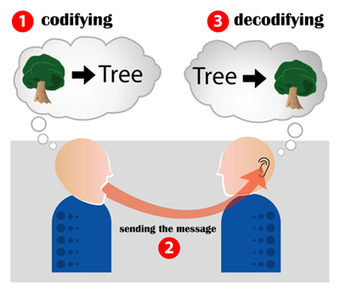
Encoding Communication
One speaker encodes a message and sends the message. The listener hears the message and decodes it.
Finding Common Ground
The more you find out about your audience, the more you can adapt your message to the interests, values, beliefs, and language level of the audience. Once you collect data about your audience, you are ready to summarize your findings and select the language and structure that is best suited to your particular audience. You are on a journey to find common ground in order to identify with your audience. One of the most useful strategies for adapting your topic and message to your audience is to use the process of identification . What do you and your audience have in common? And, conversely, how are you different? What ideas or examples in your speech can your audience identify with?
Creating a Theoretical, Imagined Audience
Create a theoretical, imagined situation to test your view of an audience for practice. You can use your analysis to create what is called a “theoretical, universal audience. ” The universal audience is an imagined audience that serves as a test for the speaker. Imagine in your mind a composite audience that contains individuals from the diverse backgrounds you have discovered in your audience analysis. Next, decide whether or not the content of your speech would appeal to individuals within that audience. What words or examples will the audience understand and what will they not understand? What terms about your subject will you need to define or explain for this audience? How different are the values and opinions you want your audience to accept from the present attitudes and beliefs they may hold?
Tips for the Speaker
In summary, use your knowledge of the audience to adapt your speech accordingly. Adopt the perspective of the audience in order to identify with them, and test out your ideas with an imagined audience composed of people with the background you have discovered through your research.
7.2: Demographic Factors to Consider
7.2.1: Age
Since individuals of the same generation often share similar values, beliefs, and attitudes, age is an important variable to consider.
Learning Objective
Recognize characteristics of different generations
Key Points
- Individuals who grow up at the same time are a generation and often share many of the same experiences as others of the same age group. They exhibit a set of shared values, beliefs, and attitudes that are important to consider when preparing a speech.
- When you speak to an audience with members of different ages, you are likely to experience a generation gap.
- As new generations seek to define themselves as something apart from the old, they adopt new lingo and slang, allowing a generation to create a sense of division from the previous one.
- It is important to become aware of one’s own biases in order to avoid ageism in your speeches.
- The use of handheld communications technology has created a wide gap between older and younger generations.
Key Terms
- Generation
-
Cohorts of people who were born in the same date range and share similar cultural experience.
- ageism
-
Ageism, or age discrimination is stereotyping and discriminating against individuals or groups because of their age. It is a set of beliefs, attitudes, norms, and values used to justify age based prejudice, discrimination, and subordination.
Age is an Important Audience Characteristic
Age is an important variable to consider when analyzing your target audience. Individuals who grow up at the same time are called cultural generations. They often share many of the same experiences as others of the same age group. An outcome of a cultural generation is a set of shared values, beliefs, and attitudes that are important to consider when preparing a speech. All four of the women in the figure are from different generations and will have had different experiences. Of which generation do you think they are a member? To which generation do you belong?

Understanding Different Generations
Each of these four generations has a different set of values, beliefs, and attitudes.
Generations
Consider the generations living today and some of their associated characteristics:
- The Baby Boom generation were born after World War II, from 1946 to 1964. In general, baby boomers are associated with a rejection or redefinition of traditional values. Boomers tended to think of themselves as a special generation, very different from those that had come before them.
- Generation X is the generation defined as those born after the baby boom ended, from 1965 to 1981.Change is more the rule for the people of Generation X than the exception. Unlike their parents, who challenged leaders with an intent to replace them, Gen Xers tend to ignore leaders and work for more long-term institutional and systematic change through economic, media, and consumer actions
- Millennials, also known as Generation Y, describes the generation following Generation X, from 1981 to 1999. One segment of this age group has often been called the “eighties babies” generation. Millennials are generally marked by an increased use and familiarity with communication, media, and digital technologies. In most parts of the world its upbringing was marked by an increase in a neoliberal approach to politics and economics.
- Generation Z, also known as “Digital Natives,” is a term that reflects the pluralistic and fragmented society of those with birth dates between 1997 and 2012. Generation Z is highly connected, as many members of this generation have had lifelong use of communications nd media technologies. No longer limited to the home computer, the Internet is now increasingly carried in their pockets on mobile Internet devices.
- Generation AO, the Always-On Generation (or Gen AO), describes people born between the early 2000s and the 2020s whose lives have been influenced by connectivity and easy access to people and knowledge through the Internet. They are nimble, quick-acting multi-taskers who count on the Internet as their external brain. Experts predict Gen AO will exhibit a thirst for instant gratification and quick fixes, a loss of patience, and a lack of deep-thinking ability.
Generation Gaps and Trends
When you speak to an audience with members of different ages, you are likely to experience a generation gap. Each generation sets its own trends and has its own cultural impact.
- Language Use: Generations can be distinguished by the differences in their language use. The generation gap has created a parallel gap in language that can be difficult to communicate across. As new generations seek to define themselves as something apart from the old, they adopt new lingo and slang, allowing a generation to create a sense of division from the previous one.
- Slang: Slang is an ever-changing set of colloquial words and phrases that speakers use to establish or reinforce social identity or cohesiveness within a group or society at large. As each successive generation of society struggles to establish its own unique identity among its predecessors, generational gaps provide a large influence over the continual change and adaptation of slang.
- Technological Influences: Every generation develops new slang, but with the development of technology, understanding gaps have widened between the older and younger generations. The term “communication skills,” for example, might mean formal writing and speaking abilities to an older worker. But it might mean e-mail and instant messaging to a 20-something. Cell phones, texting, tweeting and the like have encouraged younger users to create their own inventive, quirky, and very private written language. They are more connected than ever, but also far more independent.
7.2.2: Gender
A speaker has an opportunity to address years of masculine and feminine gender role conditioning through the use of inclusive language.
Learning Objective
List the dangers of using gendered language in your speeches
Key Points
- It is important to remember that since birth, we have been conditioned to make the distinction between men and women, masculinity and femininity.
- Advertisers create “gendered environments” in everything from children’s toys to motor vehicles.
- Gender neutral language and gender inclusive language aims to eliminate (or neutralize) reference to gender in terms that describe people.
- One must guard against gender discrimination and stereotyping members of the audience.
Key Terms
- transgender
-
More narrowly, having a gender (identity) which is different from the sex one was assigned at birth, e.g. being assigned male at birth but having a female gender or vice versa; or, pertaining to such people. More broadly, not identifying with culturally conventional gender roles and categories of male or female; having changed gender identity from male to female or female to male, or identifying with elements of both, or having some other gender identity; or, pertaining to such people.
- gender
-
The sociocultural phenomenon of dividing people into the categories of “male” and “female,” with each having associated clothing, roles, stereotypes, etc.
Gender and Genderism
It is important to remember that since birth, we have been conditioned to make the distinction between men and women, masculinity and femininity. Gender is the perceived or projected (self-identified) masculinity or femininity of a person. Societies tend to have binary gender systems in which everyone is categorized as male or female, but this is not universal. Some societies include a third gender role, referred to as transgender, which combined both male and female.
Although there are almost as many males as females in the U.S. population, not all people conform to the their birth sex. Genderism is the cultural belief that gender is binary, or that there are, or should be, only two genders—male and female—and that the aspects of one’s gender are inherently linked to the sex in which they were assigned at birth. It reinforces negative attitudes, bias and discrimination toward people who display expressions of gender variance or nonconformity and/or whose gender identity is incongruent with their birth sex.
Advertisers do,however, create “gendered environments” in everything from children’s toys to motor vehicles . For example, early on children are exposed to toy commercials that are set out to target a specific gender. As a result, western society is conditioned to believe that dolls and houses are for little girls because they represent the idea that females are to be fertile and nurturing. Little boys are conditioned to believe that they can only play with toys that will define their masculinity, such as cars and toy weapons. Much like the masculine ideal, toys for little boys often include cars, action figures , and sporting goods, all which fulfill the idea of a conquest. These items and the advertisements redefine the gender role ideal that men are active, strong, and courageous. On the other hand, little girls are raised to believe that their roles is to care for the family. Typically, little girls toys include baby dolls and play houses. Since the idea of identification carries immense weight in the targeting of specific audiences, advertisers begin promoting the concept of gendered environments early on beginning with children’s toys. However, as people grow older the gender roles are only made more evident and are further perpetuated in advertising that is targeted towards adults.
What can the speaker do?
Use inoffensive language in your speeches.
Cognitive psychologist and linguistics suggest that word choice has significant framing effects on the perceptions, memories, and attitudes of speakers and listeners. When one uses less inclusive or stereotypical language, the following can occur:
- The rights, opportunities, and freedoms of certain people are restricted because they are reduced to stereotypes.
- Stereotyping is mostly implicit, unconscious, and facilitated by the availability of pejorative labels and terms
- Rendering the labels and terms socially unacceptable, people then must consciously think about how they describe someone unlike themselves
- When labeling is a conscious activity, the described person’s individual merits become apparent, rather than their stereotype.
Use Gender Neutral Language in your speeches.
Gender neutral language and gender inclusive language aims to eliminate (or neutralize) reference to gender in terms that describe people. For example, the words fireman, stewardess, and, arguably, chairman, are gender specific; the corresponding gender neutral terms are firefighter, flight attendant and chairperson (or chair). The pronoun “he” may be replaced with “he or she,” “s/he,” or “they” when the gender of the person referred to is unknown. Other gender specific terms, such as actor and actress may be replaced by the originally male term “actor” used for either gender.

Gender-Neutral Language
Gender-neutral language replaces “he” and “she” with “he or she,” “s/he,” or “they.”
Gender-neutral language should not be confused with genderless language, which refers to languages without grammatical gender. It has become common in academic and governmental settings to rely on gender neutral language to convey inclusion of all sexes or genders (gender inclusive language). Various forms of gender neutral language are becoming more common, but the underlying gender roles are still evident in our society. We still have generations of previously defined gender roles and associated language use to conquer.
Tips for the Speaker
One must guard against gender discrimination and stereotyping members of the audience. It is not enough to be politically correct by using inclusive, neutral terminology; one can also explore more fully the gender conditioning that has occurred throughout ones lifetime from childhood to adulthood in order to confront genderism.
7.2.3: Sexual Orientation
The sexual orientation of your audience members should be taken into account when giving a speech.
Learning Objective
Define the three main classifications of sexual orientation: bisexuality, heterosexuality, and homosexuality
Key Points
- There are three main classifications of sexual orientation: bisexuality, heterosexuality and homosexuality, all a part of the heterosexual–homosexual continuum.
- Most sexual orientation specialists follow the general conclusion of Alfred Kinsey regarding the sexual continuum, according to which a minority of humans are exclusively heterosexual or homosexual, and that the majority are bisexual.
- Sexual orientation, in most individuals, is shaped at an early age and is not voluntarily changeable.
- The speaker should become aware of and compensate for the bias of heteronormativity, which holds that people fall into distinct and complementary genders (man and woman) with natural roles in life.
Key Terms
- heteronormativity
-
The view that all human beings are either male or female, both in sex and in gender, and that sexual and romantic thoughts and relations are normal only when between people of different sexes.
- heterosexism
-
A system of attitudes, bias, and discrimination in favor of opposite-sex sexuality and relationships. It can include the presumption that everyone is heterosexual or that opposite-sex attractions and relationships are the only norm and therefore superior.
Sexual Orientation
On a Continuum from Hetrosexual to Homosexual
When taking into account the sexual orientation of your audience it is useful to consider it on a continuum. Your audience could be made up of members anywhere along the continuum. There are three main classifications of sexual orientation: heterosexuality, bisexuality, and homosexuality.
Hetrosexuality
Heterosexuality is romantic or sexual attraction or behavior between persons of the opposite sex. As a sexual orientation, heterosexuality refers to “an enduring pattern of or disposition to experience sexual, affectionate, physical, or romantic attractions to persons of the opposite sex. ” It also refers to “an individual’s sense of personal and social identity based on those attractions, behaviors expressing them, and membership in a community of others who share them. ” The term is usually applied to humans, but is also observed in all mammals.
Homosexuality
The term “gay” in the West is not recognized by all men who have sex with men (MSM) as known in the rest of the world. “Gay” is generally used to describe a sexual orientation, while “MSM” describes a behavior. Also, men in Africa and Latin America engage in sexual relationships with other men while still referring to themselves as heterosexual, which is known as being “on the down-low. ” The same applies to men who engage in homosexual activities in the military, gender segregated schools and universities, or prison, as most of them do not consider themselves as gay but still engage sexually with members of their own sex in order to fulfill their sexual desires.
Correspondingly, “lesbian” as a concept, used to differentiate women with a shared sexual orientation, is a 20th-century construct. Throughout history, women have not had the freedom or independence to pursue homosexual relationships as men have, but neither have they met the harsh punishment in some societies as homosexual men. Instead, lesbian relationships have often been regarded as harmless and incomparable to heterosexual ones unless the participants attempt to assert privileges traditionally enjoyed by men. Women who have sex with women (WSW) is a term used to identify women who engage in sexual activities with other women, whether or not they identify themselves as lesbian or bisexual. The term is often used in medical literature to describe such women as a group for clinical study, without needing to consider the issues of sexual self-identity.
Bisexuality
A third orientation is bisexuality. Bisexuality is a romantic or sexual attraction or behavior toward both males and females. The term is especially used in the context of human sexual attraction to denote romantic or sexual feelings toward men and women. People who have a distinct but not exclusive sexual preference for one sex over the other may identify themselves as bisexual. Bisexuality has been observed in various human societies and elsewhere in the animal kingdom throughout recorded history. The term bisexuality, like the terms hetero- and homosexuality, was coined in the 19th century.
Most sexual orientation specialists follow the general conclusion of Alfred Kinsey regarding the sexual continuum, according to which a minority of humans are exclusively heterosexual or homosexual, and that the majority are bisexual. The consensus of psychologists is that sexual orientation, in most individuals, is shaped at an early age and is not voluntarily changeable.
The rainbow colors and the rainbow flag , once only used by the LGBTQ community in major cities of the West, is now appearing around the world to show solidarity with or acceptance of the LGBTQ community.

Rainbow Flag
A rainbow flag flying above New York.
Become Aware of Bias—Heteronormativity and Heterosexism
Speakers should be aware of the bias in the audience and in Western society in general toward heteronormativity and heterosexism. One common mistake that speakers make is assuming that the audience is just like them with regards to this aspect of identity.
Heteronormativity is the body of lifestyle norms that holds that people fall into distinct and complementary genders (man and woman) with natural roles in life. It also holds that heterosexuality is the normal sexual orientation, and that sexual and marital relations are most (or only) fitting between a man and a woman. A “heteronormative” view is one that involves alignment of biological sex, sexuality, gender identity, and gender roles.
Heterosexism is a system of attitudes, bias, and discrimination in favor of opposite-sex sexuality and relationships. It can include the presumption that everyone is heterosexual or that opposite-sex attractions and relationships are the only norm and therefore superior. Nonetheless, heterosexism as discrimination ranks gay men, lesbians, bisexuals, and other sexual minorities as second-class citizens with regard to various legal and civil rights, economic opportunities, and social equality in the majority of the world’s jurisdictions and societies.
Tips for the Speaker
Consider how to combat heterosexism in your audience analysis and speech making. For example, rather than referring to or asking in an interview if one has a boyfriend or girlfriend, you can ask if the person is seeing someone or has a significant relationship. One can also use the term “partners” rather than the more heteronormative “husband” or “wife. ” And remember that families come in all different kinds of formations, not just biological male and female birth parents with their child.
Finally, there may be many speech topics where the sexual orientation of the audience will not be an important consideration. However, there are some areas which are important to LGBTQ people, such as laws around the world that criminalize homosexual behavior, recognition of relationships, same-sex marriage, LGBTQ adoption, immigration issues, violence and hate crimes, and legal aspects of transsexualism.
7.2.4: Education
Consider both the formal education and the self-directed learning of the members of your audience to adapt your speech content.
Learning Objective
Demonstrate how knowing your audience’s knowledge of your topic can inform your speech
Key Points
- As your prepare your speech, ask yourself what do the members of the audience already know about the topic.
- Do not assume that your audience will know something just because you do.
- Look for audience cues (i.e. the questions they ask) to identify knowledge gaps.
- Remember it is important to consider not only the formal education but the self-directed learning of the members of your audience in order to gear you speech to right level of understanding.
Key Terms
- knowledge
-
Familiarity or understanding of a particular skill, branch of learning, etc.
- education
-
Facts, skills, and ideas that have been learned, either formally or informally.
Introduction
As you prepare your speech, first ask yourself what the members of the audience already know about the topic. What is their level of knowledge and are they able to learn more? Remember, it is important to consider not only the formal education but the self-directed learning of audience members in order to gear you speech to the right level of understanding.
To see the importance, here is an example provided by Lewis.
Lewis’ Story
I enjoy learning new things and I love sharing what I know. Or, more accurately, I love sharing what I think I know. If I can learn something while I’m sharing, that’s a total bonus. A totally uneventful presentation can be relaxing but I kind of like to keep it edgy, learn something from the process. Not so much a projector exploding right before I present but things that make me stretch. Being a good presenter is a personal goal for me. Part of creating a good presentation is knowing your audience and aiming the material right between their eyes.
I was giving a presentation recently. It was a presentation for work. I had given a general purpose “What is a data mart? ” presentation last year and this was Part Two, digging into our financial transactions data mart. I was specifically going over the mart’s facts and dimensions. One of the requests for the presentation was to explain how to efficiently query the data and an overview of why our data mart (specifically this star schema) might be faster than other styles of design.
I started with a refresher: what is a fact, what is a dimension; and then segued into the facts and dimensions specific to our mart. I spoke a little bit about what we had and why we chose those particular entities. I then moved onto the performance benefits. I spent quite a bit of time explaining bitmap indexes and star transformations. I really thought that was where most of my questions would be. The fascinating thing to me is where the discussion ended up. It wasn’t a failure to understand bitmaps (I credit my awesome diagram for that) nor was it anything confusing about star transformations.
On a couple of slides I had mentioned “query rewrite” in relation to tuning (using aggregates) and star transformations. What I learned is that something that has become second nature to me might not be to many other people. The fact that Oracle would rewrite my query at runtime used to really scare me. After seeing the magic (which is what it felt like at first), I got used to it and have come to expect it (in the right situations).
But my audience was sitting there wondering, “What does query rewrite mean? ” Some thought that it meant the developer did not write it correctly the first time so Oracle was recommending that it be rewritten as a star transformation (or to go against a materialized view instead of a base table).
That is such an obvious misconception that I can’t believe I didn’t even anticipate it at all. The questions and comments I got on that drove a nice discussion. One of the questions was, “Would someone be monitoring the rewrites so that it could be done better next time? ” It took me a while to understand the question; I literally was not understanding the disconnect for a few minutes. It’s a good question, based on the audience’s understanding at the time that I gave them more information.
The problem was not with the audience, it was my failure to make sure that my presentation gave a basic explanation of the terms I would be using. I learning that it is important to “know thy audience. ” Data marts were new to most of this group. That’s why I took the time to define a fact, a dimension, bitmap indexes, star schemas, star joins, etc. Query rewrite (basic, advanced) is such a fundamental part of what I was explaining, I totally glossed over it. It’s like explaining why the sidewalk is hard but not giving a definition of concrete.
I finally explained that Oracle was rewriting it based on data (statistics) it had at runtime, on knowledge of the structures in the database, and on algorithms that know how to optimize very certain types of queries to get the best throughput from them.
What Lewis Learned

Education
The audience’s education goes beyond whether or not they have a degree or what that degree might be in.
It reminded me to remember that I need to look at my presentation from the view of someone sitting in the audience, not the view on the
podium
. This is a lesson for you, too. Knowing what your audience knows is key to giving a good presentation.
7.2.5: Religion
Understanding the religions in your audience will help you relate to the members and avoid excluding members of differing religions.
Learning Objective
Identify the world’s religions and speak with sensitivity to religious beliefs
Key Points
- Individuals who practice a religion have belief systems and worldviews that relate humanity to spirituality and moral values.
- Since the First Amendment of the U.S. Constitution allows the existence of religious pluralism in the U.S., you are likely to encounter audience members of different religions.
- There are roughly 4,200 religions in the world. The five largest religious groups by population are Christianity, Islam, Buddhism, Hinduism and Chinese folk religion.
- Understanding the religions in your audience will help you relate to members of the audience more directly and avoid excluding members who may not observe the same practices as you do.
Key Terms
- religion
-
Religion is a collection of belief systems, cultural systems, and worldviews that relate humanity to spirituality and, sometimes, to moral values.
- irreligious
-
Irreligious describes an absence of any religion; where as anti-religion describes an active opposition or aversion toward religions in general.
- religious pluralism
-
The peaceful coexistence of multiple religions in a community
Example
- Symbols representing some world religions, from left to right: row 1: Christianity, Judaism, Hinduism row 2: Islam, Buddhism, Shinto row 3: Sikhism, Bahá’í Faith, Jainism
Religion
Individuals who practice a religion have belief systems and worldviews that relate humanity to spirituality and moral values. According to some estimates, there are roughly 4,200 religions in the world. The members of your audience could be followers of any of those religions.
Religions may involve the worship of a god or gods or a spiritual force. Many religions have days of observance, narratives, symbols, traditions, and sacred histories that are intended to give meaning to life or a preferred lifestyle from their ideas about the cosmos and human nature .
The five largest religious groups by population, estimated to account for between 5 and 7 billion people, are Christianity, Islam, Buddhism, Hinduism, and Chinese folk religion.

Religious Symbols
Religious symbols represent different belief systems.
Five largest religions……………………..Adherents in 2000……………………..% of world population
Christianity………………………………………. 2.0 billion……………………………………….. 33%
Islam………………………………………………. 1.2 billion………………………………………. 19.6%
Hinduism………………………………………… 811 million……………………………………… 13.4%
Chinese Folk religion……………………….. 385 million……………………………………….. 6.4%
Buddhism……………………………………….. 360 million……………………………………….. 5.9%
Additionally, there are may be atheist and agnostics in your audience. The terms “atheist” (lack of belief in any gods) and “agnostic” (belief in the unknowability of the existence of gods), though specifically contrary to theistic (e.g. Christian, Jewish, and Muslim) religious teachings, do not by definition mean the opposite of “religious. ” There are religions (including Buddhism and Taoism) that classify some of their followers as agnostic, atheistic, or nontheistic. The true opposite of “religious” is “irreligious. “
Since the First Amendment to the U.S. Constitution guarantees the separation of church and state, the U.S. has no dominant state religion. People with different beliefs are free to practice their religion in the U.S. or to practice no religion.
Tips for the Speaker
Unless you are speaking to a particular religious group, you are likely to encounter audience members from several of the world’s religions in your audience. Understanding the religions in your audience will help you relate better to members of the audience and avoid excluding members who may not observe the same practices as you do. It is important to avoid subtle religious discrimination when speaking to a general audience. Often it will be necessary for you to put aside your own belief system to understand the religion of the members of the audience. Of course, you not required to accept or embrace other religions but simply to be aware of and sensitive to them.
7.2.6: Culture, Ethnicity, and Race
As society becomes more diverse, the speaker will find it useful to learn more about the cultures, races and ethnic groups in each audience.
Learning Objective
Give examples of ethnocentrism and prejudice
Key Points
- The simplest way to think about culture is to think about the distinction between nature (our biology and genetics) and nurture (our environment and surroundings that also shape our identities).
- In terms of race an individual is usually externally classified (meaning someone else makes the classification) but individual may also self-identify with a particular racial group.
- Unlike race, ethnicity is not usually externally assigned by other individuals. The term ethnicity focuses more upon a group’s connection to a perceived shared past and culture.
- The cultural, racial and ethnic makeup of the United States is becoming more diversified and audiences will reflect that diversity as the population continues to shift.
- In order to adapt the message to the audience it is important to become aware of one’s own ethnocentrism and to avoid prejudice and racism.
Key Terms
- ethnicity
-
characteristics of a group of people thought to have common ancestry who share a distinctive culture
- ethnocentrism
-
judging another culture solely by the values and standards of one’s own culture
- race
-
A large group of people distinguished from others on the basis of common physical characteristics, such as skin color or hair type.
Culture, Race and Ethnicity
In addition to considering the attitudes of the audience toward different cultures, races or ethnic groups, it is also important to consider how a diverse group will respond to certain parts of your message . Before considering the role of culture, race and ethnicity in audience analysis it is useful to distinguish among the terms.
Culture
Culture is the non-biological or social aspects of human life; basically anything that is learned by humans is part of culture.
Let’s look at the two avatars shown in to help illustrate the concept of culture.The avatar wearing nothing but shorts comes close to representing nothing but nature. The avatar wearing the colorful vest and pants stands in stark contrast to the other avatar. This second avatar is reflective of a particular culture. Culture is more than the object or behavior. Culture also includes, norms, values, beliefs, or expressive symbols.

Culture
Culture influences many aspect in a person’s life including values, beliefs, and forms of personal expression.
Race and Ethnicity
A race is a human population that is believed to be distinct in some way from other humans based on real or imagined physical differences. An individual is usually externally classified (meaning someone else makes the classification) but individual may also self-identify with a particular racial group.
Ethnicity, while related to race, refers not to physical characteristics but to social traits that are shared by a human population. Some of the social traits often used for ethnic classification include:
- nationality
- tribe
- religious faith
- shared language
- shared culture
- shared traditions
Tips for Speaker-Becoming Aware of Ethnocentrism and Prejudice
In order to adapt the message to the audience it is important to become aware of your own ethnocentrism and to avoid prejudice and racism. When you judge another culture solely by the values and standards of your own culture you miss significant aspects of the other culture of the members of your audience. Racism or racial discrimination operates in a similar way. Racism can refer to any or all of the following beliefs and behaviors:
- race is the primary determinant of human capacities (prejudice or bias)
- a certain race is inherently superior or inferior to others (prejudice or bias)
- individuals should be treated differently according to their racial classification (prejudice or bias)
- actually treating of individuals differently based on their racial classification (discrimination)
In order for the speaker to collect objective knowledge about other cultures, racial or ethnic groups it is important to avoid prejudice. Prejudice involves coming to a judgment on a subject before learning where the preponderance of evidence actually lies. Alternatively, prejudice can refer to the formation of a judgment without direct or actual experience.
When looking at another culture or ethnic group in order to compensate for ethnocentrism as a speaker, try to look at the other group through the eyes of the members of that particular ethnic or cultural group. As our society becomes more diverse, the speaker will find it desirable to put aside ethnocentrism and prejudice to learn more about the cultures, races and ethnic groups that will be an increasing part of the local and global audience.
7.2.7: Group Membership
Audience members who belong to the same group are likely to share values, beliefs, and attitudes with other members of the group.
Learning Objective
Apply your knowledge of your audience’s group affiliation
Key Points
- Foreknowledge of the audience’s affiliations and the associated values, beliefs, and attitudes will help the speaker prepare the message.
- Group members can classify their membership in two categories: primary (family or fraternal organizations) and secondary (clubs, associations, or colleges).
- Generally speaking the longer and more actively one is involved with a group the more likely the member is to share ideas and profess beliefs shared by other group members.
Key Terms
- primary group
-
A small social group whose members share personal and lasting relationships. The family is the most important primary group.
- Secondary group
-
A large group involving formal and institutional relationships. Secondary relationships involve weak emotional ties and little personal knowledge of one another.
Example
- Family is the most important primary group.
Primary and Secondary Group Membership
The members of your audience may be from different groups or they may all be part of the same group. Group membership describes an association with two or more people.
In general, one can look at two types of groups—primary and secondary.
Primary
Primary group membership shapes the attitudes, values, and beliefs of its members; the members are likely to reflect or express those when listening to a speaker.
Audience members who are part of a primary group that is more long lasting will share experiences with the other group members who shape their beliefs, attitudes, and world views. Also, one may have to agree to a set of norms or values which are shared by all members in order to become a member of a group. Some group memberships involved selection by other group members and initiation into the group.
Secondary
Secondary groups, in contrast to primary groups, are large groups involving formal and institutional relationships. Secondary relationships involve weak emotional ties and little personal knowledge of one another. Most secondary groups are short term, beginning and ending without particular significance. They may last for years or may disband after a short time. The formation of primary groups happens within secondary groups.
Primary groups can be present in secondary settings. For example, when you are attending a university you are part of a secondary group at a student activity; while at the university you may form friendships or relationships that will last a lifetime, which would be a primary group .

Different Groups
A primary group of students is broken down into secondary groups based on the color of their t-shirts.
Generally speaking, the longer and more actively one is involved with a group the more likely the member is to share ideas and profess beliefs shared by other group members. For example, members of a college club may share only an interest in a particular sport or activity, whereas members of a fraternity or sorority may be more involved by living together like a family and professing similar attitudes and beliefs.
Tips for Speaker
Foreknowledge of the audience’s affiliations and the associated values, beliefs, and attitudes will help the speaker prepare the message. You may be speaking to members who are all part of the same group, such as an on-campus sobriety or DeMolay; the members of the two groups will have different shared background experiences and beliefs based on their membership in that group.
7.3: Contextual Factors to Consider
7.3.1: Physical Context
Consider physical contexts—traditional face-to-face with co-located audience versus delivery via videoconference to remote audience(s).
Learning Objective
Identify the types of physical context you may encounter and plan your speech accordingly
Key Points
- Consider three possible contexts—traditional speaker face-to-face audience, and computer mediated—speaker with live audience to remote locations(s) and a speaker with no live audience to different locations by video conferencing technology.
- The physical context for the co-located audience is the setting or room where you speak. Ask whether you are indoors or outdoor, the size and arrangement of the seating, the significance of the location and occasion, the time of day for the speech and what equipment is available.
- Checking out the physical context will allow you to adjust your speech and plan so you are not attempting to borrow or move equipment before getting up to speak.
- Speakers may use a videoconferencing system—with video camera or webcam with microphone for input, output through monitor or TV with speakers or headset, internet or digital telephone connection for data transfer and computer for processing—to speak to remote audiences.
- Non-portable videoconferencing is used in large rooms or dedicated conferencing rooms with all required components packaged into an equipment console and portable systems are used for audiences in meeting rooms and for video seminars with webcam, microphone, computer and internet connection.
- With video conferencing delivery the speaker is challenged to maintain eye contact, become familiar with his own image to address appearance consciousness and avoid rapid gestures in consideration of streaming lag time.
Key Term
- co-located
-
To locate or be located at the same site, for two things or groups at same space.
The physical context is the setting where the speech occurs. You can prepare for three different contexts–face to face with co-located audience , a speaker with live audience to remote audiences and a speaker with no live audience to different remote locations by video conferencing technology .

Co-Located Audience
An audience listens to a speaker in an auditorium at the University of Liège.
Physical Context for the Co-Located Audience
The physical context for the co-located audience is the setting or room where you speak. There are a number of questions to consider about the space. Here is a checklist:
- What is the size of the room or other area?
- If outdoors, where is the location, what is the weather, temperature, and noise?
- Is there any significance to the location such as a historic landmark or memorial?
- Is this a special occasion such as holiday celebration or anniversary of an event at the site?
- What is the anticipated size of the audience and the arrangement of seating?
- Will there be a stage, podium or lectern?
- What equipment is available such as microphone, computer, or projection system?
- Will there be an ethernet or wi-fi connection?
- What time of the day will your speech occur, will the audience be awake, or sleepy after eating?
If you are not the only speaker, you want to confirm the order of speaking with the emcee so you know where and when you can get access to any equipment needed for your presentation. Checking out the physical context will allow you to plan so you are not attempting to borrow or move equipment before getting up to speak.
Physical Context for the Combined Co-Located with One or More Secondary Locations
You may find yourself speaking in one primary location with the audio or video of your speech being streamed live to other secondary locations. You will be aware of your primary location but you will not know what is happening in the other locations. When you have a live audience co-located in front of you it will be easier to relate to and respond to the audience and avoid many of the problems associated with delivery by webcam or web conferencing only technology.
Physical Context when Speaking to Remote Locations by Video Conferencing Technology
With video conferencing you deliver a message to two or more locations by computer mediated communication. You may deliver the speech to another location with no interaction or you may engage in two way interaction with the different locations. In order to video conference you will need access to the basic components:

Remote Audience
Rear Adm. J. Kevin Moran, the commander at the Naval Personnel Development Command (NPDC) in Norfolk, Virginia, speaks by video conference to an audience at the Center for Aviation Technical Training (CNATT).
- Video input: video camera or webcam
- Video output: computer monitor, television or projector for the audience
- Audio input for the speaker: microphones, CD/DVD player, cassette player, or any other source of PreAmp audio outlet
- Audio output for the audience: usually loudspeakers connected with the display monitor or TV
- Data transfer: analog or digital telephone network, LAN or Internet
- Computer: a data processing unit that ties together the other components, does the compressing and decompressing, and initiates and maintains the data linkage via the network.
There are basically two kinds of videoconferencing systems which you may encounter:
- Non-portable are used for large rooms or small dedicated conferencing rooms. They have all required components packaged into a single equipment console.
- Portable systems are available for use with small audiences in small meeting rooms and for video seminars. You can create your own simple system with webcam, microphone, headset or speakers. You can now deliver the message using a broadband internet connection to a small group audience at minimal or no cost.
Since you do not have a live audience in front of you while speaking in this context, there are several issues to address:
- Eye contact: Eye contact plays a large role in large and small group communication. Many video conferencing systems give the impression that the speaker is avoiding eye contact. You may find it necessary to practice with the camera and study how eye contact will be perceived by the remote audience and adjust accordingly.
- Appearance consciousness: A second psychological problem with videoconferencing is being on camera, with the video stream possibly even being recorded. The anxiety may be similar to stage fright but there is a difference since you really do not know how the remote listeners are reacting to you. Check out how you appear by recording a sample of your speech and viewing it to adjust to being “on camera. “
- Signal latency: An increased latency (time lag) larger than about 150–300 ms becomes noticeable and is soon observed as unnatural and distracting. With high bandwidth systems, the latency problem is minimized but you are still well advised to minimize quick moves and rapid gestures while speaking, since some audience members may have slower connections.
7.3.2: Overall Psychology of Your Audience: Values, Beliefs, Attitudes, and Needs
Use psychographics of values, needs, attitudes, and beliefs to develop an audience profile and to tailor the speech’s specific message.
Learning Objective
Examine your audience’s values, needs, attitudes, and beliefs to cater your speech to their particular profile
Key Points
- Look at the psychology of the individual audience members to determine how they might respond as a group to the speech’s ideas.
- The overall psychographic of the audience includes the current state of values, beliefs, attitudes, and needs, and is not concerned with how the person developed them.
- Use knowledge of the values, attitudes, beliefs, and needs of members of your audience to develop and describe a psychographic profile in order to tailor a message specifically to the audience.
Key Term
- psychographics
-
The study of personality, values, attitudes, interests, and lifestyles; not to be confused with demographic variables such as age and gender
Psychographics of a Given Audience
The demographics of the audience gives the speaker one type of picture based on variables such as age, gender, sexual orientation, religion, culture, race, and ethnicity; however, there is another equally important picture based on the overall psychological make-up of the audience, or the psychographics of the audience. Psychographics can be used to describe and develop a profile of the individuals in a given audience. Speakers can also use psychographics to select an audience that meets a certain profile, and then tailor a message specifically to that profile.
Psychology is commonly defined as the science of behavior and mental processes. The speaker can look at the psychology of the individual audience members to determine how they might respond as a group to his or her ideas. The speaker wants to look at the current state of values, beliefs, attitudes, and needs, and not consider how the person developed them.
What is the current disposition of the audience toward the speech’s topic and purpose? If the speaker is attempting to persuade the audience to accept a particular idea or take an action, it is important to understand the starting point. What are the dominant values, beliefs, attitudes, and needs of the audience? The speaker must know how to use that knowledge to tailor the speech to the audience. Consider values, beliefs, attitudes, and needs as factors in the psychological make-up of the audience.
Values
Values can be defined as broad preferences concerning appropriate courses of action or outcomes. As such, values reflect a person’s sense of right and wrong or what “ought” to be. “Equal rights for all”, “Excellence deserves admiration”, and “People should be treated with respect and dignity” are statements of values. Values tend to influence attitudes and behavior. For example, if someone who values equal rights for all goes to work for an organization that treats its managers much better than it does its workers, he or she may form the attitude that the company is an unfair place to work; consequently, this person may not produce well or may perhaps leave the company. It is likely that if the company had a more egalitarian policy, his or her attitude and behaviors would have been more positive.
Something that the speaker perceives as good may not be perceived as very good by members of the audience. Something that the speaker perceives as beautiful may not appear the same to the audience. A course of action that the speaker believes is right may not be endorsed by the audience. It is important to consider what the audience values as part of the overall psychological make up of the audience.
Beliefs
The speaker should consider how close the audience’s beliefs in something or someone or about the world, both physical and spiritual, are to his or her own beliefs. Members of the audience may believe that certain things exist or certain ideas are true. The speaker should attempt to identify and build upon shared beliefs to get the audience to consider or accept a particular belief which may be different from the ones they hold. The speaker can often build upon shared beliefs to establish common ground with the audience before advancing a new idea.
Attitudes
Attitudes can play a very important role in speech preparation. An attitude is a positive or negative evaluation of people, objects, event, activities, ideas, or just about anything in the environment. If the speaker knows the audience’s attitude toward the topic or thesis before the speech, he or she can make sure to address these attitudes during the speech preparation. Some ways to find out the audience’s attitude beforehand include rating scales or direct statements from audience members.
Needs
If members of the audience need certain things either physically or psychologically, the speaker should consider how to satisfy those needs. One classical breakdown of needs is Maslow’s hierarchy of needs. If the speak understands where the members of the audience are on Maslow’s hierarchy, he or she can show how his or her ideas help the audience satisfy those needs.
7.3.3: Audience Opinion of You and Your Topic
Examine favorability in relation to how the audience views both you and the topic for your speech.
Learning Objective
Examine the favorability of your audience toward you and your topic
Key Points
- Your audience is likely to have an opinion about you prior to the speech. What is your favorability rating with your audience?
- To find favorability ratings about national topics, look at opinion polls on the attitudes of large group of people that may represent or include your audience.
- To find favorability ratings about local community topics, conduct a survey with your audience or informally mine online data for negative and positive sentiments among your social media friends and followers,who may be similar to your audience.
Key Term
- favorability
-
The quality or degree of being viewed favorably
The favorability of a speaker can be considered in relation both to the speaker and to the topic.
Favorability of the Speaker
National opinion polls are conducted regularly to report on the favorability of celebrities and politicians. For example, in 2012 regular reports were created based on changes in favorable and unfavorable ratings for Mitt Romney and Barack Obama. Pollsters used surveys to sample the nation to determine how people rated the candidates on a number of different questions, and reported the favorabilty of Mitt Romney and Barack Obama as it changed based on the survey results.
You may not be a prominent speaker or politician who is the focus of opinion polls, but your audience is likely to have an opinion about you prior to the speech. Quintilian, a classical rhetorician, insists that the speaker is “a good man speaking well. ” The speaker should strive to be a morally and ethically good man or woman, and strive to be viewed by other as such.
When preparing your speech, consider how your audience might rate you. Do you need to do “damage” control or repair your reputation before or while you are speaking? What is your favorability rating with your audience? How many thumbs up would you get from your audience?

Facebook Thumbs Up Icon
The thumbs up icon is used on Facebook to indicate that a reader likes the content.
Favorability toward Topic
You will also notice that opinion pollsters report on the attitudes of large group of people about different topics of national interest. For example, consider Congress or particular pieces of legislation such as health care. Does Congress have a high favorability rating? What is the favorability rating for the Health Care Act? The overall favorability rating may be good nationally, and better in some regions than others, but bad particularly among members of the Republican Party in the Congress. If you are speaking about a topic that is currently popular with the media, you are likely to find different opinion polls to assist you.
If your topic is more local and personal, you may want to collect your own data. You can conduct a simple survey with rating scales to find out exactly how your audience views the topic or thesis for your speech. You might also want to informally data mine by checking your followers or friends who may be similar to your audience; how many “likes” are expressed?
7.3.4: Knowledge of the Audience About Your Topic
Consider the knowledegeabilty of your audience, prior to the speech, formative during the speech, and summative after the speech.
Learning Objective
Define the three types of knowledgeability: prior, formative, and summative
Key Points
- Discovering knowledgeability, the state or condition of possessing knowledge, involves careful assessment by the speaker prior to, during and after the speech.
- Assess prior knowledge (what your audience already knows) so that you can adjust your content. Ask yourself: How much does my audience already know about my topic? Where do you start you explanation?
- Assess formative knowledge (knowledge forming in the mind of the audience during the speech) to adjust what you are saying. . If your audience is confused, try again to explain what you were saying in different words or with better supporting examples.
- Assess summative knowledge at the end of or after your presentation to find out what your audience knows or beliefs after your speech.
Key Terms
- summative
-
Of, pertaining to, or produced by summation. The adding up of what has been learned or what knowledge has been acquired at the end of lesson or presentation.
- formative
-
Of or pertaining to the formation and subsequent growth of something. acquired.
- knowledge
-
Familiarity or understanding of a particular skill, branch of learning, etc.
Discovering Three Types of Knowledgeability
Discovering knowledgeability, the state or condition of possessing knowledge, involves careful assessment of the audience by the speaker prior to, during, and after the speech. The speaker wants to think about and contemplate the world of the audience to understand what they know.

Knowledge
A speaker must consider the level of the audience’s knowledge when preparing a speech.
Knowledge is a familiarity with someone or something, which can include facts, information, descriptions, or skills acquired through experience or education. It can refer to the theoretical or practical understanding of a subject. It can be implicit (as with practical skill or expertise) or explicit (as with the theoretical understanding of a subject); it can also be more or less formal or systematic. In this case, knowledgeability is the condition or state of knowing by the members of the audience. The audience may know more about one topic and less about another. The types of knowledge are also different–the audience may know about something but not know how to use the know to actually do something.
There are at least three types of knowledgeability: Prior, formative, and summative. To distinguish the three one might think about a cook. A cook gathers the ingredients (prior), tastes the soup while it is cooking (formative), and lets the diner judge it at the end (summative).
Prior Knowledge
Prior knowledge is the knowledge that the audience already has about your topic. If your idea or concept is unfamiliar to the audience you may assume that they know nothing and start from the very beginning. However, you may want to “pre-assess” your audience to see how much they know so that you can adjust your content to the level of understanding. Where do you start you explanation? How much does your audience already know about about your topic? You don’t want to explain things that everyone already knows about and bore most of the audience, yet at the same time you want to make sure that everyone does understand your ideas. You want the audience to leave with an understanding which was greater than when they walked into the room or turned on their computer to listen to your speech.
Formative Knowledge
Formative knowledge is the knowledge that is forming in the mind of the audience during the speech. It is the what the audience is learning (or not learning) during your speech. You may assess understanding with a simple question and answer session or you may find it useful to use an Audience Response System at different points in the speech to ask the audience short, quick questions to see where they are at that point. If you see confused looks on the faces of audience members or turning to neighbors with questions, you know that you need to try again to explain what you were saying in different words or with better supporting examples.
Summative Knowledge
Summative knowledge is the knowledge that the audience leaves with after your speech. What is the level of understanding at the end of your speech? Do they know more or can they do something which they could not do before the speech? Again you may ask the audience to complete a short questionnaire at the end or use an Audience Response System with automatic result tabulation to see how the audience has changed.
7.4: Adapting to Your Audience
7.4.1: Solicit Information
Use direct observation of small audiences and use interviews, surveys and Likert rating scales to collect data about larger audiences.
Learning Objective
Analyze your audience using direct observation, interviews, surveys, or Likert rating scales
Key Points
- Use direct observation of members of the potential audience to find out about them and collect data through interviews,surveys and rating scales for opinions.
- Direct observation allows you to get to know the members of the audience personally by using your own senses such as hearing, sight and perhaps smell.
- An interview is a conversation between two people (the interviewer and the interviewee) for obtaining information by asking open, closed, mirror and probing questions.
- The basic questionnaire is a survey consisting of a series of questions and other prompts for the purpose of gathering information from respondents in your audience.
- Use a Likert-type rating scale of attitudes to find out how strongly the audience agrees or disagrees with your thesis. For example, Public Speaking is my favorite subject. (Circle one) 1.Strongly disagree 2.Disagree 3.Neither agree nor disagree 4.Agree 5.Strongly agree.
Key Terms
- Computer-assisted web interviewing
-
An Internet surveying technique in which the interviewer follows a script provided in a website. The questionnaires are made in a program for creating web interviews. The program is able to customize the flow of the questionnaire based on the answers provided, as well as information already known about the participant.
- Rating scale
-
A rating scale is a set of categories designed to elicit information about an attribute. In the social sciences, common examples are the Likert scale and 1-10 rating scales in which a person selects the number which is considered to reflect the perceived quality of a product.
- Questionnaire
-
A questionnaire is a type of survey consisting of a series of questions and other prompts for the purpose of gathering information from respondents.
Collecting Information about Your Particular Audience
So how do you go about collecting information about your particular audience? There are several useful methods to consider, including: (1) direct observation of members of the potential audience, and (2) data collection through interviews surveys and rating scales for opinions.
Direct Observation
Direct observation allows you to get to know the members of your audience personally. You are making observations of audience members through your own senses such as hearing, sight and perhaps smell. You can employ this method in a classroom or small group situation through conversations with others and by listening to what they say.
However, you will want to guard against introducing your own egocentric biases into the observation. Our human senses do not function like a video camcorder, impartially recording all observations. Thus two people can view the same audience and come away with entirely different perceptions of it, even disagreeing about simple facts. This is why eyewitness testimony is notoriously unreliable.
Interviews, Surveys and Rating Scales
INTERVIEWING
An interview is a conversation between two people–the interviewer and the interviewee –that involves asking questions to obtain information. Generally, you will be using the four different types of questions which follow:
- Open-ended questions. Questions that ask who, what, where, when, why, and how are generally good open-ended questions. An open-ended question requires the respondent to reply with more information than a “yes” or “no” answer. For example, “Tell me about what kind of music you listen to,” will probably get you a lot more information than “Do you like to listen to death metal? ” This will only require “yes” or “no. “
- Closed questions. When you need a “yes” or “no” answer or when you want the other person to provide you with a specific answer from among a set of choices, use closed questions. Closed means that you only have specific options, and no other choices. “Do you spend more time texting at home, work or school? ” is a closed question with three choices.
- Probe for more information. After a respondent answers a question, you can probe to get clarification or more information. By asking “probing” questions you can tailor the interview, as it is occurring.
- Mirror questionsreflect the previous content back to the interviewee. A mirror question can be used to probe for more information or to provide a summary for the interviewee to agree, correct or expand upon.
Avoid leading questions. A leading question is one that virtually guarantees that the interviewee will reply with a desired answer. For example, “Wouldn’t you prefer X? ” indicates what you want the interviewee to prefer. You do not find out what the interviewee really thinks.

Interview
Lars G Nilsson interviews Thed Björk for Viasat Motor at Anderstorp Raceway in 2012.
For large audiences you could use computer-assisted web interviewing (CAWI).
Questionnaires
The basic questionnaire is a survey consisting of a series of questions and other prompts for the purpose of gathering information from respondents. Questionnaires have advantages over other types of surveys in that they are cheap, do not require as much effort from the questioner as verbal or telephone surveys, and often have standardized answers that make it simple to compile data. For example, you might have a question with easy scorable multiple choice answers such as:
What is your marital status?
- Single
- Married
- Divorced
- Partnered

Likert Scale
An example of a Likert Scale using five Likert items pertaining to Wikipedia.
Likert-Type Testing of Attitudes and Opinions
Do you want to find out if members of the audience share the same attitudes or agree or disagree with your thesis? You can use a Likert-type rating scale of attitudes. A Likert item is simply a statement which the respondent is asked to evaluate according to any kind of subjective or objective criteria; generally the level of agreement or disagreement is measured. Often five ordered response levels are used. Look at the Likert Scale in the example , to see the format of the typical five-level Likert item which is:
- Strongly disagree
- Disagree
- Neither agree nor disagree
- Agree
- Strongly agree.
Tips for Speakers
Finally, when interviewing remember to allow the interviewee time to respond to your question without interrupting. Also, leave a few brief pauses between one question and the next so the interviewee can supply additional information. Or, probe before moving on to the next question. Usually you want to prepare a list of questions in advance and move from more general to specific questions.

Questionnaire
Visitors at the youth fair “YOU” complete a questionnaire on Wikipedia.
When using a questionnaire or using rating scales it is wise to try them out on a small sample of your audience before you administer them to a large group. You can use the small sample to make sure that everyone understands the meaning of the questions and that you are getting useful information. You can collect the data directly or you can use computer-assisted web based surveys or interviewing questionnaires.
7.4.2: Make Adjustments
Apply knowledge about the audience to adjust the message before speaking. Observe and process audience responses to further adjust while speaking.
Learning Objective
Prepare for your audience’s likely reactions before delivering your speech, then evaluate their reactions during your speech and adjust to accommodate their wants and needs
Key Points
- Use the information about the specific audience to adapt the message to the audience while preparing a speech.
- Consider ways to find common ground with the audience in order to adapt analogies, vocabulary, quoted sources of authority, and dialect to the audience, while also avoiding jargon.
- With a face-to-face audience in a small room, observe the non-verbal reactions such as looks of confusion or expressions of agreement or disagreement.
- With a large face-to-face audience or a remote audience, use an audience response system or SMS via cell phone to collect responses and respond to questions.
Key Term
- Diction
-
The writer’s or the speaker’s distinctive vocabulary choices and style of expression in a poem or story.
Making Adjustments
Adapting the Message to the Audience During Preparation
A public speakers can use information about the audience to adapt his or her message to the particular audience while preparing the speech. Demographic information helps the speaker anticipate the audience and imagine how they will respond to different aspects of the message. While structuring the message, the speaker should keep his or her imagined, theoretical audience in mind and anticipate how they might respond to the speech as follows:
- What experiences and events does the speaker share with the audience? In what ways is the speaker similar to the audience? The speaker can then apply this knowledge in his or her message to meet the audience on common ground and identify with them.
- Analogies involve the linking of the unknown to the familiar. What examples or analogies can the speaker use that the audience is likely to find familiar?
- Speakers should use words that the audience will understand. This is sometimes referred to as diction, which is the speaker’s selection of the right words and style of expression.
- Beware of jargon, or specialized language. The language that the speaker is familiar with from sports or work may not be familiar to an audience that does not participate in the same sport or work environment.
- If the speaker comes from a different language culture than the audience or speaks a different dialect, he or she must be careful to select phrases and words that the audience would use to encode the speech’s message.
- The speaker may have to set aside his or her own attitudes, values, and beliefs in order to temporarily adopt the viewpoint of the audience. What sources will the audience accept as authorities that might be different from the authorities that the speaker cites to support his or her arguments, or beliefs?
- If the audience may react negatively to some portion of the message or not understand it, the speaker should change that portion before delivery.
Adapting the Message to the Audience While Delivering the Speech
Speakers are encouraged to plan to adapt during the speech. With a face-to-face audience in a small room , the speaker can observe non-verbal reactions such as looks of confusion or expressions of agreement or disagreement, and adjust the message accordingly.

Adapting to the Audience
When giving a speech in a small room, the speaker can see the audience’s reaction and adapt accordingly.
The speaker can also encourage the audience to ask questions. Traditionally, the speaker asks for questions after the speech is finished; however, this is not always the case. The speaker can guide the audience to ask questions throughout the speech by simply pausing between points, or politely asking the audience to hold all questions until the end. If audience members will not hold all questions until the end, the speaker should be prepared for interruptions and rehearse accordingly.
With a larger face-to-face audience, a speaker may want to use an audience response system (ARS) , also known as a clicker, to determine what the audience understands or what their current opinions are. ARS systems work with the audience’s WI-FI enabled notebooks, laptops, or other hand-held computers. If the speaker’s computer is also Wi-Fi-enabled, then he or she can display the responses on a screen while speaking and adapt the message accordingly. ARS systems can be used for large audiences anywhere in a classroom, lecture hall, or when speaking by teleconference.

Audience Response System
An audience response system helps the speaker adapt during a speech.
Cell phones using SMS response systems are another way for the speaker to collect information and adapt during the speech. Cell phone-enabled response systems, such as SMS Response System, are able to take text inputs from the audience and receive multiple responses to questions per SMS. For facilities that do not have the equipment to analyze the SMS data during the speech, the audience can send tweets to the speaker, using a hashtag that is unique to the occasion or presentation. The tweets can be displayed as part of a back channel from remote audiences or members of large audiences using their smartphones, and the speaker can respond to the tweets or adapt his or her message in real time.
Chapter 6: Choosing a Topic
6.1: Finding and Selecting a Topic
6.1.1: The Importance of Choosing a Good Topic
Choosing a good topic is an essential step towards delivering an effective speech.
Learning Objective
Explain the importance of selecting the right topic
Key Point
- When you tell a story, you want your audience to be engaged, so you choose a topic that will interest your audience. The same goes for speech giving.
Key Term
- topic
-
Subject; theme; a category or general area of interest.
Tips for Choosing a Topic
When you tell a story, you want your audience to be engaged, so you choose a topic that will interest your audience. The same goes for speech giving.When you choose a topic, consider your audience. Ask yourself: What topic, or subject, will engage the audience?
If you are unsure what topic to choose, consider the following:
- current events (newspapers, other media)
- personal experience
- your hobbies– Does your audience have an understanding of the basics of your hobby or the terms used in it?
- your work–Are there things that you have learned through your work that would be useful to people who are not familiar with your profession?
- books you may have read recently
The trick is to be as relevant as you can to the audience who is listening to you.
6.1.2: Your Areas of Expertise
When selecting a topic consider areas in which you have expertise.
Learning Objective
Explain why choosing a topic in an area in which you are an expert is a good option
Key Points
- Considering your expert areas can help you decide what topic you will speak about.
- An expert area is one where you have knowledge that most people do not.
- Choosing an expert area for a topic has an advantage because you already have the knowledge, which makes it easier to explain to an audience.
Key Terms
- expert
-
A person with extensive knowledge or ability in a given subject.
- knowledge
-
Familiarity or understanding of a particular skill, branch of learning, etc.
- expertise
-
great skill or knowledge in a particular field or hobby
Your Expert Areas
Many people have areas in which they are experts.

Expertise
Considering your areas of expertise can be a way to generate a speech topic.
Experts are people who have a thorough knowledge of something that most people do not. Expertise is when someone has a wealth of knowledge in a particular field. Rocket scientists are experts, but so are the analysts who talk about football on the television. When trying to select a topic for your speech consider any areas in which you are an expert. Do not expect to speak fluently on a subject that you know little or nothing about. Your fluency will be in direct ratio to two important conditions: your knowledge of what you are going to say, and your being accustomed to telling what you know to an audience.
Your area of expertise might be a good topic to give a speech about because you already possess a familiarity with it. One benefit of this familiarity is that it reduces the time you will have to spend on researching. Instead, research will mostly be aimed at refining your expertise, enriching it, and ensuring that you are familiar with the conversation around that topic.
When trying to determine what topic you will speak about, picking an area where you have expert knowledge increases the likelihood that your speech will effectively communicate with your audience. For the audience, you are the authority on the topic that you are speaking about, so it might help to already have authoritative knowledge. A speech whose topic is related to your expert area will draw on your extensive knowledge, making it easier for you to explain the specifics of the topic to the audience.
6.1.3: Your Areas of Interest
Consider areas that you are interested in when trying to select a topic for your speech.
Learning Objective
Select your topic from an area in which you have an interest but are not yet an expert
Key Points
- An interest is something that you are aware of but don’t know much about.
- Think about what intrigues you about the area you are interested in.
- Choosing something you are interested in as a topic will likely turn you from a novice to an authority.
Key Term
- Interest
-
A great attention and concern from someone or something; intellectual curiosity.
While most people are experts in certain areas, possessing highly specific knowledge, they also tend to have areas that they might not know much about but have an interest in knowing more. One stamp might lead someone to be interested in stamp collecting. Or maybe you have had a conversation with a friend who introduces you to an idea that interests you but you have not found the time to thoroughly investigate it. When trying to select the right topic for your speech, consider any areas that you are interested in.

A Stamp Collection
Someone who has an interest in stamps might think about that as a speech topic.
There are many advantages to searching in an area of interest for the topic of your speech. As you research your topic, you will move from having an interest to having a good understanding. In this way, your journey will mirror that of the audience who you will be speaking to. Your goal as the speaker is to make the audience interested in the topic of your speech and then inform them about that topic through the course of your speech.
When choosing a topic, think about an area that interests you. Then ask yourself some questions, like “Why do I think this is interesting? ” and “What specifically interests me about this topic? ” Follow through your initial sense of inquisitiveness and consider how you might recreate this sense of interest in the speech, which would draw your audience in in a similar way to how you initially became interested in the topic. Then consider how you might enrich this interest by researching the area and learning more about it. The goal of your speech is be to navigate the audience through the same journey you went through, from ill-informed interest to informative understanding.
6.1.4: Brainstorming
Brainstorming is one method to finding the right topic for a speech.
Learning Objective
Employ brainstorming as a method to help you generate topic ideas
Key Points
- Brainstorming can be a helpful way to find the topic for your speech.
- Brainstorming is a helpful method to generate a large numbers of ideas in a spontaneous manner.
- During a brainstorming session, give yourself a time limit and then let yourself consider any thoughts you have in considering what the topic of your speech will be.
Key Term
- brainstorming
-
A method of problem solving in which individuals or members of a group contribute ideas spontaneously.
You have considered your areas of expertise. You have considered your areas of interest. And you are still trying to choose the right topic for your speech. In addition to these other methods of finding and selecting the right topic, brainstorming is an effective means for generating potential speech topics.
Think of a brainstorming session in terms of what happens during a real storm . Think of the ideas as rain. Good storms have lots of rain, and a good brainstorming session should generate lots of ideas. And hopefully your brainstorming session will have a lightning strike, or an “ah-ha! ” moment, where you identify the perfect topic for your speech.

Speech Topics
Brainstorming allows you to generate topics for your speech.
The goal of a brainstorming session is to let yourself quickly generate a large number of ideas, commonly in relation to a specific purpose. When brainstorming for speech topics, write at the top of a fresh piece of paper: “What topic should my speech be about? ” Then, under the question, let yourself write down what comes to your mind for a pre-established period of time. Let yourself generate as many different answers to the question as come to mind.
Brainstorming is one of many ways to help you find and select the best topic for your speech. Brainstorming should feel less stressful than other methods of generating ideas. Use brainstorming as a creative way to come up with different topic ideas. Use the creative topic ideas that you have generated during brainstorming to help decide what your speech will be about. A well-chosen topic is key to the success of a good speech.

Lightning Strikes
Lightning strikes, or “ah-ha” moments, during brainstorming mean that you are coming up with ideas.
6.1.5: Scoping Your Topic
Once you have generated a variety of ideas, it is time to narrow the topic to ensure it fits the scope of your speech.
Learning Objective
Demonstrate how to narrow your speech topic
Key Points
- Scoping your topic is identifying the subtopics related to the general topic your speech will address.
- The amount of time allowed for the speech will help determine how narrow or broad the scope should be. A broader scope will take more time to explain, while narrowing will allow you to cover the material in less time.
- If your goal is to include more detailed information, narrowing your scope will allow you to analyze your topic more completely.
Key Terms
- narrow
-
To reduce in width or extent; to contract.
- scope
-
The extent of the area or subject matter that something deals with or to which it is relevant.
- topic
-
Subject; theme; a category or general area of interest.
After much deliberation, you have selected a topic. Congratulations! Now comes the fun part: making that topic manageable and developing your speech. Think of your preliminary work as establishing a general target. Now the goal is to narrow your aim and find the bull’s-eye !

Narrow Your Topic
Narrowing your topic is like aiming for the bull’s-eye on an archery target.
Even though it is not an easy decision to come to, deciding on the general topic has only set you out on the path toward developing a speech, not toward leading you to the end. If you decide your topic will be about basketball, for instance, that is quite a broad topic. Will your speech be about the history of basketball? Will it be about specific players? Or specific rules? Scoping your topic is the process of identifying the important subtopics that form the parameters of your speech. As these questions make clear, picking a general topic is only a first step. What you need to do is establish the scope of your engagement with the topic of your speech by breaking it into the important parts.
An important consideration when you begin narrowing in on the specific area of your general topic is how much time you will have to deliver your speech. If you have a shorter amount of time, you will need to narrow the scope of your speech. If you have a little more time, you might be able to cast a wider net when it comes to the topic of the speech. Use time constraints to your benefit, let them guide you to narrow the scope of your speech.
Scoping your topic will not only make the writing of the speech easier, but by narrowing the scope of your speech, you also increase the likelihood that your speech will effectively communicate with the audience. Covering a more narrow scope will allow you to include more detailed information, and cover your topic more fully. When your speech has a focused engagement, it is easier for audiences to follow along and be informed or persuaded, depending on what the purpose of your speech is.
6.2: Establishing a Purpose and a Thesis
6.2.1: General Purpose
Examine the general purpose of why you’re speaking; every idea in your speech should connect to that purpose to reinforce your thesis.
Learning Objective
Explain what a general purpose of a speech is and why it is important
Key Points
- Think of a speech as an inverted pyramid, with the topic being the widest section. From there, refine down into the purpose, followed by thesis, evidence, and arguments.
- Speeches typically serve four general purposes: to inform, persuade, instruct, or entertain.
- By taking a step back to examine the general purpose of the speech, a speaker reinforces his or her thoughts and ideas by making sure that everything presented to argue your case aligns to that general purpose. Anything that takes away from that purpose should be omitted from the speech.
Key Terms
- general
-
Giving or consisting of only the most important aspects of something, ignoring minor details; indefinite.
- purpose
-
A result that is desired; an intention.
Understanding the General Purpose of Your Speech
Think of a speech as an inverted pyramid. The pyramid’s widest point represents the most general purpose for the speech. As the speaker begins to refine the thesis and create supporting arguments, the pyramid gets narrower and narrower as he or she drives the point home. Many times, it is easy to focus on that narrowest point, but it is just as important to take a step back and consider the general purpose of the speech.

Inverted Pyramid
Think of a speech as an inverted pyramid. From the general topic, the speech narrows as the speaker generates the thesis and main ideas.
From a broad standpoint, the speaker should ask, “What do I hope to achieve with speech? Is the aim to inform? Persuade? A little of both, perhaps? Or maybe entertain? ” There are four basic types (and thus, purposes) of speeches: to inform, persuade, instruct, or entertain. Each of these speech types may contain a little bit from the other types, in order to create a compelling package and ultimately, to get the speech to that narrowest point.
For example, imaging a basic topic, such as Facebook. Consider the audience: to whom will the speaker be speaking? What’s their age and knowledge base? A crowd of college students might have a much wider knowledge base than say, a crowd of elderly audience members – but not necessarily! There are plenty of grandmothers who could run circles around a twenty-year-old on Facebook.
If the general purpose is to instruct, the speaker may conduct a demonstration on how to set up privacy settings on Facebook. As he or she further hones the purpose and thesis, the speech might trickle down into instruction about why it is important to specify one’s privacy settings.
Now imagine a speaker who wants to persuade an audience – for example, an elderly crowd – to adopt a technology like Facebook. The speaker may have to do some instruction, but he or she will also want to talk about the social network benefits of Facebook or the cognitive benefits of lifelong learning and technology use. Again, this speech take a topic like Facebook and refines it down to a purpose, like persuasion. From there, the speaker can begin to craft a thesis, such as, “Facebook is a valuable tool for the elderly to remain connected to their loved ones while simultaneously boosting cognition and memory affected by aging. “
Whatever the purpose of the speech, before diving into the specifics of the thesis, the speaker must make sure to take a step back to examine the broad, general purpose of why he or she is speaking. The speaker will want to make sure that every piece of evidence and thought in the speech connects to that general purpose, in order to present a reinforced theme to the audience.
6.2.2: Specific Purpose of a Speech
The specific purpose of a speech fuses the topic and general purpose.
Learning Objective
Explain how a speech communicates a specific purpose based on the inverted pyramid model
Key Points
- Consider the general purpose of the speech: is it instructing, informing, persuading, or entertaining?
- From there, incorporate the topic into the purpose. Is the speech instructing, informing, persuading, or entertaining about X?
- Going from the general to the specific is all about refinement.
- Crafting the speech is a balance of reinforcing the general purpose while being specific enough to make a case.
Key Terms
- purpose
-
A result that is desired; an intention.
- specific
-
Explicit or definite.
Specific Purpose
As previously stated, think of a speech as an inverted pyramid. As the speaker refines his or her purpose, the speech begins to narrow to its ultimate point. The widest part represents the topic, followed by the general purpose (instructing, informing, persuading, or entertaining).
From there, the next most-refined level is the specific purpose, which fuses the topic and general purpose. For example, if the topic is social media and the speaker’s intention is to inform, the specific purpose would be to inform your audience about social media. The speaker might get more specific by focusing on a narrower subject within your topic, such as Twitter. In this case, the more specific purpose might be to inform the audience about the evolution of Twitter as a social media platform.
Going from the general to the specific is all about refinement. If the speech is too broad, the audience is left confused or unclear about what the speaker is saying or trying to achieve with the speech. At the same time, the speaker must temper just how specific to get in relation to the audience. How much do they already know about the subject? How might their demographics such as age, gender, culture, and education levels already inform that knowledge base?
By using the inverted pyramid model to outline exactly how to arrive at the speech’s most specific, narrowest point, the speaker should avoid losing the audience by getting too specific at the wrong time.
But what if the speech has more than one purpose? As previously discussed, not all speeches conform strictly to the four general purposes for speaking. Some persuasive speeches may contain elements of informative or entertainment speeches. If this is the case, first identify the most important purpose of the speech. At the end of the day, what exactly is the speech trying to achieve? From there, subordinate the other, more specific purposes.
For example, when giving a persuasive speech about the rise of Twitter as a dominant form of social media, the speaker’s general purpose is to persuade, and the specific purpose is to persuade about the notion that Twitter is a dominant form of social media. But the speaker may have other purposes, to show the “lighter side” about Twitter by talking about how some fake and parody accounts carry more weight than their official counterparts (such as the BP Oil magnate and the fake @BPGlobalPR account in the wake of the Gulf Oil Spill in 2010).
At the end of the day, the speaker is still trying to achieve the specific purpose to persuade your audience to believe that Twitter is a dominant social media platform. Using entertaining anecdotes as one part of your strategy would fall under that purpose, not alongside or above it.
Just keep picturing the inverted pyramid, getting closer and closer to the most specific points to assist in the refinement process of honing a topic into a specific purpose and a solid thesis with substantive evidence to make a case.

Specific Purpose
A speech should have a specific purpose, just as a corkscrew has the specific purpose of opening a bottle.
6.2.3: Defining the Thesis
Your thesis statement should clearly articulate the purpose and main points of your speech.
Learning Objective
Explain the purpose of a thesis
Key Points
- A thesis statement contains all the main points of your speech, captured in anywhere from one to three sentences.
- A thesis lets your audience know what your speech is going to show, demonstrate or argue.
- Introduce your thesis early in your speech and reiterate it again at the conclusion.
- To craft your thesis statement, think about the take-home message you wish to leave with your audience. From there, refine and hone that message until you have one to five main points to use in order to achieve your speech’s purpose.
Key Term
- thesis
-
A concise summary of the argument or main points, usually one to three sentences long.
Your thesis statement should clearly articulate the purpose and main points of your speech. Think of the thesis as the rocket that will guide the spaceship, that is your speech . It’s there at the beginning and, in some ways, it guides the trajectory of your speech.

Launch Your Speech by Defining Your Thesis
A well-defined thesis will launch and guide the trajectory of your speech like a well-made rocket.
Defining a thesis is essentially constructing the structural outline of your speech. When you have defined a thesis, you have essentially articulated to yourself what your speech is going to say, what position you will take up, as well as what is the speech’s purpose. Use the work that you have done to narrow down the scope of the topic that your speech is about; determine the purpose your speech will serve, and define a thesis to construct the remainder of it.
Crafting Your Thesis
Begin looking very generally at your speech: what are you trying to accomplish with it? What’s the takeaway message you wish to leave with your audience? From there, begin to refine and hone your thesis by getting more and more specific, until you are able to define anywhere from one to five main points that you seek to make with your speech. It is typically only one to three sentences long.
Thesis Placement
The thesis should be introduced near the beginning of your speech, usually at the conclusion of the introductory remarks. Its placement there is a way of introducing the audience to your specific topic. It should be a declarative statement, stating what position you will argue.
It’s also particularly helpful to give a quick outline of just how you plan to achieve those goals in another few sentences, immediately following your thesis statement. At the end of the speech, you should restate your thesis (perhaps in a more concise form) in order to reassert to your audience what you have argued throughout the course of your speech.
Chapter 5: Learning to Listen and Helping Others Do the Same
5.1: Understanding Listening
5.1.1: The Importance of Listening
Listening is an active process by which we make sense of, assess, and respond to what we hear.
Learning Objective
Define active listening and list the five stages of the listening process
Key Points
- The listening process involves five stages: receiving, understanding, evaluating, remembering, and responding.
- Active listening is a particular communication technique that requires the listener to provide feedback on what he or she hears to the speaker.
- Three main degrees of active listening are repeating, paraphrasing, and reflecting.
Key Terms
- Listening
-
The active process by which we make sense of, assess, and respond to what we hear.
- active listening
-
A particular communication technique that requires the listener to provide feedback on what he or she hears to the speaker.
Example
- Fully engaged listening might involve listening to a lecture, taking notes, considering what’s being said, and asking questions.
Listening Is More than Just Hearing

Learning to Listen
Antony Gormley’s statue “Untitled [Listening],” Maygrove Peace Park
Listening is a skill of critical significance in all aspects of our lives–from maintaining our personal relationships, to getting our jobs done, to taking notes in class, to figuring out which bus to take to the airport. Regardless of how we’re engaged with listening, it’s important to understand that listening involves more than just hearing the words that are directed at us. Listening is an active process by which we make sense of, assess, and respond to what we hear.
The listening process involves five stages: receiving, understanding, evaluating, remembering, and responding. These stages will be discussed in more detail in later sections. Basically, an effective listener must hear and identify the speech sounds directed toward them, understand the message of those sounds, critically evaluate or assess that message, remember what’s been said, and respond (either verbally or nonverbally) to information they’ve received.
Effectively engaging with all five stages of the listening process lets us best gather the information we need from the world around us.
Active Listening
Active listening is a particular communication technique that requires the listener to provide feedback on what he or she hears to the speaker, by way of restating or paraphrasing what they have heard in their own words. The goal of this repetition is to confirm what the listener has heard and to confirm the understanding of both parties. The ability to actively listen demonstrates sincerity, and that nothing is being assumed or taken for granted. Active listening is most often used to improve personal relationships, reduce misunderstanding and conflicts, strengthen cooperation, and foster understanding.
When engaging with a particular speaker, a listener can use several degrees of active listening, each resulting in a different quality of communication with the speaker. This active listening chart shows three main degrees of listening: repeating, paraphrasing, and reflecting.
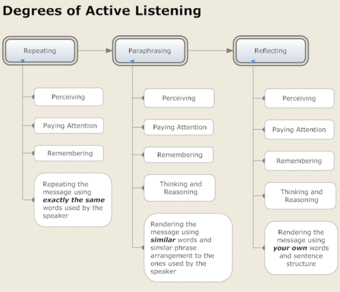
Degrees of Active Listening
There are several degrees of active listening.
Active listening can also involve paying attention to the speaker’s behavior and body language. Having the ability to interpret a person’s body language lets the listener develop a more accurate understanding of the speaker’s message.
5.1.2: Listening and Critical Thinking
Critical thinking skills are essential and connected to the ability to listen effectively and process the information that one hears.
Learning Objective
Illustrate the relationship between critical thinking and listening
Key Points
- Critical thinking is the process by which people qualitatively and quantitatively assess the information they accumulate.
- Critical thinking skills include observation, interpretation, analysis, inference, evaluation, explanation, and metacognition.
- The concepts and principles of critical thinking can be applied to any context or case, including the process of listening.
- Effective listening lets people collect information in a way that promotes critical thinking and successful communication.
Key Terms
- critical thinking
-
The process by which people qualitatively and quantitatively assess the information they have accumulated.
- Metacognition
-
“Cognition about cognition”, or “knowing about knowing. ” It can take many forms, including knowledge about when and how to use particular strategies for learning or for problem solving.
Example
- The first step in thinking critically about the contents of a lecture is to listen to the lecture thoughtfully and without distraction. Using a technique such as active listening, wherein one is able to repeat or paraphrase what has been said, one will better be able to cognitively process the information to draw independent conclusions and think critically.
Critical Thinking

Roosevelt and Churchill in Conversation
Effective listening leads to better critical understanding.
One definition for critical thinking is “the intellectually disciplined process of actively and skillfully conceptualizing, applying, analyzing, synthesizing, and/or evaluating information gathered from, or generated by, observation, experience, reflection, reasoning, or communication, as a guide to belief and action. “
In other words, critical thinking is the process by which people qualitatively and quantitatively assess the information they have accumulated, and how they in turn use that information to solve problems and forge new patterns of understanding. Critical thinking clarifies goals, examines assumptions, discerns hidden values, evaluates evidence, accomplishes actions, and assesses conclusions.
Critical thinking has many practical applications, such as formulating a workable solution to a complex personal problem, deliberating in a group setting about what course of action to take, or analyzing the assumptions and methods used in arriving at a scientific hypothesis. People use critical thinking to solve complex math problems or compare prices at the grocery store. It is a process that informs all aspects of one’s daily life, not just the time spent taking a class or writing an essay.
Critical thinking is imperative to effective communication, and thus, public speaking.
Connection of Critical Thinking to Listening
Critical thinking occurs whenever people figure out what to believe or what to do, and do so in a reasonable, reflective way. The concepts and principles of critical thinking can be applied to any context or case, but only by reflecting upon the nature of that application. Expressed in most general terms, critical thinking is “a way of taking up the problems of life. ” As such, reading, writing, speaking, and listening can all be done critically or uncritically insofar as core critical thinking skills can be applied to all of those activities. Critical thinking skills include observation, interpretation, analysis, inference, evaluation, explanation, and metacognition.
Critical thinkers are those who are able to do the following:
- Recognize problems and find workable solutions to those problems
- Understand the importance of prioritization in the hierarchy of problem solving tasks
- Gather relevant information
- Read between the lines by recognizing what is not said or stated
- Use language clearly, efficiently, and with efficacy
- Interpret data and form conclusions based on that data
- Determine the presence of lack of logical relationships
- Make sound conclusions and/or generalizations based on given data
- Test conclusions and generalizations
- Reconstruct one’s patterns of beliefs on the basis of wider experience
- Render accurate judgments about specific things and qualities in everyday life
Therefore, critical thinkers must engage in highly active listening to further their critical thinking skills. People can use critical thinking skills to understand, interpret, and assess what they hear in order to formulate appropriate reactions or responses. These skills allow people to organize the information that they hear, understand its context or relevance, recognize unstated assumptions, make logical connections between ideas, determine the truth values, and draw conclusions. Conversely, engaging in focused, effective listening also lets people collect information in a way that best promotes critical thinking and, ultimately, successful communication.
5.1.3: Causes of Poor Listening
Listening is negatively affected by low concentration, trying too hard, jumping ahead, and/or focusing on style instead of substance.
Learning Objective
Give examples of the four main barriers to effective listening
Key Points
- Low concentration can be the result of various psychological or physical situations such as visual or auditory distractions, physical discomfort, inadequate volume, lack of interest in the subject material, stress, or personal bias.
- When listeners give equal weight to everything they hear, it makes it difficult to organize and retain the information they need. When the audience is trying too hard to listen, they often cannot take in the most important information they need.
- Jumping ahead can be detrimental to the listening experience; when listening to a speaker’s message, the audience overlooks aspects of the conversation or makes judgments before all of the information is presented.
- Confirmation bias is the tendency to pick out aspects of a conversation that support one’s own preexisting beliefs and values.
- A flashy speech can actually be more detrimental to the overall success and comprehension of the message because a speech that focuses on style offers little in the way of substance.
- Recognizing obstacles ahead of time can go a long way toward overcoming them.
Key Terms
- confirmation bias
-
The tendency to pick out aspects of a conversation that support our one’s own preexisting beliefs and values.
- Vividness effect
-
The phenomenon of how vivid or highly graphic and dramatic events affect an individual’s perception of a situation.
Example
- An audience member who is trying to listen to a lecture when he is tired, there’s construction in the hallway, his pet just died, and he doesn’t like the professor or the tie he’s wearing would find it difficult or impossible to be an effective listener.
Causes of Poor Listening

Causes of Poor Listening
There are many barriers that can impede effective listening.
The act of “listening” may be affected by barriers that impede the flow of information. These barriers include distractions, an inability to prioritize information, a tendency to assume or judge based on little or no information (i.e., “jumping to conclusions), and general confusion about the topic being discussed. Listening barriers may be psychological (e.g., the listener’s emotions) or physical (e.g., noise and visual distraction). However, some of the most common barriers to effective listening include low concentration, lack of prioritization, poor judgement, and focusing on style rather than substance.
Low Concentration
Low concentration, or not paying close attention to speakers, is detrimental to effective listening. It can result from various psychological or physical situations such as visual or auditory distractions, physical discomfort, inadequate volume, lack of interest in the subject material, stress, or personal bias. Regardless of the cause, when a listener is not paying attention to a speaker’s dialogue, effective communication is significantly diminished. Both listeners and speakers should be aware of these kinds of impediments and work to eliminate or mitigate them.
When listening to speech, there is a time delay between the time a speaker utters a sentence to the moment the listener comprehends the speaker’s meaning. Normally, this happens within the span of a few seconds. If this process takes longer, the listener has to catch up to the speaker’s words if he or she continues to speak at a pace faster than the listener can comprehend. Often, it is easier for listeners to stop listening when they do not understand. Therefore, a speaker needs to know which parts of a speech may be more comprehension intensive than others, and adjust his or her speed, vocabulary, and sentence structure accordingly.
Lack of Prioritization
Just as lack of attention to detail in a conversation can lead to ineffective listening, so can focusing too much attention on the least important information. Listeners need to be able to pick up on social cues and prioritize the information they hear to identify the most important points within the context of the conversation.
Often, the information the audience needs to know is delivered along with less pertinent or irrelevant information. When listeners give equal weight to everything they hear, it makes it difficult to organize and retain the information they need. For instance, students who take notes in class must know which information to writing down within the context of an entire lecture. Writing down the lecture word for word is impossible as well as inefficient.
Poor Judgement
When listening to a speaker’s message, it is common to sometimes overlook aspects of the conversation or make judgments before all of the information is presented. Listeners often engage in confirmation bias, which is the tendency to isolate aspects of a conversation to support one’s own preexisting beliefs and values. This psychological process has a detrimental effect on listening for several reasons.
First, confirmation bias tends to cause listeners to enter the conversation before the speaker finishes her message and, thus, form opinions without first obtaining all pertinent information. Second, confirmation bias detracts from a listener’s ability to make accurate critical assessments. For example, a listener may hear something at the beginning of a speech that arouses a specific emotion. Whether anger, frustration, or anything else, this emotion could have a profound impact on the listener’s perception of the rest of the conversation.
Focusing on Style, Not Substance
The vividness effect explains how vivid or highly graphic an individual’s perception of a situation. When observing an event in person, an observer is automatically drawn toward the sensational, vivid or memorable aspects of a conversation or speech.
In the case of listening, distracting or larger-than-life elements in a speech or presentation can deflect attention away from the most important information in the conversation or presentation. These distractions can also influence the listener’s opinion. For example, if a Shakespearean professor delivered an entire lecture in an exaggerated Elizabethan accent, the class would likely not take the professor seriously, regardless of the actual academic merit of the lecture.
Cultural differences (including speakers’ accents, vocabulary, and misunderstandings due to cultural assumptions) can also obstruct the listening process. The same biases apply to the speaker’s physical appearance. To avoid this obstruction, listeners should be aware of these biases and focus on the substance, rather than the style of delivery, or the speaker’s voice and appearance.
5.2: Stages of Listening
5.2.1: The Receiving Stage
The first stage of the listening process is the receiving stage, which involves hearing and attending.
Learning Objective
Define the receiving stage of the listening process
Key Points
- Hearing is the physiological process of registering sound waves as they hit the eardrum.
- Attending is the process of accurately identifying particular sounds we hear as words.
- Attending also involves being able to discern breaks between words, or speech segmentation.
Key Terms
- Attending
-
The process of accurately identifying particular sounds as words.
- Hearing
-
The physiological process of registering sound waves as they hit the eardrum.
- Receiving stage
-
The first stage of the listening process, which involves hearing and attending.
The Receiving Stage
The first stage of the listening process is the receiving stage, which involves hearing and attending.

Use Your Ears!
The first stage of the listening process is receiving.
Hearing is the physiological process of registering sound waves as they hit the eardrum. As obvious as it may seem, in order to effectively gather information through listening, we must first be able to physically hear what we’re listening to. The clearer the sound, the easier the listening process becomes.
Paired with hearing, attending is the other half of the receiving stage in the listening process. Attending is the process of accurately identifying and interpreting particular sounds we hear as words. The sounds we hear have no meaning until we give them their meaning in context. Listening is an active process that constructs meaning from both verbal and nonverbal messages.
The Challenges of Reception
Listeners are often bombarded with a variety of auditory stimuli all at once, so they must differentiate which of those stimuli are speech sounds and which are not. Effective listening involves being able to focus in on speech sounds while disregarding other noise. For instance, a train passenger that hears the captain’s voice over the loudspeaker understands that the captain is speaking, then deciphers what the captain is saying despite other voices in the cabin. Another example is trying to listen to a friend tell a story while walking down a busy street. In order to best listen to what she’s saying, the listener needs to ignore the ambient street sounds.
Attending also involves being able to discern human speech, also known as “speech segmentation. “1 Identifying auditory stimuli as speech but not being able to break those speech sounds down into sentences and words would be a failure of the listening process. Discerning speech segmentation can be a more difficult activity when the listener is faced with an unfamiliar language.
5.2.2: The Understanding Stage
The understanding stage is the stage during which the listener determines the context and meanings of the words that are heard.
Learning Objective
Define the understanding stage of the listening process
Key Points
- The understanding stage is the second stage in the listening process.
- Determining the context and meaning of each word is essential to understanding a sentence.
- Understanding what we hear is essential to gathering information.
- Asking questions can help a listener better understand a speaker’s message or main point.
Key Terms
- comprehension
-
The totality of intentions or attributes, characters, marks, properties, or qualities, that the object possesses; the totality of intentions that are pertinent to the context of a given discussion.
- Understanding stage
-
The stage of listening during which the listener determines the context and meanings of the words that are heard.
Stages of Listening: The Understanding Stage

Puzzled
After receiving information through listening, the next step is understanding what you heard.
The second stage in the listening process is the understanding stage. Understanding or comprehension is “shared meaning between parties in a communication transaction” and constitutes the first step in the listening process. This is the stage during which the listener determines the context and meanings of the words he or she hears. Determining the context and meaning of individual words, as well as assigning meaning in language, is essential to understanding sentences. This, in turn, is essential to understanding a speaker’s message.
Once the listeners understands the speaker’s main point, they can begin to sort out the rest of the information they are hearing and decide where it belongs in their mental outline. For example, a political candidate listens to her opponent’s arguments to understand what policy decisions that opponent supports.
Before getting the big picture of a message, it can be difficult to focus on what the speaker is saying. Think about walking into a lecture class halfway through. You may immediately understand the words and sentences that you are hearing, but not immediately understand what the lecturer is proving or whether what you’re hearing in the moment is a main point, side note, or digression.
Understanding what we hear is a huge part of our everyday lives, particularly in terms of gathering basic information. In the office, people listen to their superiors for instructions about what they are to do. At school, students listen to teachers to learn new ideas. We listen to political candidates give policy speeches in order to determine who will get our vote. But without understanding what we hear, none of this everyday listening would relay any practical information to us.
One tactic for better understanding a speaker’s meaning is to ask questions. Asking questions allows the listener to fill in any holes he or she may have in the mental reconstruction of the speaker’s message.
5.2.3: The Evaluating Stage
The evaluating stage is the listening stage during which the listener critically assesses the information they received from the speaker.
Learning Objective
Define the evaluating stage of the listening process
Key Points
- The listener assesses the information they have gathered from the speaker both qualitatively and quantitatively.
- Evaluating allows the listener to form an opinion of what they heard.
- Evaluating is important for a listener in terms of how what she’s heard will affect her own ideas, decisions, actions, and/or beliefs.
Key Terms
- tangential
-
Merely touching, referring to a tangent, only indirectly related.
- Evaluating stage
-
The stage of the listening process during which the listener critically assesses the information they received from the speaker.
- assess
-
To determine, estimate or judge the value of; to evaluate.
The Evaluating Stage

Focus
Once you understand what you hear, you can focus in on the relevant information.
This stage of the listening process is the one during which the listener assesses the information they received, both qualitatively and quantitatively. Evaluating allows the listener to form an opinion of what they heard and, if necessary, to begin developing a response.
During the evaluating stage, the listener determines whether or not the information they heard and understood from the speaker is well constructed or disorganized, biased or unbiased, true or false, significant or insignificant. They also ascertain how and why the speaker has come up with and conveyed the message that they delivered. This may involve considerations of a speaker’s personal or professional motivations and goals. For example, a listener may determine that a co-worker’s vehement condemnation of another for jamming the copier is factually correct, but may also understand that the co-worker’s child is sick and that may be putting them on edge. A voter who listens to and understands the points made in a political candidate’s stump speech can decide whether or not those points were convincing enough to earn their vote.
The evaluating stage occurs most effectively once the listener fully understands what the speaker is trying to say. While we can, and sometimes do, form opinions of information and ideas that we don’t fully understand—or even that we misunderstand—doing so is not often ideal in the long run. Having a clear understanding of a speaker’s message allows a listener to evaluate that message without getting bogged down in ambiguities or spending unnecessary time and energy addressing points that may be tangential or otherwise nonessential.
This stage of critical analysis is important for a listener in terms of how what they heard will affect their own ideas, decisions, actions, and/or beliefs.
5.2.4: The Responding Stage
The responding stage is when the listener provides verbal and/or nonverbal reactions to what she hears.
Learning Objective
Define the responding stage of the listening process
Key Points
- The speaker looks for responses from the listener to determine if her message is being understood and/or considered.
- When a listener responds verbally to what she hears, the speaker/listener roles are reversed.
- Based on the listener’s responses, the speaker can choose to either adjust or continue with the delivery of her message.
Key Term
- Responding stage
-
The listening stage wherein the listener provides verbal and/or nonverbal reactions to what she hears.
Example
- During a training session, a new employee nods and says “okay” to indicate that she understand what her boss is telling her.
The Responding Stage
The responding stage is the stage of the listening process wherein the listener provides verbal and/or nonverbal reactions based on short- or long-term memory. Following the remembering stage, a listener can respond to what they hear either verbally or non-verbally. Nonverbal signals can include gestures such as nodding, making eye contact, tapping a pen, fidgeting, scratching or cocking their head, smiling, rolling their eyes, grimacing, or any other body language. These kinds of responses can be displayed purposefully or involuntarily. Responding verbally might involve asking a question, requesting additional information, redirecting or changing the focus of a conversation, cutting off a speaker, or repeating what a speaker has said back to her in order to verify that the received message matches the intended message.
Nonverbal responses like nodding or eye contact allow the listener to communicate their level of interest without interrupting the speaker, thereby preserving the speaker/listener roles. When a listener responds verbally to what they hear and remember—for example, with a question or a comment—the speaker/listener roles are reversed, at least momentarily.
Responding adds action to the listening process, which would otherwise be an outwardly passive process. Oftentimes, the speaker looks for verbal and nonverbal responses from the listener to determine if and how their message is being understood and/or considered. Based on the listener’s responses, the speaker can choose to either adjust or continue with the delivery of her message. For example, if a listener’s brow is furrowed and their arms are crossed, the speaker may determine that she needs to lighten their tone to better communicate their point. If a listener is smiling and nodding or asking questions, the speaker may feel that the listener is engaged and her message is being communicated effectively.
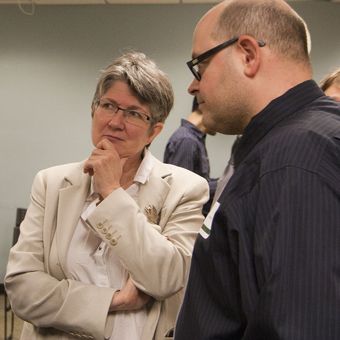
The listener
By holding her hand up to her chin, this woman is giving a nonverbal signal that she is concentrating on what the speaker (not pictured) is saying.
5.2.5: The Remembering Stage
The remembering stage occurs as the listener categorizes and retains the information she’s gathering from the speaker.
Learning Objective
Define the remembering stage of the listening process
Key Points
- Memory is essential throughout the listening process.
- Memory lets the speaker put what she hears in the context of what she’s heard before.
- Using information immediately after receiving it enhances information retention.
- Distracted or mindless listening reduces information retention.
Key Terms
- memory
-
The ability of an organism to record information about things or events with the facility of recalling them later at will.
- recall
-
Memory; the ability to remember.
- Remembering stage
-
The stage of listening wherein the listener categorizes and retains the information she’s gathering from the speaker.
The Remembering Stage

Memory
Remembering what you hear is key to effective listening.
In the listening process, the remembering stage occurs as the listener categorizes and retains the information she’s gathered from the speaker for future access. The result–memory–allows the person to record information about people, objects and events for later recall. This happens both during and after the speaker’s delivery.
Memory is essential throughout the listening process. We depend on our memory to fill in the blanks when we’re listening and to let us place what we’re hearing at the moment in the context of what we’ve heard before. If, for example, you forgot everything that you heard immediately after you heard it, you would not be able to follow along with what a speaker says, and conversations would be impossible. Moreover, a friend who expresses fear about a dog she sees on the sidewalk ahead can help you recall that the friend began the conversation with her childhood memory of being attacked by a dog.
Remembering previous information is critical to moving forward. Similarly, making associations to past remembered information can help a listener understand what she is currently hearing in a wider context. In listening to a lecture about the symptoms of depression, for example, a listener might make a connection to the description of a character in a novel that she read years before.
Using information immediately after receiving it enhances information retention and lessens the forgetting curve, or the rate at which we no longer retain information in our memory. Conversely, retention is lessened when we engage in mindless listening, and little effort is made to understand a speaker’s message.
Because everyone has different memories, the speaker and the listener may attach different meanings to the same statement. In this sense, establishing common ground in terms of context is extremely important, both for listeners and speakers.
5.3: Barriers to Listening
5.3.1: Culture
Cultural differences between listeners and speakers can create barriers to effective communication.
Learning Objective
Identify ways in which an effective communicator will approach communicating with a person from another culture
Key Points
- Cultural differences can include speakers’ accents, vocabulary, and assumptions about shared information or the roles of listeners and speakers in conversation.
- Effective communicators understand that they grow up with cultural biases for and against certain modes of communication.
- Suspending judgments, exercising empathy, and focusing on content rather than style can help overcome cultural barriers to effective communication.
Key Term
- culture
-
The arts, customs, lifestyles, background, and habits that characterize a particular society or nation. The beliefs, values, behavior and material objects that constitute a people’s way of life.
Example
- When listening to a speaker who comes from a different cultural background, work to set aside any preexisting ideas about that culture and focus on best understanding the speaker’s specific message.
Keeping an Open Mind to Cultural Differences

Handshake
Different cultures can have different methods of communication.
What defines culture? Culture certainly includes race, nationality, and ethnicity, but it goes beyond those identity markers as well. When we talk about culture, we are referring to belief systems, values, and behaviors that support a particular ideology or social arrangement. The following are various aspects of our individual identity that we use to create membership in a shared cultural identity: race, ethnicity, nationality, gender, sexual orientation, and class. Culture guides language use, appropriate forms of dress, and views of the world. The concept is broad and encompasses many areas of society such as the role of the family, the role of the individual, educational systems, employment, and gender.
Different cultures have different modes and patterns of communication that can hinder effective listening if the listener is either unfamiliar with the speaker’s patterns or holds a mistaken view about them. These kinds of cultural differences include speakers’ accents and vocabulary, as well as assumptions about shared information and the roles of listeners and speakers in conversation.
In a broad sense, we all grow up immersed in various cultures all at once—family, country, region, sexual orientation, religion, socioeconomic class, etc.—and sometimes the specifics of those cultures seem to be hard-wired into our thinking and the ways in which we communicate. Without meaning to, we may bring assumptions or judgments into a conversation that don’t actually align with the thoughts or beliefs of our conversational partner, and this can create a barrier to effective communication.
Effective communicators understand that they grow up with cultural biases for and against certain modes of communication. Because of this, an open-minded listener will work hard to focus on what the speaker is actually saying regardless of how they’re saying it. Cultural filters and frameworks may be useful later in an analysis of what someone said, but the starting point of effective listening should be to understand the perspective of the speaker as fully as possible.
Maintaining this kind of cultural sensitivity requires some basics of open-minded listening: suspending judgment and employing empathy whenever possible. By meeting the speaker on his or her own grounds and taking care to focus on the content rather than the style of the communication, we can best assure more effective understanding.
5.3.2: Gender
All of us can and do speak the language of multiple gender cultures, and we can use this knowledge to communicate effectively.
Learning Objective
Distinguish between communicating in a feminine style with communicating in a masculine style
Key Points
- As a social construct, gender is learned, symbolic, and dynamic.
- Starting in childhood, girls and boys are generally socialized to belong to distinct cultures and thus, speak in ways particular to their own gender’s rules and norms.
- For those socialized in a feminine community, the purpose of communication is to create and foster relational connections with other people.
- The goal for typically masculine communication is to establish individuality.
Key Term
- gender
-
The socio-cultural phenomenon of the division of people into various categories, such as “male” and “female,” with each having associated clothing, roles, stereotypes, etc.
Example
- When addressing an audience composed primarily of women versus one composed mostly of men, a political candidate may alter her communicative style to be more or less direct or responsive while still communicating the same information.
Gender and Culture

Invisible Couple
Differences in gender communication styles can sometimes lead to less effective communication.
In our society, we often use the gendered terms “women” and “men” instead of “male” and “female. ” What’s the difference between these two sets of terms? One pair refers to the biological categories of male and female. The other pair, men and women, refers to what are now generally regarded as socially constructed concepts that convey the contextually fluid cultural ideals or values of masculinity and femininity. Gender exists on a continuum because feminine males and masculine females are not only possible but common, and the varying degrees of masculinity and femininity we see (and embody ourselves) are often separate from sexual orientation or preference. In other words, as a social construct, gender is learned, symbolic, and dynamic.
Gender and Speech
Starting in childhood, girls and boys are generally socialized to belong to distinct cultures and thus, speak in ways particular to their own gender’s rules and norms (Johnson, 2000; Tannen 1986, 1990, 1995). This pattern of gendered socialization continues throughout our lives. As we’ve previously discussed, culturally diverse ways of speaking can cause miscommunication between members of each culture or speech community. As such, men and women often interpret the same conversation differently.
“Masculine” and “Feminine” Communication Styles
For those socialized in a feminine community, the purpose of communication is to create and foster relational connections with other people (Johnson, 2000; Wood, 2005). On the other hand, the goal for typically masculine communication is to establish individuality. This is done in a number of ways, such as indicating independence, showing control, and entertaining or performing for others.
When the goal is connection, members of a speech community are likely to engage in the following six strategies–equity, support, conversational “maintenance work,” responsiveness, a personal style, and tentativeness. When the goal is independence, on the other hand, members of this speech community are likely to communicate in ways that exhibit knowledge, refrain from personal disclosure, are abstract, are focused on instrumentality, demonstrate conversational command, are direct and assertive, and are less responsive.
All of us are capable of speaking, and do speak, the language of multiple gender cultures. Again, this is one of the reasons it is important to make a distinction between gender and sex. Both men and women may make conscious choices to speak more directly and abstractly at work, but more personal at home. Such strategic choices indicate that we can use our knowledge about various communication styles or options to make us successful in many different contexts.
As with other cultural differences, when listening to a speaker who is communicating in a particularly gendered style, try to focus on the content of the message while suspending judgment and exercising empathy.
5.3.3: Technology
Technology can assist the audience with listening, but can also be a distraction at the same time.
Learning Objective
Identify methods for avoiding technological distractions
Key Points
- Technology can help the audience listen to the speech’s message by making them physically able to hear the speaker’s words, such as through electronic amplification.
- However, malfunctioning technological equipment can disrupt the listening process.
- Personal electronics like laptops and cell phones can distract listeners from a speaker, particularly when used by audience members during the presentation.
- Do not be afraid to do a test run of any and all technology that will be used during the presentation to ensure it works smoothly when the time comes.
- Before the beginning of the speech, both the speaker and the audience should silence their cell phones or other noise-making devices.
Key Term
- technology
-
A device, material, or sequence of mathematical coded electronic instructions created by a person’s mind that is built, assembled, or produced and which is not part of the natural world.
Example
- To most effectively listen to a lecture, try turning off your cell phone and Internet connection to avoid potential distractions.
Technological Distractions

Lasers
If a speaker uses technology, they must get their message across without distracting the audience.
Everyone has experienced the benefits technology can provide to the listening experience. Hearing aid technology can help those who are hard of hearing more easily engage in a conversation or listen to a lecture. Electronic presentations can incorporate photographs, sounds, charts, guided outlines, and other features to help maintain audience attention and clarify or demonstrate complicated ideas. An engaged audience member is more likely to pay attention to the material and therefore listen more actively to a presentation.
When not used properly, however, technology can become a barrier to effective listening. Poor or outdated equipment can malfunction, causing disruptions to the listening process. If a conversation is taking place via an electronic medium, problems with technology (like a buzzing phone line or slow Internet connection) can likewise limit communication. In a non-virtual setting, excessive or unnecessary audio/visual components to a technological presentation can become distracting, particularly if they are directly related to the message being communicated by the person making the presentation.
Beyond technology being utilized by the presented, technology used by the listener can also hinder effective listening. Taking lecture notes on a laptop is convenient, but it is also convenient to check Facebook or the latest sports scores. Cell phones and tablets can provide similar distractions. If someone in the audience is talking or texting during the speech, technology becomes a major distraction for everyone involved.
Ultimately, the onus lies with both the speaker and the listener to anticipate potential technological problems or distractions to the listening process, and to do what they can to eliminate or mitigate their effects. Technology should simplify communication, not make it more complicated.
Speakers can avoid distractions caused by technology by doing the following:
- Before the presentation, the speaker should silence his or her cell phone or any other device that might make noise and provide an interruption.
- The audience should to do the same. The speaker has the right to request that the audience comply with his or her desire to have a distraction-free environment.
- If using technology as part of the presentation, the speaker should do a test run to make sure that everything is set up properly to avoid malfunction later during the speech.
- If possible, the speaker should do a sound check. Amplified or not, at the beginning of the speech, the speaker should ask, “Can you hear me in the back? ” or something to that effect.
- The speech should not include too many sources of visual stimulation such as visual aids, PowerPoints, charts, laser pointers, etc. This can actually cause a message overload for the audience as they try to divide their attention between what they hear and what they see.
5.4: Enhancing Your Listening
5.4.1: Be a Serious Listener: Resist Distractions and Listen Actively
Resisting distractions and listening actively are two ways to become a more effective listener.
Learning Objective
Explain how resisting distractions and listening actively can make you a more effective listener
Key Points
- Distractions can be internal or external. External distractions include auditory, visual, or physical noise. Internal distractions may be psychological or emotional.
- In order to best focus in on a speaker’s message, try to eliminate as many distractions as possible.
- Active listening is a communication technique that requires the listener to feed back what they hear to the speaker.
- Active listening also involves observing and assessing the speaker’s behavior and body language.
Key Term
- active listening
-
A particular communication technique that requires the listener to provide feedback on what he or she hears to the speaker.
Example
- To best listen to Troy, Penelope turned off the television and her cell phone, let him speak his mind while noticing his crossed arms and frown, then verified what she’d heard him say by re-stating it and also mentioning that he seemed a little unhappy about the situation.
Resisting Distraction

Distractions Are Everywhere
Learning how to tune out distractions enables people to be better listeners.
Distractions can come in all shapes and sizes. To be serious, effective listeners, people must learn how to resist the distractions that cross their path so they can better focus in on what they are trying to hear. Distractions and noise come in two broad types: internal and external.
External distractions often come in the form of physical noise in the physical environment. Auditory and visual distractions are often the most easily identifiable types of external distractions. Loud or extraneous noises can inhibit effective listening, as can unnecessary or excessive images. Think about trying to have a meaningful conversation with a friend while someone else is watching an action movie in the same room. Pretty impossible, right?
Internal distractions often refer to psychological and emotional noise. Distractions can also originate internally or can be physical responses to the environment. Feeling hungry, upset, or physically uncomfortable can be just as detrimental to effective listening as extraneous things in the physical environment. If a speaker is nervous about presenting a speech, he or she may have a litany of negative thoughts in his or her inner monologue, or the “little voice in your head. ” Internal distractions also occur when someone is thinking about plans for after your speech, or thinking about topics and things completely unrelated to the speech at hand. These are all examples of internal distractions.
In order to best focus in on a speaker’s message, try to eliminate as many possible distractions as possible. Turn off all mobile devices, relocate to a quiet space, and close unnecessary windows on the computer.
Active Listening
Active listening is a communication technique that requires the listener to feed back what they hear to the speaker. Most often, listeners will do this by re-stating or paraphrasing what they have heard in their own words. This activity confirms what the listener heard and, moreover, confirms that both parties understand each other. It is important to note, however, that by paraphrasing the speaker’s message, the listener is not necessarily agreeing with the speaker. Paraphrasing also helps the listener better retain that information for future access.
If someone is actively listening, then he or she is typically not distracted. Speakers can also cultivate the habit of avoiding distractions (for example, by addressing questions after the presentation, not during).
In addition to internalizing what a speaker says, active listening also involves observing and assessing the speaker’s behavior and body language, and relaying that information back to the speaker as well. Having the ability to interpret a speaker’s body language lets the listener develop a more accurate understanding of the speaker’s message. When the listener does not respond to the speaker’s nonverbal language, he or she engages in a content-only response that ignores the emotions that guide the message; this can limit understanding.
The ability to listen actively demonstrates sincerity on the part of the listener and helps to make sure that no information is being assumed or taken for granted. Active listening is most often used to improve personal relationships, reduce misunderstanding and conflicts, strengthen cooperation, and foster understanding.
5.4.2: Be an Open-Minded Listener: Suspend Judgment and Exercise Empathy
Open-minded listening requires empathy and a suspension of judgment on the part of the listener.
Learning Objective
Explain how to listen with an open mind
Key Points
- Listening with an open mind means being receptive to being influenced by what one hears.
- Suspend judgment by becoming aware of pre-conceived notions; listening to the entire speech before jumping to conclusions; and listening to what the speaker has to say for understanding, not just to determine whether the speaker is right or wrong.
- Listening with empathy lets the listener better understand where the speaker is coming from, emotionally and conceptually.
- To be an effective open-minded listener, learn to leave ego at the door, and instead strive to find common ground with your speaker.
Key Terms
- empathy
-
The capacity to understand another person’s point of view or the result of such understanding.
- Judgment
-
The evaluation of evidence in the making of a decision.
Example
- Though Kate was annoyed that Jackson had left the car windows open in the rain, after listening to his explanation with an open mind, she understood that he’d been under a lot of stress at work lately and that he was sorry for the mishap.
Suspending Judgment
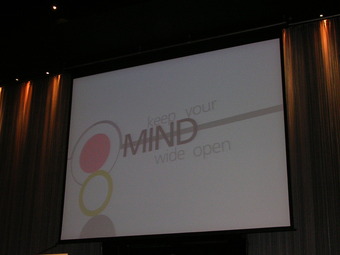
Be an Open-Minded Listener
Open mindedness is essential to effective listening.
Someone who listens with an open mind is willing to be influenced by what he or she hears. It does not mean that the listener should not have strong views of his or her own, but it does require the listener to be willing to consider the merit of what other people say. This can be difficult when listening to something one does not want to hear or something about which one has pre-conceived notions.
All people have their own opinions on just about everything, so when people listen, they are tempted to immediately judge what someone else is saying from their own perspectives. However, this kind of pre-judging can lead to misunderstanding. People who listen with an open mind avoid anticipating what they think their conversational partners are going to say. They do not jump to conclusions, but rather hear the speaker out entirely and make an effort to understand his or her lines of argument.
Judgmental listening also occurs when the listener is only listening to the speaker in order to determine whether he or she is right or wrong, rather than listening to understand the speaker’s ideas and where they come from. This kind of judgmental listening prevents the listener from fully engaging with the speaker on his or her own terms, and therefore limits the scope of the conversation.
Carrying pre-conceived notions about the speaker or the content of a speech into a conversation further limits effective listening. Listeners may have overwhelmingly positive or negative associations with particular people or ideas, and those associations can affect how listeners interpret. To listen effectively, one must work to temporarily suspend those associations in order to understand the speaker on his or her own terms.
Exercising Empathy
Exercising empathy while listening to a speaker is related to suspending judgment in that it requires the listener to work to understand what the speaker says from his or her point of view. This does not mean that the listener must automatically agree with the speaker; rather, the listener should simply put him- or herself in the speaker’s shoes and try to see the presented arguments from that perspective. One of the primary jobs of an effective listener is to get in touch with the speaker’s perspective and not to color it with his or her own.
Empathetic listening helps promote effective listening because it allows the listener to take into account where the speaker is coming from, both emotionally and in terms of the content of his or her speech. This lets the listener assess what the speaker says and how it is presented more accurately, which ultimately leads to better understanding.
Tips for Being an Open-Minded Listener
- Leave ego at the door. Come to the presentation with a mind like a blank slate.
- When disagreeing with the speaker, write down the objections rather than tuning out the presenter.
- Be open to new ideas or new ways of thinking.
- Look for opportunities to share common ground with the speaker, such as beliefs, ideologies, or experiences.
5.5: Helping Your Audience Listen More
5.5.1: Read Feedback Cues
Feedback is the verbal and non-verbal responses from an audience which help the speaker modify and regulate what s/he is saying.
Learning Objective
Apply your observations of feedback from your audience to modify your speech
Key Points
- Verbal feedback–during the speech you may solicit feedback from the audience by asking a simple question to get feedback from the audience.
- Non-verbal feedback–When you are in front of the audience, non-verbal behavior can be an important cue to what the audience understands, the level of attentiveness, excitement or agreement, or confusion or disagreement.
- Audience Response System– capture feedback from a large or remote audience by using an audience response system to ask questions and then display the answers. Audience members can respond using a wireless keypad such as a clicker, SMS, or text using a smartphone.
- You can use the responses as personal feedback to modify your message or you can share them with the audience by displaying the tabulated responses on a web page or projected as part of a PowerPoint presentation.
Key Term
- feedback
-
The receivers’ verbal and nonverbal responses to a message, such as a nod for understanding (nonverbal), a raised eyebrow for being confused (nonverbal), or asking a question to clarify the message (verbal).
Read Feedback Cues
Feedback is the response from the listeners
Feedback is the response that listeners provide to the sender of the message. Feedback is a cue to the speaker to modify or regulate what is being said. Feedback can take the form of verbal or non-verbal responses to an in-person speech, or verbal responses which are electronically captured for large or remote audiences .
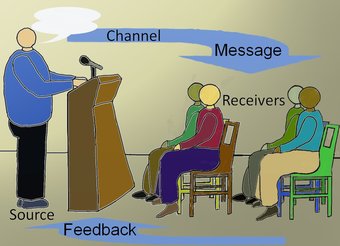
Receiving Feedback
It is important for the speaker to receive feedback from the audience.
In-Person Verbal and Non-Verbal Feedback
Verbal Feedback
During the speech you may solicit feedback from the audience by asking a simple question. Audience members may respond verbally or they may nod or raise their hands. Additionally, audience members may ask a question or let you know if they do not understand. You may also receive direct positive or negative feedback from members of the audience who agree or disagree with what you are saying. Listen for the verbal feedback and acknowledge it.
Non-Verbal Feedback
When you are in front of the audience, non-verbal behavior can be an important cue to what the audience understands, the level of attentiveness, excitement or agreement, or confusion or disagreement. The non-verbal feedback may be intentional vocalizations, such as groans or encouragement (such as clapping). However, much of the non-verbal feedback may be unconscious physical body language, which can provide feedback for you. Here are some examples of body language that you may notice displayed consciously or subconsciously by members of the audience:
- Boredom: boredom is indicated by the head tilting to one side, or by the eyes looking straight at the speaker but becoming slightly unfocused.
- Disbelief: this is often indicated by averted gaze or by touching the ear or scratching the chin. When a person is not being convinced by what someone is saying, the attention invariably wanders and the eyes will stare away for an extended period.
- Attentive eye contact: Are audience members looking directly at you attentively or are they looking around? Consistent eye contact can indicate that a person is interested and thinking positively about the speaker’s subject. However, if a person is fiddling with something, even while directly looking at you, it could indicate that the attention is elsewhere.
- Body position and posture: Audience members will generally face the speaker while listening intently; if the audience members are not interested they may shift the body position to the side rather than toward the speaker.
If you maintain eye contact with your audience while speaking, you can observe the cues and adapt your message. What is your audience telling you? All the non-verbal feedback needs to be processed with knowledge of the cultural context of the speaker and the audience. Remember that people from different cultures do interpret body language in different ways. For example, eye contact can be misleading because cultural norms about it vary widely. Direct eye contact may show attentiveness to the North American speaker but be considered a confrontation in another culture. And, certain hand gestures that are perfectly acceptable to one group may be disrespectful to another audience.
Feedback Electronically Captured from Large or Remote Audiences
You can also capture the responses from the audience by using an audience response system that you can view privately as you speak or display to the audience. You can solicit feedback directly by asking multiple choice, true-false, or numerical questions from audience members who respond using a wireless keypad such as a clicker, SMS, or text using a smartphone. The feedback from the audience is then sent back to your computer and processed by the audience response software. For a large or remote audience, you can plan to include different questions or polls to capture feedback from your audience and adapt your message accordingly. It is necessary to structure the questions to get the feedback you want. For example, if a large percentage of your audience answers a question with a certain wrong answer, you will know that you need to explain that concept differently. Conversely, if a large percentage of the audience agrees with an opinion, you can use that feedback to adapt your message.
Timing of Feedback
Assessment, or the tactics speakers and audience members use to facilitate learning, is often divided into initial, formative, and summative categories.
- Initial assessment, also referred to as pre-assessment or diagnostic assessment, is conducted prior to instruction or intervention to establish a baseline from which an individual’s growth can be measured.
- Formative assessment is generally carried out throughout a course or project. Formative assessment, also referred to as “educative assessment,” is used to aid learning. For example, in an educational setting, formative assessment might be a teacher (or peer) or the learner, providing feedback on a student’s work and would not necessarily be used for grading purposes. Formative assessments can take the form of diagnostic, standardized tests.
- Summative assessment is generally carried out at the end of a course, project or speech. In an educational setting, summative assessments are typically used to assign students a course grade. Whereas following a speech or presentation, summative assessment can be provided in the form of positive feedback, applause or a standing ovation.
5.5.2: Hold the Audience’s Attention
To hold the audience’s attention, consider their readiness to perceive, the selection of stimuli, and how to maintain current awareness.
Learning Objective
Employ strategies for maintaining audience focus
Key Points
- If the speaker can establish readiness by getting the audience’s attention during the first 25-30 seconds of the speech, he or she can then direct and focus that attention to the important parts of the message.
- The speaker can direct the attention of the audience to what is important by using changes in rate and volume, body movement, and gesture to emphasize what is important.
- It is important to read the non-verbal clues of the audience to understand if they have shifted their attention somewhere else.
- If the audience’s attention is shifting from the speech, challenge the audience with an inquiry to stimulating thinking.
- There are many strategies to employ to hold the attention of the audience, but the most important is the ability to establish and maintain a genuine connection with the people in the audience.
Key Terms
- awareness
-
The state or ability to perceive, to feel, or to be conscious of events, objects, or sensory patterns. In this level of consciousness, sense data can be confirmed by an observer without necessarily implying understanding.
- Perception
-
Conscious understanding of something; acuity.
To hold the attention of the audience, a public speaker should consider three important aspects of the process of perception: readiness to perceive, selection of certain stimuli for focus of attention, and state of current awareness.
Readiness to Perceive
The speaker is responsible for setting the stage. The speaker does this with the opening introduction in the the first 25 to 30 sections. If the speaker can secure the attention of the audience at the very beginning of the speech, he or she can then direct and focus that attention to the important parts of the message, as follows:
- Make sure that the room is free of noise and other distractions, to ensure that the audience is focused on the speech, rather than what is happening in the room.
- Speakers are often introduced by a host. This brief introduction is important because it helps to establish the speaker’s credentials and prepares the audience members so their attention is properly directed.
- Remember that the first important function of the introduction is to “capture the attention of the audience” and them immediately direct attention to the speech’s main message.
Selection of Certain Stimuli for Focus
While delivering the speech, the speaker wants the audience to concentrate on his or her message, and directs their attention to what is important through the use of voice, body, and gesture. This is done by emphasizing the important points by changing the rate, volume, or pitch of the voice. Using vocal variety purposely helps the audience know what is important and directs their attention to those elements. In addition, the speaker’s body and gestures can direct attention to important aspects of the message (for example, by pointing to, walking to, or touching a visual aid or diagram). Additional examples include the following:
- To understand where he or she wants the audience to direct their attention, the speaker can consider a quick internal summary of an idea.
- Use signposts, such as “Now get this…” or “Here is the important point, which I want you to remember. “
- When using a visual aid, use additional audio cues or color changes to highlight specific areas.
State of Current Awareness
Speakers must read the non-verbal clues of the audience to understand if they have shifted their focus somewhere else. If the audience members are glancing at their watches, texting, or glancing at other people in the audience, the speaker should recognize the current state and redirect the attention back to the speech’s message. To change the current state of the audience’s awareness and re-gain their attention, try the following:
- Challenge the audience with an inquiry to stimulating thinking. Ask for a show of hands to vote or to give answers, use clickers or an audience response system to get a response and then share the result, or ask a relevant question to stimulate thought.
- Engage in narrative as a change of pace from message delivery. Create a narrative that is relevant to the topic and is dramatic for the audience, and use a surprise ending to direct the audience attention to the message.
- Provide concrete examples of a concept or main point that is directly relevant and engaging for the audience. Make a comparison to something that has recently happened in the community or nationally.
- Stimulate the audience’s imagination or take them on a fantasy journey that stimulates the different senses. The more the senses are stimulated, the more the current focus is on the speech’s message.
There are many strategies that the speaker can employee to hold the attention of the audience, but the most important is the ability to establish and maintain a genuine connection with the people in your audience. Speakers don’t need to use a choke-hold to keep the audience’s attention.

Choke-hold
Speakers don’t need to use a choke -hold to keep the audience’s attention.
5.5.3: Maximize Understanding
To maximize understanding, use general rhetorical strategies and other approaches that build upon the audience’s prior experiences.
Learning Objective
Give examples of ways to help your audience understand your ideas
Key Points
- We depend on the use of words applied in various rhetorical strategies to exchange understandings.
- You can apply prior knowledge of the audience to choose the right vocabulary, to make comparisons with things familiar to them, to show the origin of things, to group things into categories meaningful to them, and to number the steps or events in the order that they occur.
- To increase understanding during a speech, you can take the perspective of the audience to restate ideas, to ask the audience questions, and to paraphrase what you have just said using different examples and choice of words.
Key Terms
- comparison
-
An evaluation of the similarities and differences of one or more things relative to each other.
- understanding
-
The mental (sometimes emotional) process of comprehension, or the assimilation of knowledge, which is subjective by its nature.
- classification
-
The act of forming into a class or classes; a distribution into groups, as classes, orders, families, etc., according to some common relations or attributes.
The Elements of Understanding
Understanding involves comprehending or knowing about an object, idea, concept, or process. In essence, you want the audience to comprehend and share the same understanding. It would be a very simple process if you could just exchange memory modules for your audience to upload, but we are not there yet. Today, you will use words to explain your thoughts. Here we are concerned with how you might use different rhetorical strategies to maximize what the audience understands.
Applying Prior Knowledge about the Audience
Apply what you already know about the demographics, background, and life experiences of the audience. Ask yourself, “What does my audience already understand or know? ” You can apply the knowledge to maximize understanding.
- Language choice and vocabulary: You’ll want to begin your explanation at the right level; ask yourself, “What vocabulary will my audience understand and what do I need to explain before I can explain other concepts? “
- Compare and contrast based upon shared knowledge: When you are showing how two things are alike, create connections with what the audience already knows. In order to maximize understanding, you’ll want to compare those things that are already familiar against the new and unfamiliar things. Then, you can demonstrate how they are the same or different.
- Visualize transformation by cause and origin: Where did something come from and how did it get to its present state or condition? Help the audience picture the change from one state or condition to another.
- Classification and grouping alike things to form a concept: First, you’ll want to cite examples that are familiar to the audience and put them into the same classification. Then you can put other less familiar objects or ideas into the same class or grouping while using the same label. You can even help the audience generalize to create a classification. For example, let’s say you see a fir, a willow, and a linden. By comparing these objects, you notice that they are different from one another in respect to the trunk, branches, leaves, and the like; a further comparison, however, reveals what they have in common: the trunk, branches, and leaves themselves, which form the abstraction from their size, shape, and so forth. Thus, you gain a concept of a tree .
- Sequence and origin: Here you help the audience understand the process or sequence of events in time. You can clearly list and number the steps or events in the order in which they occur. In addition to using sequencing words, you can also use simple mnemonics, like the knuckle mnemonic, which helps the listeners sequence things such as how many days are in each month .
Applying General Strategies
- Perspective-taking: Practice perspective-taking so you can frame and reframe your examples in a way that the audience members will understand. You’ll want to see how the members of the audience organize the world cognitively in order to reframe your concepts so that the audience understands them. If your initial explanation is not effective with a particular audience, you may reframe and refocus on different aspects of what you are explaining.
- Repetition: Build upon prior understanding of concepts by repeating and using internal summaries. This ensures the audience does not miss an important idea that is critical to understanding the whole message.
- Questioning: Question your audience to see if they understand what you are saying, and adjust your explanation in order to clarify misunderstandings.
- Paraphrase: Paraphrase what you said for the audience and restate the ideas using different examples. Different audience members may not understand one idea but may understand another that relates more directly to their prior knowledge.
Simply put, you’ll want to learn how the audience conceptualizes the world and then use that knowledge to maximize understanding. Use your skills of restating, questioning, perspective-taking, and paraphrasing to help clarify and reinforce understanding as you speak.
5.5.4: Build Credibility
Aristotle established three methods of proof to build credibility: initial, derived, and terminal.
Learning Objective
Give examples of ways to build credibility before, during, and after your speech
Key Points
- Credibility is not a characteristic of the source or speaker but an attitude in the mind of the listener(s). You may have high credibility with one group of listeners and low credibility with another.
- Building initial credibility—your initial credibility is your personal brand. The audience may know you prior to the speech. If not, have someone introduce you or provide relevant background as a self-introduction.
- Building derived credibility—When you speak confidently and assertively you inspire others with your energy and words. To build credibility you want to look at everything you do in the speech such as appearance, delivery, word choice, and in general how you handle yourself.
- Building derived credibility—You establish common ground with the audience by sharing aspects of your background that are similar to the audience, by using supporting examples or experiences that you and the audience have in common, and by creating a bond with the audience.
- Terminal credibility—You can build credibility for your next speech by establishing a rapport with the audience so they walk away with a more positive view of you than when you started.
Key Terms
- ethos
-
A rhetorical appeal to an audience based on the speaker/writer’s credibility.
- Aristotle
-
An ancient Greek philosopher (382–322 BC), student of Plato, and teacher of Alexander the Great.
- credibility
-
The objective and subjective components of the believability of a source or message.
Build Credibility
Building Credibility through Character and Competence
Aristotle, the classical Greek philosopher and rhetorician, established three methods of proof—logos, ethos, and pathos.
Logos is the logical development of the message, pathos is the emotional appeals employed by the speaker, and ethos is the moral character of the speaker as perceived by the audience. Our focus on credibility relates to ethos, the ethical character and competence of the speaker. To build credibility you want to focus on three stages: (1) Initial credibility is what the audience knows and their opinion prior to the speech, (2) Derived (during) credibility is how the audience perceives you while delivering the speech, and (3) Terminal is the lasting impression that the audience has of you as they leave the speech.

Bust of Aristotle
Marble, Roman copy after a Greek bronze original by Lysippos from 330 BC; the alabaster mantle is a modern addition.
Building Initial Credibility
Here we look at who you are as a person; what the audience knows about your expertise and whether the audience thinks you are trustworthy. You may think about initial credibility as your personal branding: who you are and what you audience knows about you. Your reputation may precede you but if it does not, you may rely on an introduction prior to the speech. Often a host or moderator will introduce you and provide relevant information about your background. If there is no moderator to provide an introduction, you may include a brief self-introduction about yourself as it relates to the topic and your motivation for speaking. Building initial credibility helps prepare the audience for what is to come during the speech.
Building Derived Credibility
This is where you want to look at how the audience perceives you during the speech. You derive credibility during the speech by what you do. Your credibility with the audience derives from how the audience responds to what you wear, the words you use, your delivery, and in general the way you handle yourself during the speech. If you use strong supporting evidence and explain it to the audience, you will enhance your perceived competence. If you communicate sincerely and honestly with the audience, you will enhance the perception of your character. If you speak confidently and assertively, while demonstrating a genuine concern for the audience, you will increase your credibility with the audience.
Another important aspect of credibility during the speech is your ability to establish common ground with the audience. You can establish common ground by sharing aspects of your background that are similar to the audience. You may also establish common ground through the selection of examples that you and the audience share in experience.
Establish common ground by creating a bond with the audience that will help the audience identify with you. For example, “I am like you, I share your concerns. ” The audience is more likely to trust a speaker that they feel they know and who knows them.
Terminal Credibility
As a speaker, you want to build a rapport with the audience so they leave with as good or a better impression of you than when you began your speech. Rapport occurs when two or more people feel that they are in sync or on the same wavelength because they feel similarly or relate well to each other. In a sense, what you send out—the audience sends back. For example, they may realize they share similar values, beliefs, knowledge, or behaviors around sports or politics as you deliver your speech and regard you more favorably than before you started your speech. You can build credibility for your next speech by establishing rapport with the audience. If you are honest and ethical with your audience and share your values and beliefs, you establish a rapport that will carry over beyond the speech.
Ask yourself, “Will my audience trust me ?” We are not really talking about a characteristic of the source or speaker, but an attitude in the mind of the listeners. You may have high credibility with one listener or group of listeners and low credibility with another.
5.5.5: Make Messages Easy to Remember
Encoding (or registration), storage, and recollection comprise the three main stages in the formation and retrieval of memory.
Learning Objective
Demonstrate methods for helping your audience remember your message
Key Points
- Creating mental images of objects, people, and things is one of the oldest memory tools presented in classic rhetoric.
- Creating an organizational scheme and positioning ideas, objects, or processes into a specific order makes it easier for audiences to remember and reinforce through the scheme.
- Breaking up long lists or series into smaller and manageable groupings of four to five items helps audiences recall the items.
- Associating your new idea with ideas that are similar and/or familiar to the audience ensures that the associations are meaningful and memorable.
- Repeating important ideas helps the audience remember and include internal summaries.
- Creating a short poem, special word, or link system such as a story helps audiences visualize a connection between previously unconnected objects, ideas, or events.
Key Terms
- singularity
-
A proposed point in the technological future at which artificial intelligences become capable of augmenting and improving themselves, leading to an explosive growth in intelligence.
- mnemonic
-
Anything (especially something in verbal form) used to help remember something.
- memory
-
The ability of an organism to record information about things or events with the facility of recalling them later at will.
Make Messages Easy to Remember
Memory refers to the process by which information is encoded, stored, and retrieved. From an information processing perspective, there are three main stages in the formation and retrieval of memory:
- Encoding or registration : allows information that is from the outside world to reach our senses in the form of chemical or physical stimuli
- Storage: creates a permanent record of the encoded information
- Retrieval, recall or recollection: calls back the stored information in response to some cue for use in a process or activity
If you could simply transfer your memory modules to the brains of your audience, speaking would be obsolete. Cyborg memory transfer is not feasible yet, and we have not reached singularity with the audience, but we can develop our ideas and deliver them in such a way as to facilitate the transfer of information.

Remembering Information
Like electronic memory cards, humans employ storage methods to permanently record thoughts and memories.
Principles for supporting memory
- Visual and Spatial orientation (Method of Loci) – This is one of the oldest memory aids presented in classical rhetoric. It allows items to be remembered through the mnemonic system, which includes mentally associat ing them with specific physical locations. For instance, you can create a mental image of a building or a city for your audience and then associate different ideas or themes with each spatial area. You can then walk the audience through the area as you discuss each theme in the associated location.
- Ordering – You can create an organizational scheme or pattern, and then position ideas, objects, or processes using the scheme for the listeners. If you consistently follow the scheme or pattern throughout the speech, it is easier to remember and reinforces the ordering, whether it is a natural order or one which you created for the speech. For example, think about money. You have a scheme of value for one cent up to one dollar. You can put all the pennies, nickles, dimes, and quarters into their respective place in the order. It then becomes easier to count and remember how many of each you have.
- Limiting sets – You can break up long series into manageable smaller sets. When chunking, you want to group similar items together. Since the newest research suggests that short-term memory capacity is 4-5 items, you want to break up long lists into meaningful and smaller groupings.
- Association- You make associations between new ideas, concepts, or similar ideas. You want to make sure the association you create is actually meaningful to the members of the audience and will fit into their mental framework. For example, it is easier for an English speaker to remember names in English or other European languages, where names are associated with everyday meanings (e.g. “Brown”) and with numerous known people who have that name, than it is for them to remember names in Chinese, where no such associations are known. The same concept applies in reverse for a Chinese speaker. Similarly, it is much easier to remember places, objects, or rooms in a building by name than by number, because names have higher association value than numbers.
- Affect – You can also create a strong emotional connection for the audience by mentally ‘painting’ a vivid picture for the audience. You might describe an image of something that is extremely beautiful or ugly in the minds of your audience. The concept that is salient, bizarre, shocking, or simply unusual will be more easily remembered.
- Repetition – You may repeat important ideas to help the audience remember, and include internal summaries so that you repeat again what you want the audience to remember.
- Mnemonic – Mnemonics are often verbal, such as very short poems or special words used to help with memorization (e.g., lists). For example, if you want the audience to remember the list (dog, envelope, thirteen, yarn, window), you could create a link system, such as a story about a “dog stuck in an envelope, mailed to an unlucky black cat playing with yarn by the window. ” Alternatively, you could use visualization to imagine a dog inside a giant envelope, then visualize an unlucky black cat (or whatever reminds the user of ‘thirteen’) eating a huge envelope.
While we wait for communication technology and artificial intelligence to enable direct memory transfer, we can make good use of these time tested principles to make messages easier to remember.
5.6: Giving and Receiving Criticism
5.6.1: Cultural Differences in Approaching Criticism
When giving criticism, it is important to keep in mind cultural differences such as eye contact, verbal style, and speaker expectations.
Learning Objective
List the five areas where cultural differences play a role in giving and receiving criticism
Key Points
- In low context culture such as the United States people will say what is on their minds directly; they will not “beat around the bush. ” In high context cultures such as in Japan and China, people use indirect speech, hints, and subtle suggestions to convey messages.
- The instrumental style is sender-orientated; the burden is on the speaker to make him or herself understood. The affective style is more receiver-orientated and places more responsibility on the listener.
- Collective orientation places the needs and interests of the group above individual desires or motivations. In contrast, cultures with individualistic orientations view the self as most important.
- “Face” is often thought of as a sense of self-worth that we want others to have of us.
- Rules about maintaining eye contact vary from culture to culture and influence how we approach feedback, questioning, and criticism.
Key Terms
- culture
-
The beliefs, values, behavior and material objects that constitute a people’s way of life; the arts, customs, and habits that characterize a particular society or nation.
- collectivism
-
philosophic, political, religious, economic, or social outlook that stresses the priority of group goals over individual goals and the importance of cohesion within social groups
- Face
-
a sense of self-worth or self-esteem, especially in the eyes of others
Cultural Groups Approach Criticism with Different Styles
A culture is a system of attitudes, beliefs, and behaviors that form distinctive ways of life. Different cultural groups have different ways of communicating both verbally and non-verbally. While globalization and media have moderated many of the traditional differences for younger audiences, it is wise to consider five important areas where cultural differences could play a role when giving and receiving criticism:

Cultural Differences Impact Communication
The attitudes, beliefs, and behaviors of the attendees shape the communication inside and outside the conference.
- Verbal style in low and high context cultures
- Instrumental versus affective message responsibility
- Collectivism and individualism in cultures
- “Face”
- Eye contact
Verbal Style in Low and High Context Cultures
In low context cultures such as in the United States and Germany, there is an expectation that people will say what is on their mind directly; they will not “beat around the bush. ” In high context cultures, such as in Japan and China, people are more likely to use indirect speech, hints, and subtle suggestions to convey meaning.
Responsibility for Effectively Conveying a Message
Is the speaker responsible for conveying a message, or the audience? The instrumental style of speaking is sender-orientated; the burden is on the speaker to make him or herself understood. The affective style is receiver-orientated and places more responsibility on the listener. With this style, the listener must pay attention to verbal, nonverbal, and relationship clues in order to understand the message. Chinese, Japanese, and many Native American cultures are affective cultures, whereas the American culture is more instrumental. Think about sitting in your college classroom listening to a lecturer. If you do not understand the material, where does the responsibility lie? In the United States, students believe that it is up to the professor to communicate the material to the students. However, when posing this question to a group of Chinese students, you may encounter a different sense of responsibility. Listeners who were raised in a more affective environment respond with “no, it’s not you; it is our job to try harder. ” These kinds of students accept responsibility as listeners who work to understand the speaker.
Collectivism and Individualism
Are the speaker and listeners from collectivist or individualistic cultures? When a person or culture has a collective orientation they place the needs and interests of the group above individual desires or motivations. In contrast, cultures with individualistic orientations view the self as most important. Each person is viewed as responsible for his or her own success or failure in life. When you provide feedback or criticism if you are from an individualistic culture, you may speak directly to one individual and that individual will be responsible. However, if you are speaking with someone from a culture which is more collectivist, your feedback may be viewed as shared by all the members of the same group, who may assume responsibility for the actions of each other.
Face
Face is usually thought of as a sense of self-worth, especially in the eyes of others. Research with Chinese university students showed that they view a loss of face as a failure to measure up to one’s sense of self-esteem or what is expected by others. In more individualistic cultures, speakers and listeners are concerned with maintaining their own face and not so much focused on that of others. However, in an intercultural situation involving collectivist cultures, the speaker should not only be concerned with maintaining his or her own face, but also that of the listeners.
Eye Contact
Rules about maintaining eye contact vary from culture to culture and influence how we approach feedback, questioning, and criticism. For example, in many cultures it is a sign of respect to not look someone in the eye directly, the exact opposite of what most North Americans expect. In many traditional Arab cultures it is inappropriate for a woman to maintain eye contact with a man. Additionally, in many African American and Latin American communities, it is considered respectful for a child not to look directly at an adult who is speaking to them. It is important not to construe lack of eye contact as a sign of indifference or disrespect.
5.6.2: Giving Effective Criticism: Be Positive, Specific, Objective, and Constructive
Effective criticism should be positively intended, specific, objective, and constructive in order to achieve results.
Learning Objective
List the qualities of good constructive criticism
Key Points
- Effective criticism is appropriately motivated and positively intended.
- Effective criticism should be objective.
- Effective criticism is specific, relevant, and to the point.
- Effective criticism must be constructive, with the goal of improving a situation.
Key Term
- constructive
-
Carefully considered and meant to be helpful.
Example
- There is an art to truly constructive criticism, since one can have good intentions but poor delivery (“I don’t know why my girlfriend keeps getting mad when I tell her to stop with the fries already; I’m just concerned about her weight”), or egocentric intentions but appropriate delivery (“I’m sick of my subordinate coming in late for work, so I took her aside and we had a long, compassionate talk about her work-life balance. I think she bought it.”).
The most basic “rule-of-thumb” of effective criticism is: “Respect the individual, focus the criticism on the behavior that needs changing – on what people actually do or actually say.” Ideally, effective criticism should be: positively intended, specific, objective, and constructive.

Being a Critic
Anyone can be a critic, but people need to know how to criticize effectively.
Knowing how to effectively criticize is a skill you will use throughout your life. Being able to give good criticism gives you the opportunity to be positively influential both personally and professionally. Effective criticism is useful for the following two reasons: (1) New ideas and perspectives will be discovered, and (2) Argument logic is tested, possibly revealing shortcomings.
Techniques of Constructive Criticism
The goal of constructive criticism is to improve the behavior or the behavioral results of a person, while consciously avoiding personal attacks and blaming. This kind of criticism is carefully framed in language acceptable to the target person, often acknowledging that the critics themselves could be wrong.
Insulting and hostile language is avoided, and phrases used are like “I feel…” and “It’s my understanding that…” and so on. Constructive critics try to stand in the shoes of the person being criticized, and consider what things would look like from their perspective.
Effective criticism should be:
- Positively intended, and appropriately motivated: you are not only sending back messages about how you are receiving the other’s message, but about how you feel about the other person and your relationship with him/her. Keeping this in mind will help you to construct effective critiques.
- Specific: allowing the individual to know exactly what behavior is to be considered.
- Objective, so that the recipient not only gets the message, but is willing to do something about it. If your criticism is objective, it is much harder to resist.
- Constructive, consciously avoiding personal attacks and blaming, insulting language and hostile language are avoided. Avoiding evaluative language—such as “you are wrong” or “that idea was stupid”reduces the need for the receiver to respond defensively.
As the name suggests, the consistent and central notion is that the criticism must have the aim of constructing, scaffolding, or improving a situation, a goal that is usually subverted by the use of hostile language or personal attacks.
Effective criticism can change what people think and do; thus, criticism is the birthplace of change. Effective criticism can also be liberating. It can fight ideas that keep people down with ideas that unlock new opportunities, while consciously avoiding personal attacks and blaming.
5.6.3: Techniques for Accepting Criticism
When receiving criticism try to be: accepting, open-minded, and willing to seek clarity.
Learning Objective
Employ techniques for accepting constructive criticism
Key Points
- Accepting that you are not perfect will help you learn from your mistakes.
- Be open-minded to the fact that others may see something that you do not; allow for the fact that others may be right, and use that possibility to look within yourself.
- When in doubt, seek clarity by taking notes and asking questions.
Key Term
- clarity
-
The state, or measure of being clear, either in appearance, thought or style; lucidity.
Accepting any criticism at all, even effective and potentially helpful criticism, can be difficult. Ideally, effective criticism is positive, specific, objective, and constructive. There is an art to being truly effective with criticism; a critic can have good intentions but poor delivery, for example, “I don’t know why my girlfriend keeps getting mad when I tell her to stop eating so many french fries; I’m just concerned about her weight! ” For criticism to be truly effective, it must have the goal of improving a situation, without using hostile language or involving personal attacks.
Receiving criticism is a listening skill that is valuable in many situations throughout life: at school, at home, and in the workplace. Since it is not always easy to do, here are three things that will help to receive effective criticism gracefully:
- Accept that you are not perfect. If you begin every task thinking that nothing will ever go wrong, you are fooling yourself. You will make mistakes. The important thing is to learn from mistakes.
- Be open-minded to the fact that others may see something that you do not. Even if you do not agree with the criticism, others may be seeing something that you are not even aware of. If they say that you are negative or overbearing, and you do not feel that you are, well, you might be and are just not able to see it. Allow for the fact that others may be right, and use that possibility to look within yourself.
- Seek clarity about aspects of a critique that you are not sure of. If you do not understand the criticism, you are doomed to repeat the same mistakes. Take notes and ask questions.
Sometimes it is easier said than done, but receiving effective criticism offers opportunities to see things differently, improve performance, and learn from mistakes.
Chapter 4: Building Confidence to Speak
4.1: Understanding Anxiety
4.1.1: Feeling Anxiety Is Normal
Public speaking is one of the most widely held fears, causing nervousness and other unpleasant physical reactions for speakers.
Learning Objective
Give examples of ways to combat speech anxiety
Key Points
- As many as 75% of all people experience some form of anxiety about having to give a speech in front of others.
- Anxiety may be characterized by sudden changes in mood and behavior. You may feel a sense of dread, light-headedness, nausea, or want to run out of the room. This is normal and you can work past these symptoms.
- Anxiety can trigger this fear response even though your speech may be days or weeks away.
Key Terms
- anxiety
-
An unpleasant state of mental uneasiness, nervousness, apprehension and obsession or concern about some uncertain event.
- panic attack
-
A sudden period of intense anxiety, mounting physiological arousal, fear, stomach problems and discomfort that are associated with a variety of somatic and cognitive symptoms.
What is Speech Anxiety?

Anxiety and Public Speaking
Experiencing anxiety during public speaking in normal for many people.
Sometimes referred to as “glossophobia,” speech anxiety is a very real fear held by millions of people around the world. As many as 75% of all people experience some degree of anxiety about having to speak in front of a group of people, so if you’re nervous, you’re not alone. It’s more common than you think.
Common Effects of Anxiety
Anxiety is characterized by an extreme shift in mood and behavior including feelings of dread, worry, doubt, or fear. You may feel faint, have an upset stomach, or want to run out of the room. You might feel like you’re going to throw up or suddenly feel clammy or sweaty. Your heart might race or you may feel short of breath. In very severe instances, these feelings may escalate into a panic attack. Know that these feelings and behaviors are natural and there are ways to both confront and conquer them as you prepare to give your speech.
The most important thing to remember is that it’s perfectly normal to be anxious about presenting in front of a crowd, no matter how big or how small. There is hope and you can get through it.
Fear Versus Anxiety
Both anxiety and fear can trigger the same response in the human brain and body. Fear, however, is a response to an immediate, external threat; anxiety can occur without any kind of immediate threat. Anxiety looms rather than pounces. So in the weeks leading up to your speech, you may feel anxious. Right before you walk out onto the stage, you may feel full-fledged fear.
Conquering Public Speaking Anxiety
Organizations such as Toastmasters International, POWERtalk International, and the Association of Speakers Clubs help nervous speakers reduce their anxiety to manageable levels through practice and support networks. In addition to public speaking training courses, there are many self-help materials that address public speaking anxieties. Tips on how to improve eye contact, posture, and speech delivery, as well as how to reduce anxiety before and during public speaking, are common areas addressed in public speaking books and courses.
By far, the most important aspect of delivering a speech confidently is preparation and practice. It is crucial for both amateur and experienced speakers to rehearse speeches just as they plan to present them. Using aids such as PowerPoint, video, audio, flipcharts, and handouts during practice also helps with smooth transitions between slides and breaks. Other benefits of rehearsal include:
- Accurately setting the pacing of the presentation
- Practicing in front of others and receiving helpful feedback for improving your speech
- Rehearsing in the actual location where you will be delivering your speech, thereby increasing your comfort level
- Helping to detect any audibility issues, either by recording or listening carefully to yourself during rehearsal
With a finely tuned and well-rehearsed speech, presenters can reduce their anxiety and nervousness and deliver a speech with poise and confidence.
4.1.2: Situational Anxiety
Also known as stage fright, situational anxiety is the short-term form of anxiety surrounding public speaking.
Learning Objective
Name the effects of situational anxiety
Key Points
- Stage fright, like trait anxiety, is perfectly normal.
- Even seasoned public speakers experience stage fright.
- You may feel faint, excitable, or jittery when experiencing stage fright. Your heart might race, your mouth might feel dry and you may feel out of breath or suddenly nauseous. These are all normal sensations and reactions that can be overcome.
Key Term
- stage fright
-
A state of nervousness about performing some action in front of a group of people, on or off of a stage; nerves; uncertainty; a lack of self-assurance before an audience.
Situational Anxiety
What is Situational Anxiety?
Stage fright or performance anxiety is the anxiety, fear, or persistent phobia which may be aroused in an individual by the requirement to perform in front of an audience, whether actually or potentially (for example, when performing before a camera). In the context of public speaking, this may precede or accompany participation in any activity involving public self-presentation .

Situational Anxiety
Situational anxiety is a temporary, short-term form of anxiety triggered by certain situations or experiences.
In some cases, stage fright may be a part of a larger pattern of social phobia or social anxiety disorder, but many people experience stage fright without any wider problems. Quite often, stage fright arises in a mere anticipation of a performance, often a long time ahead. It has numerous manifestations:
- fluttering or pounding heart,
- tremor in the hands and legs,
- sweaty hands,
- diarrhea,
- facial nerve tics,
- dry mouth.
People and Situations Affected
Stage fright may be observed in people of all experiences and backgrounds, from those completely new to being in front of an audience to those who have done so for years. It is commonly known among everyday people, which may affect one’s confidence in job interviews. It also affects actors, comedians, musicians, and politicians. Many people with no other problems can experience stage fright (also called performance anxiety), but some people with chronic stage fright also have social anxiety or social phobias which are chronic feelings of high anxiety in any social situation. Stage fright can also be seen in school situations, like stand up projects and class speeches.
Effects of Situational Anxiety
When someone starts to feel the sensation of being scared or nervous they start to experience anxiety. According to a Harvard Mental Health Letter, “Anxiety usually has physical symptoms that may include a racing heart, a dry mouth, a shaky voice, blushing, trembling, sweating, and nausea” (Beyond Shyness). It triggers the body to activate its sympathetic nervous system. This process takes place when the body releases adrenaline into the blood stream causing a chain of reactions to occur. This bodily response is known as the fight or flight syndrome, a naturally occurring process in the body done to protect itself from harm. “…The neck muscles contract, bringing the head down and shoulders up, while the back muscles draw the spine into a concave curve. This, in turn, causes the body to slump into a classic fetal position” (Managing Stage Fright).
In trying to resist this position, the body will begin to shake in places such as the legs and hands. Several other things happen besides this. Muscles in the body contract causing them to be tense and ready to attack. Second, blood vessels in the extremities constrict (Managing Stage Fright). This can leave a person with the feeling of cold fingers, toes, nose, and ears. Constricted blood vessels also gives the body extra blood flow to the vital organs.
In addition, those experiencing stage fright will have an increase in blood pressure, which supplies the body with more nutrients and oxygen in response to the fight or flight instincts. This, in return, causes the body to overheat and sweat. Breathing will increase so that the body can obtain the desired amount of oxygen for the muscles and organs. Pupils will dilate giving the speaker the inability to view any notes that are in close proximity. However, long range vision is improved making the speaker more aware of their audience’s facial expressions and non verbal cues in response to the speaker’s performance. Lastly, the digestive system shuts down to prepare for producing energy for an immediate emergency response. This can leave the body with the effects of dry mouth, nausea, or butterflies (Managing Stage Fright).
4.1.3: Trait Anxiety
Trait anxiety is a form of neurosis; it is a long-term anxiety related to the very idea of public speaking.
Learning Objective
Differentiate trait anxiety from situational anxiety
Key Points
- Trait anxiety tends to build up over time and may be the result of neurosis. Trait anxiety may be conscious or unconscious.
- Those who experience trait anxiety may already be people who are naturally shy and self-conscious.
- Women are more likely to experience trait anxiety than men.
Key Term
- neurosis
-
A mental disorder, less severe than psychosis, marked by anxiety or fear.
What is Trait Anxiety?

Trait Anxiety
Trait anxiety refers to a long-term form of anxiety, often stemming from neuroticism.
When we talk about anxiety as it relates to public speaking, we like to think of it as two different types of anxiety. There’s situational anxiety that is triggered by specific and immediate events. The other is trait anxiety, which refers to a more long-term form of anxiety. Trait anxiety reflects a stable tendency to respond with state anxiety in the anticipation of threatening situations. Trait anxiety tends to build up over time and may be the result of neurosis. Trait anxiety may be conscious or unconscious.
Neuroticism
Individuals who score high on neuroticism are more likely than the average to experience such feelings as anxiety, anger, envy, guilt, and depressed mood. They respond more poorly to environmental stress, and are more likely to interpret ordinary situations as threatening and minor frustrations as hopelessly difficult.
Neuroticism is often marked by shyness and a lack of self-confidence, making tasks like public speaking seem like an insurmountable challenge. Fear not: there is hope. You might be experiencing trait anxiety when the very idea of getting up to speak in front of a crowd – no matter the size – causes an immediate feeling of dread and may affect your mood for several hours, days, or even weeks.
A neurosis around public speaking may have been caused by an event when you were very young, where you received criticism or ridicule in front of a group of people. Or, it may be something that has always stayed with you.
4.2: Managing Anxiety
4.2.1: Tools for Managing Situational Anxiety
Situational anxiety can be managed with deep breathing and by getting your blood flowing before you set foot on stage.
Learning Objective
Use relaxation and warm-up techniques to mitigate the effects of anxiety
Key Points
- Practice your speech early and often so that you are as familiar and comfortable as you can be with your wording.
- Warm up your tongue and face by repeating tongue twisters as quickly, correctly, and articulately as you can.
- Activate your body’s natural relaxation response by practicing some deep breathing to calm your nerves.
Key Term
- relaxation response
-
A collective term referring to how meditation induces a host of biochemical and physical changes in the body that include changes in metabolism, heart rate, respiration, blood pressure, and brain chemistry; coined by Dr. Herbert Benson in 1975.
Tools for Managing Situational Anxiety

Managing Situational Anxiety
Taking a few deep breaths to trigger the relaxation response can help calm your nerves before presenting.
Practice, Practice, Practice
One of the biggest concerns people have about speaking publicly is how they’ll sound to others. The easiest way to overcome this is to practice your speech early and often. The more comfortable you become with the wording, the less you have to worry about in terms of delivery. Practice in front of a mirror or, better yet, record yourself. Think of all this practice as training camp for the big game. You will want to make note of and analyze things that might be distracting or awkward, often the result of situational anxiety.
Warming Up Before You Present
An effective way to shake off the pre-speech jitters is to fight fire with fire. You may already be feeling an increased heart rate and shortness of breath. Even brief physical activity can help you channel that nervous energy into a knockout performance for your speech. Get your endorphins firing by quickly jogging in place or bouncing on your toes or the balls or your feet.
You will also want to make sure your muscles are loose and limber, particularly those of your face and mouth. Try reciting some tongue twisters to loosen up your tongue and test your articulation. Gently massage your cheeks and jaw to relax your facial muscles.
Tap into the Relaxation Response
Dr. Herbert Benson described a series of physical responses you can use to calm the body down as the fear response ratchets the body up. The key to triggering the relaxation response involves activating the following elements:
- Comfortable posture,
- Using a mental device, such as thinking or saying a meaningful word or phrase,
- A quiet environment,
- Deep breathing and passive awareness.
Deep breathing is one of the keys to activating the relaxation response. A simple way to achieve this is to close your eyes and try to quiet your mind. Breathe in slowly and deeply for four heartbeats. Hold for a heartbeat or two and then slowly exhale for four heartbeats. Continue for twenty breaths, or until you feel yourself begin to calm down.
4.2.2: Tools for Managing Trait Anxiety
Trait anxiety can be managed well in advance through positive imagery and guided meditation.
Learning Objective
List ways to combat fear of public speaking
Key Points
- If you’re worried about your speech being successful, try to envision it being a success.
- Consider trying guided meditations on positive imagery well in advance of your speech, to help you build up your confidence early.
- Even the best public speakers can have a bad day. If your nerves do get the best of you, simply do the best you can and accept your performance for what it is. There’s always next time.
Key Terms
- trait anxiety
-
anxiety can be either a short term ‘state’ or a long term “trait. ” Trait anxiety reflects a stable tendency to respond with state anxiety in the anticipation of threatening situations.
- meditation
-
a devotional exercise of, or leading to contemplation
Tools for Managing Trait Anxiety

Managing Trait Anxiety
Using guided meditation can help you work through your long-term fear of public speaking.
Envisioning Success
One of the biggest challenges for those dealing with trait anxiety is that their fear of public speaking may be a lifelong one. In order to confront and combat this long-term anxiety, you may find it necessary to engage in coping techniques well before you are scheduled to speak in front of a group.
One of the keys to managing long-term anxieties about public speaking is to envision success. Instead of constantly worrying about failure or ridicule when you speak, imagine instead that the crowd goes wild. Begin to replace those thoughts of doubt with thoughts of empowerment, success, and victory. Stop and ask yourself: what is it that you’re really afraid of? You might feel that if you have to get up in front of a crowd to speak, you might die. But really think about this: will you really die if you have to give a speech? Chances are, probably not. So rather than get caught up in the anxiety, channel that nervous energy into giving the most powerful delivery of your speech that you can.
Guided Meditation
If this is a particularly deep-seated fear, you might have trouble committing to a vision of success right away. Sometimes it’s helpful to prepare weeks and months in advance with a guided meditation, working you through key elements of envisioning success.
Guided meditation is a form of meditation where an individual is verbally guided into a beneficial state of consciousness, either by a person’s live voice or by a recording of a voice.
This process and practice of meditation requires an individual to follow verbal instructions that teach how to relax the entire body, clear the mind, concentrate on breathing, and focus one’s awareness and attention.
During meditation, one may choose to keep it simple by just sitting quietly every day for five to twenty minutes, or one may decide to fully explore the tremendous subtleties and depth for hours on end. What one chooses to explore when meditating all depends on the individual’s intentions, needs, and level of interest and passion.
When practiced regularly, the sacred state of consciousness that is achieved from meditating has the power to produce a variety of benefits to one’s self: reduced stress, increased energy and sensitivity, better mental and physical health, enhanced creativity and focus, a greater understanding of one’s self, and healing powers.
Meditation even has the power to change perspective by replacing negative thoughts with positive ones. The benefit that is acquired after meditating is dependent on what the individual is specifically seeking guidance for. For example, if an individual were having trouble falling asleep, an effective drug-free solution would be to listen to a guided meditation for deep relaxation and sleep.
In the case of managing anxiety related to giving a speech, meditation might involve concentrating on positive imagery, so that the brain can become conditioned to becoming less and less anxious about the idea of public speaking.
One of the greatest aspects about guided meditation is that it is never without a purpose.
Accepting the Outcome
This can be incredibly hard to do, but sometimes, not every speech goes well. Sometimes your nerves just get the better of you. But like we asked before: did it kill you? Again: probably not. Sometimes you may have to the accept the outcome of your speech no matter how well or how poorly it may have turned out. There’s always next time and consider a less than stellar speech just practice for the next speech, making you stronger and more confident as a public speaker.
5: Learning to Listen and Helping Others Do the Same
Chapter 3: Preparing the Speech: A Process Outline
3.1: Components of a Speech
3.1.1: Introduction
The introduction of your speech establishes your speech’s purpose, previews your key points and tells your audience why they should listen.
Learning Objective
Discuss why crafting a strong introduction is important when preparing a speech
Key Points
- Your introduction should immediately capture your audience’s attention and interest.
- Introduce yourself and who you are in your introduction to establish your credibility and authority to be speaking on your given subject.
- Your introduction should give your audience a preview of what they can expect to hear for the duration of your speech.
- When preparing your speech, it’s actually easier to write your introduction last, after you have written the rest of your speech.
- When preparing your speech, it’s actually easier to write your introduction last, after you have written the rest of your speech.
Key Terms
- audience
-
A group of people within hearing; specifically a group of people listening to a performance, speech etc.; the crowd seeing a stage performance.
- anecdote
-
An account or story which supports an argument, but which is not supported by scientific or statistical analysis.
Example
- In June 2005, Apple Computer CEO Steve Jobs gave the commencement address at Stanford University’s graduation. His introduction to his speech consisted of only six sentences and accomplished all of the key points to creating a solid introduction. Examine how each sentence fulfills all the key principles of crafting an effective speech introduction: “I am honored to be with you today at your commencement from one of the finest universities in the world. ” Jobs opens with a humble statement of gratitude while referencing his audience and the occasion. “I never graduated from college. Truth be told, this is the closest I’ve ever gotten to a college graduation. ” Jobs instantly becomes relatable to his audience by sharing a personal reference to the subject about which he intends to speak. “Today I want to tell you three stories from my life. That’s it. No big deal. Just three stories. ” Jobs clearly outlines how he has organized his speech and what his audience can expect. He also gives the audience a preview of how he will present his speech, using personal anecdotes. His attention-getter is in the simplicity of his speech outline.
Your Introduction: Set the Tone for Your Speech

Introduction
Aziza Brahim and Memona Mohamed during a press conference presentation of the movie “Wilaya” at the 10th Human Rights film festival in San Sebastian, Spain.
“Begin at the beginning. ” While this might be a line from the fantastical world of Lewis Carroll’s Alice in Wonderland, it’s an excellent piece of advice when thinking about the introduction to your speech. The introduction is the first part of your speech that will ultimately set the tone for the rest of your speech.
With the introduction, you have the power to capture your audience’s attention and interest while simultaneously giving them an understanding of what they’re about to hear for the next five, ten or even sixty minutes. An introduction can make or break a speech, because if you can’t capture your audience’s attention right at the beginning, how will they possibly remain interested for the duration of your speech?
Capture Your Audience’s Attention
When crafting your speech, you’ll want to select an attention-getter to use in your introduction to instantly capture your audience’s attention right from the beginning of your speech. There are a variety of attention-getting techniques you can use, including humor, sharing an anecdote or quotation, or referencing historical or current events.
Using references is a simple and effective way to grab your audience’s attention. You may make reference to the event at which you’re speaking or share a personal reference to the topic about which you’re speaking. It’s important to remember that you want to select an attention-getter that is appropriate to your topic, your audience and the venue or occasion at which you are speaking.
State Your Purpose
When beginning your speech and as you capture your audience’s attention, you’ll want to express exactly why they should listen to you. You may be giving a speech arguing a certain point. You might be giving an informational speech about a specific topic. Your speech could even be spoken at a special event such as an awards banquet, wedding or political event. Regardless of the context of your speech, it is important to establish the purpose of your speech to your audience so your audience knows why they should listen to you.
Your introduction is not just an introduction of about what you plan to speak, but an introduction of who you are and why you are the appropriate individual to speak about your subject. In some speeches, you may be preceded by someone who will introduce you to your audience. If not, it’s important to establish your credibility and authority as the speech-giver to your audience.
Outline Your Agenda
It is helpful for your audience to know about what you plan to speak. Use your introduction as an opportunity to share your train of thought with your audience. You don’t have to break your speech organization down into minute detail; that’s what the body of your speech will accomplish. Give your audience an overview of your main points so they have an idea of what to expect as your continue with your speech.
Writing Your Introduction
As counterintuitive as this may seem, you actually want to write your introduction last. Since the introduction is often used as an outline for the key points of your speech, it’s helpful to have written the entire speech to be able to distill your speech into its major points and arguments. Once you have your entire speech written minus your introduction, it’s much easier to see just which points emerge as your major points.
You’ll also want to make sure that you write your introduction word for word. While extemporaneous speeches don’t give you this kind of freedom, writing your introduction verbatim, or word for word, is vital for any prepared remarks. By writing it down word for word, you can quickly see if you’ve left out any of your major points as you set up your speech outline. You can also see if you have the right attention-getter suitable to your topic, audience and venue. Finally, since your introduction sets the tone for the rest of your speech, preparing it word for word allows you to begin your speech with confidence.

.President William Howard Taft introducing the Springfield Municipal Group in Springfield, Massachusetts.
Your introduction should immediately capture your audience’s attention and interest.
3.1.2: Body
The body of your speech is the point at which you go into full detail about each of your main points. The body is where you tell your story.
Learning Objective
Describe how to craft a strong body for a speech that entertains, informs, or argues a point
Key Points
- Organize your thoughts into a cohesive, logical flow of ideas.
- Each main point of your speech should support your speech’s purpose.
- Use a variety of examples to illustrate the main points of your speech, from research, facts and figures, to personal anecdotes and references.
- Don’t be afraid to let your personality come through; know your audience and tailor your approach accordingly. The body of your speech should be creative and engaging.
- Don’t stray too far from your outline; you will quickly lose your audience’s interest if you begin wandering off topic into points or anecdotes that don’t support your speech’s purpose or objective. You don’t want to appear disorganized or sound overly verbose.
Key Term
- brainstorming
-
A method of problem solving in which individuals or members of a group contribute ideas spontaneously.
Example
- Let’s say you have to write a speech on the rise of social media. Your professor wants you to argue a specific position about whether social media is beneficial or harmful to social interaction. After researching social media platforms, history, and applications, you decide to argue that social media is a beneficial tool. Your purpose is to persuade your audience that social media does more good than harm. You outline three main points: 1) that social media is popular and widespread; 2) that social media connects humans to one another faster than ever before; and 3) that social media often does social good. To illustrate your first point, you give a historical overview of the rise of social media while sharing facts, figures, and charts on social media’s growth and popularity. To explain your second point, you share anecdotes on how social media helped connect victims of natural disasters or crises to relief, aid, and real-time information. To support your third main point, you tell a personal story of how you contributed to a worthy charity after seeing a compelling viral video on Facebook promoting that charity’s efforts.
Your Speech Body: Deliver Your Main Points

Body of the Speech
Commander Naval Reserve Force Vice Adm. John G. Cotton is silhouetted in front of a Powerpoint slide, mapping out the Naval Reserve Force’s future.
Once you’ve captured the attention of your audience with an smashing introduction, it’s time to move into the meat-and-potatoes of your speech: the body. The body should take up about three-quarters of your entire speech time, since this is where you will go into detail about your main points.
Organize Your Content
Establish Your Purpose
Typically, there are three general reasons why you might be giving a speech: to entertain, to inform, or to argue a point. Each of these purposes requires a slightly different approach in order to successfully communicate its objectives to an audience. Once you’ve established your purpose, you can formulate a strategy for achieving that purpose with your main points. To illustrate each main point, you will need to use a series of examples.
Determine Your Main Points
Once you have your purpose established, it’s time to decide what main points you will use to achieve that purpose. You’ll want to start by brainstorming a list of all possible main points to support your purpose. Once you’ve completed this list, begin to assign them weights and priorities. Consider which points more effectively communicate your purpose than others. You may want to nest some points under others, thereby creating a natural hierarchy of main points and sub-points.
Equally important is determining exactly what does not belong in your speech or is irrelevant to your subject. Ultimately, you’ll want to boil down your main points to no more than three or four points. While this may seem minimalistic, know that your audience will only be able to remember so much, and you don’t want to overwhelm them with too much information. Three or four main points allow you to develop complete arguments in order to support your purpose, while still enabling your audience to follow your logic.
Decide How You Will Tell Your Story
You’ll want to have compelling evidence to support each main point of your speech. This evidence can be in the form of researched data, facts and figures, or even personal anecdotes and references. You may cite quotations and historical or current events to further bolster your arguments. Depending on your subject, audience and venue, humor may also be appropriate to weave throughout your speech.
If the purpose of your speech is to inform, you will rely heavily on data, statistics and research to illustrate your points. You may even use an accompanying presentation, video, chart, or images to help support your purpose.
If the purpose of your speech is to argue, you may find yourself using a combination of research and anecdotes to get your points across. You may also use accompanying media to illustrate your points; however, your data should be tailored to best argue your particular case. This is not to say that you should manipulate your data; rather, present only the information that your audience needs to see and hear to support whatever argument you are trying to make.
If the purpose of your speech is to entertain, you’ll rely more heavily on anecdotes than on hard research to get your points across. Humor is more than appropriate in this situation, but use it in moderation: you don’t want to jeopardize your credibility in front of your audience.
No matter the purpose or order of your main points, it’s important that you remember to stick to the outline of your speech. If you begin to wander off topic by sharing too many anecdotes, or presenting extraneous data, your audience may not be able to keep up and you will quickly begin to lose their interest.
Writing the Body
Once you’ve brainstormed and refined the main points of your speech, you can begin to write the body of your speech. The easiest strategy is to create an outline of your main points and list the supporting evidence you’ll provide for each main point. Depending on how comfortable you are with memorization, this may be all you need when you get up in front of your audience.
Many professional speakers do not rely on anything other than a brief outline of their speech, either memorizing what they plan to say in advance or simply speaking extemporaneously with only a basic guide. If this is one of your first speeches, and the situation allows, you may want to write your complete body word for word.
3.1.3: Conclusion
The conclusion of your speech summarizes your purpose and main points while leaving a lasting impression with your audience.
Learning Objective
Discuss the best practices for writing a strong conclusion for a speech
Key Points
- Use your conclusion as an opportunity to summarize the main points of your speech.
- Don’t repeat your main points word for word; rather, paraphrase the key themes and arguments you have just presented.
- Consider ending your speech with an additional anecdote or quotation that captures the theme of your speech.
- Don’t introduce any new points or supportive evidence into your conclusion as it will confuse your audience.
- Use trigger phrases such as “in conclusion” or “in summary” to prepare your audience for the end of your speech.
- Write your conclusion at the same time as the introduction (after you write the body) so that the introduction and conclusion complement one another.
Key Term
- summarize
-
To give a recapitulation of the salient facts; to recapitulate or review
Example
- On August 28, 1963, Dr. Martin Luther King, Jr. addressed hundreds of thousands of supporters in Washington D.C. about necessity of civil rights in America. Dr. King’s speech has often been recognized as one of the most memorable and important speeches of the twentieth century. What makes his speech so memorable is how he concluded it: “And when this happens, when we allow freedom to ring, when we let it ring from every village and every hamlet, from every state and every city, we will be able to speed up that day when all of God’s children, black men and white men, Jews and Gentiles, Protestants and Catholics, will be able to join hands and sing in the words of the old Negro spiritual: ‘Free at last! Free at last! Thank God Almighty, we are free at last! ‘” By using both a powerful call to action combined with the lyric of slave-era spiritual, Dr. King expressed his argument for civil rights with passion, emotion, and fervor.
Your Conclusion: Leave a Lasting Impression
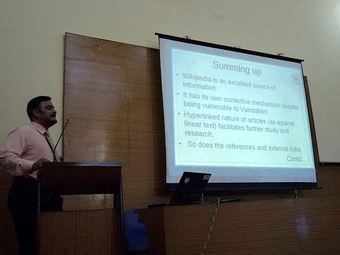
Concluding Your Speech
The conclusion of your speech summarizes your main points and purpose while leaving a lasting impression on your audience.
If your body is the meat and potatoes of your speech, then the conclusion is the icing on the cake. Your conclusion is delivered at the end of the speech and is often what most people remember immediately after your speech has ended. As important as your introduction is for grabbing the audience’s attention, the conclusion is doubly important as it leaves the audience with a lasting impression.
Summarize Your Main Points
The purpose of the conclusion is to summarize your main points and to prepare the audience for the end of your speech. You’ll want to recapture the essence of your speech: your main points and the purpose of why you spoke. It is especially important to remember that the conclusion of your speech is not the time to introduce new points or new supporting evidence; doing so will only confuse the audience. Try to think of your conclusion like tying a bow or a ribbon: it’s the final touch that makes your project stand out.
Paraphrasing Versus Repeating
While summarizing your main points is important, be wary of simply repeating your main points word for word. You’ll want to paraphrase your main points rather than directly repeat them from your speech’s body. Paraphrasing allows you to capture the essence of your speech, unlike rote repetition of identical sentences you may have spoken just minutes earlier.
End on a High Note
Your conclusion is the last thing your audience hears from you. Just as an introduction can make or break a speech, you always want to end your speech on a high note with something memorable. The conclusion is where you’ll insert your take-away message: what do you want the audience to remember after you’ve finished speaking? What do you want them to recall in the days or weeks after your speech?
To create a memorable ending, you may want to share a quotation or anecdote. It’s important to remain relatable and credible to the audience up until your final word, so be sure to craft your conclusion in a way that is still appropriate to the topic, audience, and venue.
Writing Your Conclusion
Like the introduction, you’ll want to write your conclusion last. The introduction and conclusion of your speech serve as bookends to your speech’s body, so it only makes sense that you’ll want to craft them after you’ve written your body.
Review your speech’s body and ensure that you’ve touched upon all the main points you wish to discuss, then rephrase those main points in your conclusion. Determine the take-home message that you want to leave with your audience and either include it word for word in your conclusion or use it as a guiding theme for how you’ll end your speech. If you have any final anecdotes or quotations to share that either drive home a particular point or capture the theme of your speech, include it here.
While there is no set time or sentence limit for your conclusion, make sure you don’t finish your speech so suddenly that your audience is caught off guard when the speech ends. Using trigger phrases such as “in conclusion” or “in summary” signify to your audience that the speech is about to end and that they should pay special attention to your final thoughts.
3.1.4: Transitions
Transitions allow your speech to flow smoothly from one section or point to another.
Learning Objective
List the different types of transitions used in speeches
Key Points
- Transitions are used to show the linkage or connection between main points.
- Types of transitions include temporal, equality, causality, compare and contrast, and summary.
- After you determine the main points of your speech, order them logically and then determine how you will transition from one point to the next.
Key Terms
- segue
-
To make a smooth transition from one theme to another.
- transition
-
The process of change from one form, state, style, or place to another.
Transitions: Find the Right Flow of Ideas

Giving a Public Speech
Your speech should flow logically and smoothly from one point to the next.
As you craft your speech, you will need to transition from one point to the next to fully articulate your purpose or objectives. When read aloud, your speech should flow smoothly from introduction to body, from main point to main point and then finally into your conclusion. Transitions are essential in order to help your audience follow along your line of reasoning.
Types of Transitions
There are different types of transitions often used in speeches, including:
- Temporal- using words like before and after
- Equality-highlighting points of equal importance like in addition or moreover
- Causality- using words that show cause and effect
- Compare and Contrast- using words and phrases that compare one part of the speech to the next, like contrarily or on the other hand
- Introductions and summaries are also types of transitions to let listeners know what a person will be speaking about and offering a way to understand the important parts of a speech
The Art of the Segue
To move from one point and into the next, you’ll want to segue into your new point. Sometimes your points may share similar themes or concepts – order your points in such a way as to capitalize on those similarities. You can also use opposition to present opposing main points. If you have multiple pieces of supporting evidence, you may need to transition between examples so that your audience knows you are furthering a point with another example, anecdote or set of researched data.
However you decide to transition, you’ll want to use triggering keywords that let your audience know you’re moving on to a new point. Ordinal words like “next,” “second and “third” give your audience the heads up that you’re about to proceed in a new or continued direction of thought.
Writing Transitions
After you have identified your main points and outlined what evidence you’ll use to support them, begin to prioritize and sort your main points so they follow in the most logical order. From there, you’ll be able to pinpoint how you’ll want to transition your speech from one point to the next. Try to think of transitions as a way to connect the dots of your speech’s purpose.
3.2: Steps of Preparing a Speech
3.2.1: Choosing a Topic
When choosing your speech topic, brainstorm to generate many ideas, and distill those ideas to find your singular topic.
Learning Objective
Discuss different strategies for choosing a speech topic
Key Points
- Before you can begin writing your speech, you must first establish the main topic about which you plan to speak.
- Brainstorm early and often! You can try a variety of techniques to get your mental juices flowing, from clustering to free writing. Even just talking through your ideas with another person as a sounding board is a great way to get ideas.
- Once you start to get an idea of your topic, do a little preliminary research. See what others may have written or said about your general topic; reading their ideas may help give you some new ideas or directions of your own.
Key Terms
- topic
-
Subject; theme; a category or general area of interest.
- brainstorming
-
A method of problem solving in which individuals or members of a group contribute ideas spontaneously.
- distill
-
To extract the essence of; concentrate; purify.
Example
- Let’s say you need to write a speech related to the history of television. Using clustering as a brainstorming technique, write the word “television” in a central circle. From that, begin to write a few spokes shooting off from that main circle, such as “great moments in television history. ” From each of those spokes, add additional smaller spokes, such as “the moon landing,” “the rise of 24-hour news coverage cycle,” and “Star Trek: The Original Series shows the first interracial kiss” under your “great moments in television history” spoke. From there, begin to refine and hone your ideas. To guide how you want to build your argument, you may want to do a quick internet search to get a feel for what others have said about some of your final topic choices.
Choose Your Topic

Clustering
An example of an idea cluster for the subject “gardening.”
As you begin to prepare for any speech, it’s important to pin down exactly about what you plan to talk. You might have been given a specific topic by a professor or supervisor, or you may be simply invited to speak at an event where the topic is up to you. Knowing how to carefully select your topic is an important first step in preparing for a successful speech.
Start by thinking about your venue. Where will you be giving your speech? To whom will you be speaking? (We’ll get to analyzing your audience in the next section. ) Then, start to think about what you know about the topic, and move towards those subjects or tangents about which you don’t know. It’s helpful to speak about a topic with which you are already familiar, but sometimes you may be called into situations where you have no prior knowledge about a given subject.
In either instance, it’s helpful to approach your topic through brainstorming.
Brainstorming
One of the best ways to help solidify your speech topic is to brainstorm. You can brainstorm by yourself, or you might want to bring in a few friends, colleagues or classmates to help you come up with ideas in a group setting. You can brainstorm using a number of different exercises.
Word Association
Start with a broad topic idea. What words, topics, or other subjects do you associate with that first topic? Now what words, topics, or other subjects do you associate with the following word? Continue this chain of word association to give you a broad spectrum of ideas.
Clustering
Also known as mind-mapping, clustering gives your word association a visual form. Start with your main idea and draw a circle around it, thinking of it like the hub of a wheel. Now, begin to write other associated ideas, topics, or subcategories related to that main topic around the hub, and connect them as separate spokes. From each spoke, begin to jot down other associated ideas and thoughts. As your cluster begins to grow, you might want to connect smaller spokes to one another and create new links between subjects.
Freewriting
This is probably the simplest brainstorm method of all. Set a timer and begin writing whatever thoughts or ideas come to mind about your particular subject. You might find it easier to type your freewriting instead of writing it by hand, so you can keep up with your thoughts faster. Whatever you do, don’t stop writing.
Another way of freewriting is to record yourself talking for a set period of time and then transcribing your key points to go back to and clarify later. Once your time is up, go back and highlight or circle relevant points or topics that stick out for you. You’ll refine these later.
Distill Your Ideas into One Topic
Once you’ve brainstormed your many ideas, it’s time to refine your ideas and distill them into one topic. Look for themes, patterns, and commonalities when going through your brainstorming notes. Use these themes to help guide you toward a singular topic.
Do a Little Homework
While you will definitely research your topic, you might want to do some “presearch” – that is, a little research before the real research. Do a quick scan to see what others have said or written about your topic. This might give you even more ideas of how to refine and distill your topic, or more appropriately adapt it to your audience or venue.
3.2.2: Analyzing the Who, Why, and Where
Knowing and understanding your audience is one of the most important parts of developing an effective speech.
Learning Objective
Indicate the factors speakers should keep in mind when assessing their audience
Key Points
- Take into account the demographics of your audience: gender, age, industry, the event at which you’re speaking, common interests, culture and ethnicity, and how much they already may or may not know about your speech topic.
- Never stereotype your audience based on any of their demographics.
- Be mindful of gestures, colloquialisms, idioms, or other ethnocentric expressions (slang, mannerisms, etc. ) you might make during your speech. It’s important to recognize what is accepted in one culture may be offensive in another.
Key Terms
- ethnocentrism
-
The tendency to look at the world primarily from the perspective of one’s own culture.
- demographic
-
A demographic criterion: a characteristic used to classify people for statistical purposes, such as age, race, or gender.
- stereotype
-
A conventional, formulaic, and oversimplified conception, opinion, or image.
Example
- Remember, context is key. If you were speaking to a large audience composed mostly of men, you might think talking about pregnancy and women’s health would be inappropriate. But let’s assume that this audience is actually at an obstetrics conference, where these subjects would be more than appropriate. That’s why it’s imperative to do your homework about your audience.
Analyze Your Audience

Knowing the Audience
A speaker should consider the audience in order to craft an effective and successful speech.
Once you’ve established your topic, it’s time to focus on whom you’re speaking to. Next to identifying your topic, understanding your audience is one of the most important things you can do in preparing for your speech.
Understanding Your Demographics
Think about your audience: what do they look like? What might they have in common? What might you have in common with them? These are important things to consider as you begin to get a sense of just who will be sitting in front of you when you deliver your speech.
Consider the gender of your audience: male, female, or a mix? Are they older, younger? Would you consider them your peers? Have you met any of them before? Think about all the possible demographics of your audience including gender, age, national origin, ethnicity, culture, and occupation. But remember: just because you might be speaking to one group of people, that doesn’t mean you should stereotype that group. In fact, if you do end up stereotyping your audience, you’re more likely to lose them than engage them.
Also think about the knowledge that your audience brings to your presentation. They might be extremely well-versed in or they might not have the faintest idea about your topic. The more you can tailor your speech to your audience, the more effective and persuasive your speech will be.
Tempering Ethnocentrism
You should know that in any situation, you bring with you your own unique world-view and set of biases. You should especially be aware of your unique world-view and biases in your speech because they may negatively impact people of different cultures, ages, genders, etc.
The same goes for the use of gestures or mannerisms. Some everyday gestures may actually be offensive to other cultures. For example, at any Disney theme park, all the workers, when giving directions to tourists and visitors, always point with two fingers instead of one. Pointing a single finger in some cultures is considered extremely rude.
Some idioms and expressions that may seem natural and make sense to you may actually be quite confusing to people of different cultures or languages. Try to take a step back and consider the ethnocentric view you may be bringing to your audience and consider ways to minimize or temper those unique perspectives so as not to alienate your audience.
3.2.3: Topic Research: Gathering Materials and Evidence
In order to fully substantiate any claims you make in your speech, you must fully research those claims and provide supporting evidence.
Learning Objective
Discuss how to best research and gather supporting materials for a speech
Key Points
- Make sure you find credible sources of information, whether they be from scholarly sources that have been peer-reviewed, or irrefutable facts.
- There are many places you can go to research; while the internet might seem like the easiest place to find information, you always want to double check to make sure those sources are accurate and credible.
- Don’t use research that might be outdated, particularly with regard to scientific or technological advances.
- Make sure you acknowledge your sources. You may not directly reference them in your speech, but if questioned afterward, you’ll want to know from where you found your information.
- Never copy information word for word and claim it as your own; this is plagiarism and erodes the ethical integrity of you, your speech, and your reputation.
Key Term
- plagiarism
-
The act of plagiarizing: the copying of another person’s ideas, text or other creative work, and presenting it as one’s own, especially without permission.
Research and Gather Your Materials

Research
Make sure you research and gather enough evidence and supporting materials in order to talk about the topic
competently.
Now that you’ve figured out your topic and given some thought as to who will be your audience, it’s time to roll up your sleeves and begin the real work of preparing your speech. In this section, we’ll discuss how to best research and gather your materials and supporting evidence.
Finding Credible Sources
The first instinct for many people preparing a speech is to go out and find every piece of information they can, often via search engines online. While this is a great way to “presearch,” you’ll want to really pay attention to the sources from which you’re gathering your information. If you want to successfully substantiate any claim in your speech, you’ll need to make sure you back it up with information from credible sources.
Just What Makes a Source “Credible”?
Typically, hard, irrefutable facts make for a credible source. Fact: the Earth is anywhere from 36 to 63 million miles away from Mars, depending on orbital locations of either planet. But if you have a claim that could stray anywhere into the realm of opinion (such as, the existence of extraterrestrial life in the universe besides that on Earth), you’ll want to make sure you have credible sources to back up that claim.
Many times, you’ll want to turn to scholarly sources. Academic journals and publications (particularly if they have been peer-reviewed) make for excellent scholarly sources. Additionally, there’s no reason that you can’t approach an expert in the field that you are researching. In the latter instance, this is considered a primary source of information and can sometimes help point you in the right direction to find other credible sources of information.
When in doubt, ask your friendly librarian. They can often point you to online journal collections or academic search engines where you can find reliable, credible sources.
Keeping Your Research Organized
As you begin to assemble your research, it’s imperative to keep your notes centrally located and easily accessible. You might want to create a binder to keep all of your papers and notes together, or dedicate a multi-sectioned notebook to your research. You might take notes on notecards, organizing them by color or heading. If you take your notes online, you can use cloud computing to store your research remotely to access them anywhere on the go. Other software exists to keep your notes files and organized electronically on your computer.
Always keep records of where you got your information. You’ll need this in case someone ever decides to question you about your facts after your speech. Also, this shows people that, yes, you’ve done your homework. Additionally, you should never copy any information word for word and claim it as your own. Plagiarism will only damage your reputation and the credibility and ethics of your speech in addition to potentially causing you to fail a class, lose your job, or worse.
However you organize your notes, just make sure you have them organized and handy. You never know when you might run into a primary source!
3.2.4: Developing Your Thesis
All speeches must have a point or a main argument – a thesis.
Learning Objective
Illustrate the best approach for developing a thesis for a speech
Key Points
- The main argument of your speech is your thesis statement: what case are you trying to make?
- If you are arguing for or against a certain idea, belief or topic, you must provide compelling evidence to support your position.
- When crafting your thesis statement, consider potential arguments, questions, or concerns someone with an opposing viewpoint may have. This process helps you develop a more robust thesis.
Key Terms
- thesis statement
-
A thesis statement summarizes a speech’s argument in one to three sentences.
- rebut
-
To deny the truth of something, especially by presenting arguments that disprove it.
Example
- Imagine you were writing a speech arguing which came first: the chicken or the egg? You take the position that the egg came first as your thesis statement. You would need to make a compelling to explain exactly why you believe the egg came first: perhaps you have data, statistics or other research to back up your claims. As invested as you might be in your thesis, don’t forget to consider the opposition. A “chicken first” believer would argue that it would be impossible for an egg to have come first, because it could not have gotten there without the chicken. Be prepared to rebut the other side.
Developing Your Thesis

Thesis
A painting depicting a lecture in a knight academy in the 1620s.
In some circumstances, you will most likely be arguing some kind of point or message in your speech. The main argument of your speech – the main point you want your audience to understand – is the thesis of your speech.
The Thesis Statement
In any opinion piece, written or spoken, the main argument – the thesis statement – comes at the beginning. You want your audience to know right away the point you are trying to make. It is important to remember that your thesis statement only addresses one main issue; the ways in which you choose to support your thesis add complexity and depth to your speech.
Arriving at Your Thesis
When composing your thesis statement, consider and answer the following questions:
- How do you feel about your topic?
- How does your audience generally feel about your topic?
- What do you want your audience to feel or believe about your topic?
- What other opinions have been said/written about your topic?
- Are you arguing for or against your topic?
- What social issues factor into your topic?
- What is your topic’s influence on the individual, a particular community or society as a whole?
As you begin to answer these questions, start thinking about ways you want to support your thesis with compelling, persuasive examples.
Playing Devil’s Advocate
No matter how you choose to argue your point, it is important to take a step back and play devil’s advocate; that is, take a look at your argument from that of the opposing viewpoint. By considering all sides of your argument, you will bolster your case by preparing for all possible objections and rebuttals to the claims you intend to make in your speech.
3.2.5: Supporting Your Ideas
Use a variety of ways to support the ideas and claims that you make with your thesis statement to give your speech depth and dynamics.
Learning Objective
Explain how to use ideas and examples to back up claims in a speech
Key Points
- Set the stage for how you plan to address your argument and make your case by laying out the exposition of your argument.
- Appeal to your audience’s core beliefs, goals or common interests to influence your audience by persuasion.
- If you are speaking to a sympathetic crowd, consider influencing your audience by suggestion or popular sentiment on your given topic.
- Use personal narratives and anecdotes to make your case if appropriate to your audience, topic, and speech venue.
- If your idea is complex, consider breaking it down into simpler parts to more thoroughly and easily describe your idea. Help your audience to visualize your points by articulately describing them.
Key Terms
- exposition
-
The act of declaring or describing something through either speech or writing.
- anecdote
-
An account or story which supports an argument, but which is not supported by scientific or statistical analysis.
Example
- Let’s say you have to give a speech about civil rights in America and how your audience must take active roles in protecting their own civil rights as well as the rights of others. You might begin by laying out a foundational overview of the historical timeline of civil rights since America’s independence in 1776. Persuade your audience by sharing compelling examples of how civil rights have been violated across many groups: gender, race, religion. These broad appeals are sure to resonate with many different members of your audience. You may also provide examples that all get back to your same idea: infringing upon any civil rights by any group to any group is wrong. You might share how a relative was involved in the Mississippi riots in the 1960s or how your mother was involved in the Women’s Liberation movement in the 1970s. Finally, walk the audience through the basic principles of your argument about how the infringement of civil rights for one group can ultimately lead to the infringement of civil rights for all.
Supporting Your Ideas

Preparing Supporting Ideas and Materials
It’s important to select the right evidence and supporting materials to help you establish the main points in your speech.
Once you have solidified your position in your thesis statement, you want to back up your thesis with a variety of supporting ideas and examples. To do this, there are several ways you can support your claims while adding variety and interest to the overall story of your speech.
Set the Stage
Using exposition is a great way to get your audience all on the same playing field. When you use an expository approach, you’re carefully laying out all of the background information your audience needs to know in order to understand your point.
Appeal to Commonalities
As you notice commonalties between audience members, the audience and your topic, and you and your audience, appeal to those commonalities to not only establish rapport but also to more easily persuade them to your thesis and claims. Your audience is more likely to trust and believe you if they feel they share something in common with you and your topic.
Finding a Consensus
Your audience may already feel a certain way about your topic. Depending on what you’re trying to argue, you may want to go ahead and appeal to that consensus. Just be careful: you don’t want to bore your audience by “preaching to the choir. “
Tell a Story
One of the best ways to back up your claims–besides cold, hard, facts and data–is to share a personal story or anecdote. This shows your audience that you really connect to your subject, making you more believable and personable. Using anecdotes are a perfect opportunity to lighten the mood and add some humor as appropriate to your speech.
Deconstruct Your Topic
You might have a particularly complex subject or thesis. In these instances, it’s helpful to break it down into its simplest parts. By breaking your information down into bite-sized chunks, your audience may have an easier time of following your train of thought or logic.
3.2.6: Organizing and Outlining the Speech
Arrange your speech – your thesis, additional points, and supporting evidence – in a way that will make sense to your audience.
Learning Objective
Discuss best practices for organizing notes and research into one speech
Key Points
- To organize your thoughts, consider giving each point or supporting evidence its own note card. Begin to arrange them according to importance and your main points will begin to emerge.
- Outlines typically begin with your thesis and end with any concluding thoughts.
- Depending on your topic or thesis, arranging your points chronologically is an effective way to establish a timeline of your argument.
- If giving an informational speech, you might describe your subject as parts of an object, outlining each part or section.
- You can move from broad points to specific points, or vice versa, depending on the effect you are trying to achieve and the argument you are trying to make.
Key Terms
- thesis
-
A concise summary of the argument or main points, usually one to three sentences long.
- chronological
-
In order of time from the earliest to the latest
Example
- When giving a speech on the history of television, you might organize your points chronologically by starting with the invention of motion pictures, to the invention of the television, through to modern internet streaming video today.
Organizing and Outlining Your Speech
Now that you have decided on your topic, analyzed your audience, arrived at your thesis, and determined how you will support your claims, it is time to organize your notes and research into one coherent speech.
You did keep all of your notes centrally collected and easily accessible, right? If you put all of your research notes and thoughts onto notecards, it is particularly helpful to lay them out in front of you and begin to organize your points and sub-points in ways that make the most logical sense.

Organizing Your Ideas
It’s important to develop an outline and clearly explain your ideas.
What are some ways to establish logical order?
Establish a Timeline
Depending on your subject and the point you are attempting to make, it might make sense to order your research and points in chronological order. If you are giving a speech on the rise and fall of the Roman Empire, it makes sense to start with its rise, and end with its fall. Outlining your speech as a series of chronological events or points allows your audience to follow along a linear timeline for easy understanding of your subject matter.
Your Thesis as the Sum of Its Parts
Think of your thesis like a machine. Each claim is another cog, each example or supporting evidence another lever in that machine, all working together to arrive at the same persuasive conclusion. Sometimes it is helpful to break up your thesis into each of these smaller parts, to make the information more easily digestible for your audience.
The Broad and the Specific
Building on the idea of your thesis as machine, you may present your overall, broad idea, then break it down into smaller, logical steps to reach that big idea. Conversely, you may start with smaller ideas and expand into the bigger, broader idea. When constructing your arguments from smaller ideas, you are more likely to drive your point home with a broad, sweeping finish. On the other hand, you can dilute the complexity of a broad idea by breaking it down into smaller, logical pieces of information.
A Sample Outline
Here is a sample outline about issues of feminism in William Shakespeare’s Hamlet:
I. Introduction and Thesis: Brief description of issues that arise when reading “Hamlet”
II. Issues of feminism uncovered through reading “Hamlet”
a. What other scholars have discovered about feminism in “Hamlet”
b. Which of these discoveries was most evident
c. Ideas of feminism I uncovered on my own
III. How uncovering ideas of feminism in “Hamlet” has led me to better understand what Shakespeare thought of the role women played in society
IV. Conclusion
3.2.7: Wording the Speech
A good speech is not written in one sitting; write multiple drafts, then review and edit before settling on a final text.
Learning Objective
Discuss tips and tricks for drafting a speech
Key Points
- Use the ABC approach to begin your first draft. The Abstract explains your thesis. The Body features your main points and supporting evidence. The Conclusion contains your final thoughts and reiterates your point.
- Make sure to have all of your notes and research close by and easily accessible so you can turn to your sources as often as you need to while your draft your speech.
- Editing and revising are not the same thing. To edit, review your speech for changes. To revise, actually implement those changes. Editing and revising are cyclical in nature as you continue to hone your draft.
- If on your first draft you find yourself going off on a tangent, allow yourself to follow it. You can always edit, revise and remove sections later that are wordy or off-topic.
- Writer’s block can happen to even the best writers. Take a break for a few minutes and come back to your speech renewed and refreshed. But don’t stay away too long or you might lose your momentum.
Key Terms
- writer’s block
-
The inability to begin or continue work on a piece of writing; normally temporary.
- eloquence
-
The quality of artistry and persuasiveness in speech or writing.
- abstract
-
Difficult to understand; abstruse.
Find the Right Wording for Your Speech

Drafting Your Speech
Handwritten speech notes by President Ronald Reagan
The art of public speaking comes from the eloquence of the speaker. While researching your subject and outlining your speech may seem like the most time-consuming aspect of preparation, taking the time to write your speech can actually take the most time to complete.
Writing Your First Draft
When you begin writing your speech, don’t assume what you write now will be the final version of your speech. A draft is simply your first pass at what you plan to say. Using your outline as a guide, refer to your organized research notes (that you’ve centrally collected and have easily accessible for just such an occasion, right? ) to begin to flesh out your speech.
It is helpful to take an ABC approach to writing your speech. Introduce your subject and thesis in an Abstract, or introduction, section. This abstract gives a general summary about what you plan to speak. Then write your Body, where you will make and substantiate claims to support and argue your thesis. Finally, write your Conclusion, tying it all together in one memorable finish.
You may find that you start to veer off-topic as you begin to write your speech. You will have time to go back and prune later; for now, the focus is to keep writing.
Refine, Refine, Refine: Editing and Revising
Now that you have written the first draft, reread what you have written to refine your wording.
Editing
Read through your first draft. Look for typos such as spelling and grammatical errors. Also look for awkward phrasing or parts of speech. Read sections aloud: do they make sense? If so, reword those sections.
Consider the vocabulary you are using: Is it appropriate? Are you potentially using language that may go over your audience’s heads, or perhaps is too elementary? Consider your tone, style and verbiage. Also consider the structure of your argument: does your speech actually make sense?
It is helpful to give your first draft to another person to review and edit, as it helps to have a fresh set of eyes look at your material.
Revising
Once edits have been made, implement those suggestions and changes to your draft. When you begin revising, you may find that you are making more changes along the way and may write multiple drafts. The editing and revising process becomes a cycle of newer drafts. Eventually, the revisions will be done and you will have settled on your final draft.
Dealing with Writer’s Block
Have you ever sat down in front of your computer, a blank document open, the cursor just blinking at you…and no words come to your brain? Don’t panic! It is a harrowing moment for any writer, but don’t be alarmed: writer’s block is perfectly natural and there are ways to overcome it.
Some tackle writer’s block by forcing themselves to write anything, as long as they keep writing. You can set a timer and commit to keep writing without stopping until that timer ends. Hopefully, that will be enough of a boost to get your writer’s juices flowing.
If not, walk away from your speech for a little while. Sometimes it is good to clear your mind from a subject in which you are thoroughly engrossed in order to gain a fresh perspective.
When in doubt, two heads are better than one. Call up a friend, colleague, or classmate and share ideas with them. They just might have the inspiration and outside perspective you need to get your hands flying across your keyboard in no time.
3.2.8: Preparing to Present
Practice makes perfect!
Learning Objective
Discuss the different methods for preparing for and presenting a speech
Key Points
- Determine how you will present your speech: will you read it verbatim, memorize it, or read from an outline of notes?
- Reading verbatim has both its positives and negatives. On the plus side, you’ll have your entire speech written out in front of you; however, these types of speeches tend to feel a bit stilted to audience members.
- Memorizing your speech can seem like a weighty task, but it allows you to retain all of your key points and wording while still appearing natural and effortless to your audience. It frees you from having to read right off of a manuscript.
- When speaking extemporaneously, you can have a rough outline of your notes. You might have this on a single sheet or perhaps across several notecards. In either case, these serve as reminders about your topic, your points and in what order they should be shared.
- If you’re nervous about presenting in front of a group of people for the first time, work out your nerves by asking a small group of friends or colleagues to be your test audience. Your test audience can give you immediate feedback on what you did well and how you could improve.
- Ever wonder what you look like while giving a speech? Practice in front of a mirror, or better yet: record yourself. You’ll be able to see if you have any unconscious gestures or habits that you can correct or prevent as you feel them happening.
Key Terms
- extemporaneous
-
A type of speech delivery which involves preparation of speaker notes prior to delivery, associated with conversational style of delivery.
- verbatim
-
A word-for-word report of a speech.
Example
- There’s a famous old joke: how do you get to Carnegie Hall? Practice! There’s a lot of truth to be found in that old adage. The more you can give your time to practice and rehearse your speech, the more comfortable you’ll be. You might feel nervous for your first few speeches but over time and with experience, those nerves will fade. That said, you don’t want to rehearse so much that your speech feels robotic or rote. You should appear natural and comfortable in front of your audience, whether it’s your first speech or your fiftieth.
Prepare to Present

Practicing Your Speech
Take the time you need to rehearse and prepare your speech before getting up in front of your audience.
You’ve written your speech: congrats! Now it’s time to work on just how you plan to present your speech and prepare it accordingly. First, decide how you’ll present your speech: will you read your newly minted speech verbatim from script? Or will you memorize it? Or will you simple read off an outline or notes?
Reading Your Speech Word for Word
For your first speech, it might be helpful to have it completely typed up and ready for you to read verbatim in front of a crowd. You may feel more confident having your exact wording in place assembled right there in front of you.
Reading verbatim from a script has its drawbacks; you may be limited in how much eye contact you can engage in with your audience. As such, your audience may more quickly disconnect from your words and you as speaker. Additionally, speeches read straight from a script or manuscript often feel stodgy and stilted, which is a sure way to bore your audience and lose their attention fast.
Memorizing Your Speech
You can memorize your speech in the same way that you might memorize lines or a monologue for a theatrical play. By freeing yourself from reading off a sheet or many sheets of paper, you lose some of the rigidity that comes with reading a speech off a script. There’s less for your hands to fumble with, allowing you to take a more open body position as you deliver your speech, making you more engaging with your audience.
However, one of the biggest disadvantages to memorizing a speech can be unexpected stage fright where you might clam up entirely, unable to remember your speech. It never hurts to have a copy of your speech on hand when you plan on memorizing your speech.
Speaking Extemporaneously from Notes
The middle ground between reading from script and memorizing your speech is to read from notes. By preparing an outline or a few note cards with keys points in the order you plan to present them, you have the freedom to have open body posture with a safety net of reference. Speaking from notes sometimes involves keeping your hands busy holding the notes and it does draw your eye contact periodically away from the audience. The tradeoff is worthwhile because it allows you to have an engaging stance combined with an outline of your speech.
Dealing with Nerves
It’s completely normal to be nervous about giving your first speech in front of a large group of people. Even world leaders get butterflies in their stomach before addressing the world stage. To help combat your fears, just remember: if you flub your speech it’s probably not going to kill you, so why stress?
You can also ease your fears by taking the time to practice frequently. Read your speech out loud so you begin to develop muscle memory around your phrases and sentences. You can even read your speech in front of trusted friends or colleagues. By practicing in front of a smaller group, you can take the edge off having to present in front of a larger group. Additionally, having your friends as the test audience will give them an opportunity to provide you with valuable feedback about what you’re doing well and where you need to improve.
If you’re not sure what you look like while speaking, practice in front of a mirror. Better yet, record yourself and play back the recording a few times to yourself. Watching yourself speak is another great way to help calm your nerves and break the tension while discovering subtle facial movements or body language that might actually hurt your speech.
3.2.9: Delivering the Speech
Details like how you dress, enunciate, and use body language can be just as important as what you say.
Learning Objective
Give examples of tactics speakers can use to deliver a speech effectively
Key Points
- Make sure you dress to impress. While some speeches may be delivered in a casual setting, you want to make sure you’re wearing clothing appropriate to the dress code of your event.
- Be aware of your body language. A closed body position (arms crossed, shoulders hunched) and lack of eye contact will make it extremely difficult for your audience to engage with you.
- Engage your audience by making eye contact with them. If making eye contact wigs you out, you can always look just above their heads to give the same effect.
- Stand up straight, remember to breathe, and limit your “um”s, “uh”s, and “like”s. Use whole phrases like “should have” instead of “shoulda. ” Avoid slang or profanity.
- Have a backup plan in case equipment fails for things such as visual aids, PowerPoint presentations, or teleprompters.
Key Term
- body language
-
Body language is a form of mental and physical ability of human non-verbal communication. It consists of body posture, gestures, facial expressions, and eye movements. Humans send and interpret such signals almost entirely subconsciously.
Delivering Your Speech

Delivering a Speech
A woman delivers a speech at a TEDx event.
The big day has arrived: it’s time to present your speech! Besides remaining calm and speaking clearly and at a loud enough volume, here are the most important things to consider as you present your speech.
Dress to Impress
The way you look as you give your speech is almost as important as the words coming out of your mouth. It’s imperative to know the dress code for the event at which you’re speaking. If you’re the best man at your best friend’s wedding, you will probably be wearing a tux. Unless of course it’s a beach wedding, when flip flops and shorts could be totally appropriate.
In a business setting, men should wear a button-down shirt and dress pants and shoes; depending on how formal the business setting, this may also include a suit jacket and tie. Women should wear a dress, dress pants or skirt with a button-down top, blazer, blouse or nice sweater. Shoes can be heels or flats and should be appropriate to your setting.
For men and women, it’s also helpful to consider how long your speech is and if you’re expected to stand for the duration of your speech when determining appropriate yet comfortable footwear.
Watch Your Body Language
In the same vein that how you look is almost as important as what you say, how you stand can be just as important as your words. Humans pick up subtle cues with regard to emotion through non-verbal communications in body language. When delivering your speech, you want to make sure you have a confident, open stance to convey your confidence. Standing hunched over or with your arms crossed will close off your body to your audience, thereby shutting them out.
Similarly, make eye contact with your audience. Sometimes this makes speakers nervous, but it’s an important technique to really connect with your audience. If the idea of making direct contact makes you uncomfortable, you can always scan your view around the room looking just above your audience’s heads; it achieves the same connective effect.
Finally, if you can move around, do. It builds visual interest for your audience and also helps you to work out jitters if you have them. You might be confined behind a podium or lectern, in which case your largest range of motion may be restricted to hand gestures and your gaze around the room. If you can walk out from behind a podium and across a stage, take the opportunity. Just don’t wander, watch where you step, and try not to make your audience motion sick by walking back and forth too much.
Articulate and Enunciate
Speak your words clearly. Don’t rush your sentences or let the ends of your sentences drop in volume. You’ve worked this hard to write and prepare your speech–you want to make sure your audience understands what you have to say.
Avoid saying “um”, “uh”, or “like” (when it doesn’t belong in a sentence). These are usually nervous habits that take time to break. If you feel an “um” coming on, simply pause for a brief moment before moving past it. Additionally, don’t be afraid of silence when you’re making a dramatic or compelling point. And sometimes, be prepared for your audience to interrupt you with clapping or laughing. You might need to stop a sentence to let the audience do its thing while you resume as it dies down.
Have a Backup Plan
If you have supplementary materials such as visual aids or a PowerPoint presentation, have a backup plan in place in case some piece of equipment doesn’t work. You may want to have printouts just in case a computer or projector doesn’t work.
Similarly, if you’ve memorized your speech or may be reading from a teleprompter, have a printed copy of your speech or an outline of your speech on hand just in case you get a case of stage fright or equipment fails.
One More Thing
Before you walk off that stage or sit back down in your seat, always thank your audience.
Chapter 2: Public Speaking Ethics
2.1: Significance of Ethics in Public Speaking
2.1.1: The Importance of Studying Ethics
It is important to practice ethical behavior in your speeches, as it helps to establish trust with your audience.
Learning Objective
List the qualities of an ethical speaker
Key Points
- To speak ethically is to provide honest facts with integrity and without deception or distortion.
- Ethical speakers craft their own original content that is free from plagiarized content.
- Ethical speakers do not intentionally deceive their audiences, either by presenting falsehoods, or opinions disguised as fact; or by warping the facts to make their points.
- Ethical speakers acknowledge any conflicts of interest they may have with regard to topic, intent, venue, sponsoring organization or audience members.
Key Terms
- conflict of interest
-
A situation in which someone in a position of trust, such as a lawyer, politician, or director of a corporation, has competing professional or personal interests.
- ethics
-
The study of principles relating to right and wrong conduct.
Example
- On the NPR radio show, “On Point with Tom Ashbrook,” the host often brings in political analysts to discuss national political issues. Occasionally, his guests may disclose the fact that they work with sponsors of that radio show. By disclosing this mutually beneficial relationship between the radio show and the guest, both the show and guest demonstrate an ethical behavior.
Why Study Ethics?

Ethics
American philosopher Thomas Nagel teaching an undergraduate course in ethics at New York University.
What is Ethics?
When you think of ethics, what comes to mind? Perhaps you think of words and phrases such as ethical behavior, professional ethics, ethics boards, or code of ethics. At its heart, ethics refers to the concept of having morally acceptable values and behaviors. When you align your behaviors and actions with these values, you engage in ethical behavior.
Ethical Behavior in Public Speaking
Why would you need to even consider ethics in public speaking? First and foremost, your audience not only needs to believe in your words and message, but they need to trust you as the message giver. To engage in unethical behavior when speaking only erodes that trust.
There are other reasons to engage in ethical behavior in public speaking:
- To maintain your credibility and reputation.
- To present a fair and accurate argument of your thesis.
- To provide honest facts with integrity and without deception or distortion.
- To abide by shared or common moral values and beliefs.
To speak ethically is to use your own original speech content. If you use any substantiating facts or passages from another, you must give appropriate attribution or credit as necessary. Ethical speakers are ones who do not plagiarize their material or try to pass off words and ideas from others as their own.
Ethical speakers do not deceive their audience. It can also be stated that ethical speakers do not distort or warp facts, or worse yet, disguise opinions as fact in order to argue their thesis or make their point.
Acknowledging and responding to conflicts of interest is also regarded as ethical public speaking behavior. There may be times where you may be asked to speak on behalf of a certain topic in which you have a professional interest or may benefit from financially. In those instances, the ethical speaker will either excuse him or herself from speaking. If unable to do so, he or she may simply disclose the nature of the conflict of interest so that everyone is on the same page.
The study of ethics, then, is incredibly important to any student of public speaking, as the most effective public speakers are those who practice ethical behavior in their speeches.
2.1.2: Rules to Follow When Speaking
Effective speakers engage in ethical goals, fully prepare their speeches, practice honesty and avoid abusive language.
Learning Objective
State the basic rules of crafting and delivering a speech
Key Points
- If you recognize that you might have a conflict of interest when delivering your speech, recuse yourself or disclose to your audience the extent of the conflict.
- Respect your audience by fully preparing for your speech, from writing and editing to reviewing and rehearsing. Be thorough in your preparation.
- Don’t make your case via falsehoods or opinions disguised as facts. Come from a place of authenticity.
- Don’t intimidate your audience or opponent (if debating) by verbally attacking them or using abusive language.
- Choose either the persuasive or informative presentation style for each speech based on presentation goals and audience type.
Key Terms
- conflict of interest
-
A situation in which someone in a position of trust, such as a lawyer, insurance adjuster, or corporate executive, has competing professional or personal interests.
- ethical
-
Of or relating to the accepted principles of right and wrong, especially those of some organization or profession.
- recuse
-
to declare oneself disqualified to act.
- informative
-
An informative presentation enhances the knowledge or understanding of the material you present,be it information, concepts, or ideas. The presenter assumes the role of a teacher.
- persuasive
-
A persuasive presentation has a clear beginning, middle, and end; uses interesting supporting material; and changes or reinforce listeners’ feelings, ideas, or behavior.
Rules to Follow When Speaking

Rules for Public Speakers
Effective speakers engage in ethical goals, fully prepare their speeches and materials, practice honesty, and don’t use abusive language when speaking.
As a public speaker, it’s important to follow some basic rules as you approach the crafting and delivery of your speech. These rules include ethical goals, full preparation, honesty, and non-abusive language.
Ethical Goals
Consider why you’re speaking. Are you trying to persuade your audience to adopt a certain viewpoint or consider a new idea? If so, you’ll want to make sure that you lead your audience to that belief point in an ethical manner. You don’t want to use tactics like intimidation. Additionally, have the responsibility and professionalism to know whether or not you have a conflict of interest on a given topic or with a certain audience or venue. Recuse yourself–provide your audience with a full disclosure of said conflict of interest, and adjust your speech accordingly.
Full Preparation
Effective speakers are those who take the time to fully prepare their speeches, from the speech writing process to the delivery of the speech to the very clothes they wear for the speech. If you don’t prepare, it will show and ultimately affect your credibility as a speaker to your audience and colleagues. Respect your audience by taking thorough time to write, edit, review and rehearse your speech before presenting.
Honesty
Honesty is an extension of the ethical goals of your speech. Don’t resort to falsehoods or opinions presented as facts to make your case. Come from a place of authenticity instead of deception. Your credibility can become damaged when it is revealed you have either lied or even just slightly bent the truth in your speeches.
Non-Abusive Language
Just as one shouldn’t intimidate his or her audience, one should refrain from abusive language when speaking in public. This means attacking your audience verbally, or, in a debate-style setting, even verbally attacking your opponent. Don’t resort to name-calling or bullying; rather, make your case through the use of compelling facts and anecdotes that can be substantiated.
2.1.3: Rules to Follow When Listening
Develop a practice of active listening to be an effective listener.
Learning Objective
Discuss the qualities of an active listener
Key Points
- Presenters deserve your attention, courtesy, and open-mindedness if you are to expect the same of others once you get up to present.
- Be courteous by silencing your cell phone or other gadgets, refraining from extraneous noise, and looking at the presenter while they speak. If you’re taking notes, make sure you’re doing so in an unobtrusive way.
- Have an open mind about what material is presented to you. You may not agree, but the presenter still deserves your attention and courtesy.
Key Terms
- open-minded
-
Willing to consider new and different ideas or opinions.
- active listening
-
The process of attending carefully to what a speaker is saying, involving such techniques as accurately paraphrasing the speaker’s remarks.
Rules to Follow When Listening
You may not always be the speech presenter or speaker. Many times, you’ll be in the audience yourself. Active listening is a skill that can make you a more effective speaker in the long run.

Active Listening
The art of active listening is more than just hearing what the speaker has to say: it’s about being an engaged, attentive listener able to paraphrase what has already been said.
Courtesy
Being an active listener not only makes you a more engaged audience member but, quite simply, it’s polite. If you expect people to pay attention to your words when it’s your turn to speak, they expect the same from you. There are a number of other courteous behaviors that an active listener should practice:
- Look at the presenter.
- Do not text or chat on your phone while they speak.
- Remain quiet.
- If taking notes, either on paper or via a laptop or tablet, do so unobtrusively.
Attention
Active listening refers to the practice of not just hearing someone, but really listening and paying attention to what they have to say. Intrinsic to active listening is the ability to feed back what has been said to the speaker, often in the form of paraphrasing. As an audience member, you might not have the opportunity to actually verbalize these feedback in the moment; however, a true active listener is able to summarize at the completion of the speech.
Open-Mindedness
You may not necessarily agree with everything that is being said. It’s important to come to the presentation with an open mind—that is, to at least listen with respect and courtesy to ideas that may be in conflict with your own personal beliefs and values. Again, if you expect others to be open and receptive to your ideas, you must extend that same courtesy to others.
2.2: Plagiarism
2.2.1: Plagiarism
Plagiarism involves the taking of someone else’s words or ideas and trying to attribute them as your own.
Learning Objective
Describe the different forms of plagiarism
Key Points
- Word to the wise: just don’t plagiarize. Seriously. Don’t do it.
- Intentional plagiarism isn’t as easy to get away with as you think: institutions and companies have ways of detecting whether or not you’ve plagiarized your work, and it can have serious academic and professional repercussions if you are caught.
- If you find yourself tempted to nab a couple of lines from one of your research sources, put the full source away. Instead, rely on your own notes and paraphrasing to lessen the temptation to outright copy the work of another.
Key Term
- plagiarism
-
The act of copying another person’s ideas, text, or other creative work, and presenting it as one’s own, especially without permission.
What is Plagiarism?

Plagiarism
Plagiarism is stealing, plain and simple.
When most students think of plagiarism, they may think of outright copying another’s works. However, plagiarism can delve into murky territory that includes everything from wrongful appropriation to blatant thievery. While plagiarism may not be a crime per se, in many academic and professional contexts, plagiarism carries with it serious risks, including expulsion and/or termination from a position, organization, or company.
In its simplest form, plagiarism occurs when someone takes the words or ideas of someone else and attempts to present them as their own. Appropriating a person’s work without proper credit is what distinguishes plagiarism from mere citation or quotation. When a writer quotes or cites a person, text, image or other piece of intellectual property, the writer must give credit to where or from whom the quote or idea originated.
The “ideas” part of plagiarism can be especially tricky. Though unlikely, two completely different people may produce the exact same idea at the exact same moment. Inevitably, one person would be guilty of plagiarism. And while this does happen, the instances are few and far between.
Deliberate plagiarism should be avoided in academic and professional settings. To knowingly take the work of others and attribute it as one’s own is widely regarded as unethical, unprofessional, and illegal across most industries and organizations. Many academic and professional services can detect whether entire sections of books, articles and other works are published elsewhere, particularly on the World Wide Web. Additionally, if a writer has a unique writing style and author’s voice, it can be even easier to identify plagiarism if the content is cut and pasted into a work with a completely different tone and style.
However, unintended plagiarism is more common that one might think. Sometimes the problem stems from working too closely with source material. To avoid unintended plagiarism, writers often develop new content with the aid of notes, as opposed to whole sources such as books, articles, or web pages. Writers also craft original compositions by working off their own notes and paraphrasing.
2.2.2: Avoiding Plagiarism When Using the Internet
In the age of the Internet and social media, it can be both very easy and very tempting to plagiarize. In short: don’t.
Learning Objective
State why plagiarism can be easily detected online
Key Points
- Just because you can copy and paste a few sentences or paragraphs from an obscure Internet source doesn’t mean you should.
- Many academic institutions and even some professional organizations use online plagiarism detection software, such as CopyScape, Attributor and PlagiarismDetect.
- Just because you might thwart an online plagiarism detector doesn’t mean you don’t run the risk of being caught via manual plagiarism detection, either.
- When in doubt, avoid the temptation to plagiarize despite the seemingly endless availability of content online. Your speech is better served when your words are original and genuine.
Key Term
- plagiarism
-
The act of plagiarizing: the copying of another person’s ideas, text or other creative work, and presenting it as one’s own, especially without permission.
In Haste? Don’t Copy and Paste.
When pressed for time with a looming deadline, you might think a quick copy and paste of a few sentences here or maybe a paragraph there might be an easy solution. While it certainly is easy to Control+C, Control+V your way through a speech, it’s certainly not wise.
It might be tempting to fire up your browser and pick a relevant source buried deep within the search results. “Who looks all the way at what’s on search page 10? ” you may be thinking. Just because it’s obscure doesn’t mean it’s okay to take it and claim it as your own.
If you get caught, you could face serious academic or professional consequences. Plus—on a very plain note—it’s just not cool. It’s just bad intellectual form. In the age of the Internet, as easy as it can be to just lift something from a relevant but obscure source via Google, it’s equally as easy to get caught plagiarizing the words of others.
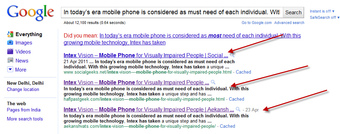
Avoiding Plagiarism on the Internet
As tempting as it might be to plagiarize with the vastness of available sources on the Internet – don’t do it.
Yes. Yes, You Will Get Caught.
With the advent of complex, proprietary search engine algorithms has come another niche market: plagiarism detection. If you think you can get away with just borrowing a sentence here or there, beware: sites like CopyScape and Plagiarism.org’s software can be used by academics and professionals alike, running your work through their programs to see if anything comes up with a red flag.
And if you think you can fool plagiarism detection software, don’t count out manual checking, either. You might pull a sentence or idea from an obscure professional or expert in the field, but keep in mind that your professor is an expert in this field; he or she is likely to have read whatever you’re copying.
When in doubt, avoid the temptation to plagiarize despite the seemingly endless availability of content online. Your speech is better served when your words are original and genuine.
Chapter 1: Introduction to Public Speaking
1.1: Learning How to Speak Publicly
1.1.1: Learning How to Speak Publicly
There are a variety of traditional and nontraditional avenues available for you to learn about public speaking.
Learning Objective
Find ways to improve your public speaking skills.
Key Points
- You can learn about public speaking through organized learning opportunities, such as classes and organizations like Toastmasters International.
- If you prefer to learn at your own pace, you can read books about public speaking. Many are available at little or no cost.
- If you prefer one-on-one guided learning, consider hiring a public speaking coach.
- For an even more nontraditional approach, the Internet is rife with free materials, guides and videos to help you learn more about speaking in public.
Key Term
- Toastmasters International
-
Toastmasters International (TI) is a nonprofit educational organization with clubs worldwide. They help members improve their communication, public speaking, and leadership skills. Through its thousands of member clubs, TI offers a program of communication and leadership projects designed to help people learn the arts of speaking, listening, and thinking.
When you see politicians and other speakers addressing a crowd with ease and eloquence, it seems as though they were born to speak in front of people. The truth is, public speaking is an art learned over time, and with practice, there are many ways to learn it.
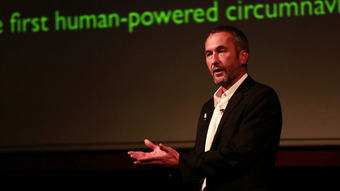
Public Speaking
Adventurer Jason Lewis speaking publicly at the Royal Geographical Society in London
If you’re using this online textbook to support material you’re learning in a class, you’re already engaged in one of the basic ways of learning to speak in public. Classroom learning is one of the most common ways for students to learn about communications and public speaking. With guidance from a dedicated teacher, along with accompanying texts, supporting materials, and in-class practice, your basic public speaking course will prepare you to make your first big speech.
Take a Class
If you’re not taking a class, you might find structured learning opportunities through clubs and nonprofit organizations such as Toastmasters International. Toastmasters focuses on the art of public speaking, communication, and leadership skills. They offer a variety of programs, competitions, and conferences to help people like you become better public speakers.
Hit the Books
If you don’t have time for a class and would like to learn more about public speaking at your own pace, consider visiting your local library to find print or digital books on public speaking. Many are tailored to specific types of public speaking (such as political or business) and are often available at little or no cost.
Learning Outside the Box
If reading a book or attending a class still seems too formal, there are plenty of other ways to learn about speaking in public. You might benefit most from personalized, one-on-one attention and directed learning. In this case, consider hiring a public-speaking coach. These individuals are often certified to give personal training and attention to individual clients. Conduct research to learn about their experience and training, and ask to speak with some of their other clients. You can also “hire” a virtual coach by looking for public speaking skill-training videos online, using sites such as YouTube or eHow. Videos about public speaking can give you all the benefits of personalized coaching but from the comfort of your own living room. When looking for videos on public speaking, try to learn what you can about the people producing these videos: What experience and credentials do they have? Are they created by a single person, or the work of a professional company or educational institution?
The benefit of all these ways of learning about public speaking is they all complement one another. If you’re feeling deficient in one skill set after using a certain learning method, turn to another method to bolster your knowledge. Keep in mind, practice is the best way to improve your public speaking ability. Take every opportunity you can to speak in front of an audience to boost your confidence, as well as your skill.
Regardless of the method you choose to learn about public speaking, go in with an open mind and an eagerness to learn. This will allow you to get the most from your curriculum, no matter how it’s constructed or delivered.
1.1.2: Best Practices in Public Speaking
Your public speaking can be improved through various practices both before and during the speech.
Learning Objective
Discuss the high-level best practices for giving a speech
Key Points
-
Construct a well-organized speech with an engaging
topic and a clear theme in order to hold your audience’s attention. -
Build confidence beforehand through rehearsal, and
use techniques such as meditation to reduce anxiety. -
When delivering the speech, keep in mind how your
vocal delivery and visual appearance can enhance your message. -
Consider the background of the audience before the
speech, and the reactions of the audience during the speech.
Key Terms
- topic
-
Subject; theme; a category or general area of interest
- audience
-
One or more people within hearing range of some message; for example, a group of people listening to a performance, speech etc. ; the crowd attending a stage performance.
Writing
the Speech
Good public speaking begins with the content of the
speech itself. The first thing you should consider is the topic, or subject, of
the speech. Choosing a topic that is relevant to your audience’s interests will
help you keep them engaged. Once a topic is chosen, narrowing down the focus of
the topic will allow you to cover more detailed information, and your audience
should find the speech easier to follow as a result. When writing the speech,
keep the purpose of your words in mind. Do you want to inform your audience of
something, or do you want to persuade them to your side of an argument?
Creating a well-organized speech that introduces a topic, emphasizes a few main
points, and leads to a conclusion that sums up a central thesis, will make your
job easier when it comes time to speak.
Preparing
Beforehand
Sometimes the idea of speaking publically can be
overwhelming. Practicing your speech and mentally preparing yourself beforehand
can lessen anxiety and build confidence for the moment you’re in front of a
crowd. Rehearsing the speech out loud after writing it can assist you in
nailing down good timing and refining your intonation. This will also help you
memorize what you’ve written, thereby allowing you more freedom with your delivery.
If you feel anxious at the thought of public speaking, trying relaxation
exercises such as deep breathing or even meditation may help you clear out
negative thoughts. Envisioning the speech going well can also lead you to a
feeling of empowerment. Whatever strategy you choose, planning days or even
weeks in advance will make the experience of public speaking more manageable.
Delivering
the Speech
Even if you’re confident in the quality of your
speech beforehand, the actual process of speaking in front of an audience
provides many opportunities to enhance your message. As the focus of attention,
you have the ability to use both vocal and visual elements to your advantage. Effective
vocal delivery involves changing elements such as pitch, volume, and speaking
rate in order to emphasize parts of your speech that are integral to its theme.
In terms of visual elements, maintaining eye contact and keeping an open
posture can help you build a relationship with the audience. On the other hand,
inappropriate dress and unnecessary gestures can distract your audience.

Audience
Public speakers should keep their audience in mind when preparing and delivering a speech.
Thinking
of the Audience
The audience is the target of your speech, and effectively
communicating your theme to them is the goal of good public speaking. As such,
you should always keep the audience in mind both before and during your time on
stage. Knowing details about your audience in advance, such as age, religion,
and educational background, can help you tailor your message to make it more
relevant to them. While talking, pay attention to both verbal and non-verbal
feedback of crowd members to determine if they are engaged or distracted. If
you sense they are distracted, changing the pace of the speech with an inquiry
or story can reengage them.
1.2: History of Public Speaking
1.2.1: History of Public Speaking
Our current knowledge and practice of public speaking draws upon the Western thought from Greece and Rome.
Learning Objective
Identify key figures of public speaking through the ages
Key Points
- The formal study of public speaking began approximately 2,500 years ago in Greece and Rome to train citizens to participate in society.
- Aristotle (384-322 BCE), the most famous Greek Scholar, defined rhetoric as the “faculty of discovering the possible means of persuasion in reference to any subject whatever.” He divided the “means of persuasion” into three parts–logical reason (logos), human character (ethos), and emotional.
- Cicero (106-43 BCE), one of the most significant rhetoricians of all time, developed the five canons of rhetoric, a five-step process for developing a persuasive speech that we still use to teach public speaking today.
- Quintilian (c. 35-95 CE) argued that public speaking was inherently moral. He stated that the ideal orator is “a good man speaking well”.
- American Revolution–The rhetorical studies of ancient Greece and Rome were resurrected as speakers and teachers looked to Cicero and others to inspire defense of the new republic. John Quincy Adams of Harvard advocated for the democratic advancement of the art of rhetoric.
- Throughout the 20th century, rhetoric developed as a concentrated field of study with the establishment of public speaking courses in high schools and universities. The courses in speaking apply fundamental Greek theories (such as the modes of persuasion: ethos, pathos, and logos).
Key Terms
- sophist
-
One of a class of teachers of rhetoric, philosophy, and politics in ancient Greece, especially one who used fallacious but plausible reasoning.
- orator
-
A skilled and eloquent public speaker.
- rhetoric
-
The art of using language, especially public speaking, as a means to persuade.
History of Public Speaking
Our current knowledge and practice of public speaking draws upon ancient Greek, Roman, and Western thought.
The Classical Period (500 BCE – 400 BCE)
The ancient Greeks highly valued public political participation, where public speaking was a crucial tool. We will begin an overview of four Ancient Greek philosophers, also known as the “fantastic four”Aspasia of Miletus, Socrates, Plato, and Aristotle.
Aspasia of Miletus (469 BCE), the “mother of rhetoric,” is believed to have taught rhetoric to Socrates. During this period Pericles, the Athenian ruler and Aspasia’s partner, treated Aspasia as an equal and allowed her the opportunity to engage in dialogue with the important and educated men of society.
Socrates (469-399 BCE) greatly influenced the direction of the Classical Period. Most of what we know about Socrates comes from the writings of his student Plato.
Plato (429-347 BCE) wrote about rhetoric in the form of dialogues with Socrates as the main character. Plato defined the scope of rhetoric according to his negative opinions of the art. He criticized the Sophists for using rhetoric as a means of deceit instead of discovering truth.
Aristotle (384-322 BCE) is the most famous Greek Scholar. Aristotle studied in Plato’s Academy where he later taught public speaking until Plato’s death in 347 BCE. During this time, he opened his own school of politics, science, philosophy, and rhetoric.

Aristotle
This statue resides at Aristotle University of Thessaloniki, Greece.
Aristotle defined rhetoric as the “faculty of discovering the possible means of persuasion in reference to any subject whatever.” Aristotle divided the “means of persuasion” into three parts, or three artistic proofs, necessary to persuade others: logical reason (logos), human character (ethos), and emotional appeal (pathos).
Sophist (400s BCE): The Classical Period flourished for nearly a millennium in and around Greece as democracy gained prominence. Citizens learned public speaking from early teachers known as Sophists. Sophists were self-appointed professors of how to succeed in the civic life of the Greek states.
The Romans: Cicero and Quintilian
Cicero (106-43 BCE) is considered one of the most significant rhetoricians of all time. His works include the early and very influential De Inventione (On Invention), often read alongside the Ad Herennium as the two basic texts of rhetorical theory (throughout the Middle Ages and into the Renaissance); De Oratore (a fuller statement of rhetorical principles in dialogue form); and Topics (a rhetorical treatment of common topics, highly influential through the Renaissance). Cicero is most famous in the field of public speaking for creating the five canons of rhetoric, a five-step process for developing a persuasive speech that we still use to teach public speaking today.
Quintilian (c. 35-95 CE) extended this line of thinking and argued that public speaking was inherently moral. He stated that the ideal orator is “a good man speaking well. “
The Medieval Period (400 CE – 1400 CE)
In contrast to the Classical Period, which saw tremendous growth and innovation in the study of communication, the Medieval Period might be considered the dark ages of academic study in public speaking. The church felt threatened by secular rhetorical works they considered full of pagan thought. The Church did, however, focus on persuasion and developing public presentation to improve preaching.
St. Augustine (354 CE-430 CE), a Christian clergyman and renowned rhetorician, argued for the continued development of ideas that had originated during the Classical Period. He thought that the study of persuasion, in particular, was a worthwhile pursuit for the church.
The Renaissance (1400-1600 CE)
Powered by a new intellectual movement during this period, secular institutions and governments started to compete with the church for personal allegiances. Ideas surrounding issues of style in speaking situations received significant attention during the Renaissance period.
Petrus Ramus (1515-1572) paid great attention to the idea of style by actually grouping style and delivery of the five canons together. Ramus also argued that invention and arrangement did not fit the canon and should be the focus of logic, not rhetoric. Ramus challenged much of what early scholars thought of truth, ethics, and morals as they applied to communication.
Francis Bacon (1561-1626), a contemporary of Shakespeare, believed that the journey to truth was paramount to the study and performance of communication. According to Bacon, reason and morality required speakers to have a high degree of accountability, making it an essential element in oration.
The Enlightenment (1600 – 1800 CE)
Neoclassicism revived the classical approach to rhetoric by adapting and applying it to contemporary situations.
George Campbell (1719-1796), a Scottish minister and educator, tried to create convincing arguments using scientific and moral reasoning by seeking to understand how people used speech to persuade others.
Finally, the elocutionary approach (mid 1700’s to mid-1800’s) concentrated on delivery and style by providing strict rules for a speaker’s bodily actions such as gestures, facial expressions, tone, and pronunciation.
Overall, the Enlightenment Period served as a bridge between the past and the present. Political rhetoric also underwent renewal in the wake of the U.S. and French revolutions. The rhetorical studies of ancient Greece and Rome were resurrected in the studies of the era as speakers and teachers looked to Cicero and others to inspire defense of the new republic. Leading rhetorical theorists included John Quincy Adams, who advocated for the democratic advancement of the art of rhetoric.
New School — 1900s and 2000s Through Today
Throughout the 20th century, rhetoric developed as a concentrated field of study with the establishment of rhetorical courses in high schools and universities. Courses such as public speaking and speech analysis apply fundamental Greek theories, as well as trace rhetorical development throughout the course of history.
The 1960’s and 70’s saw renewed emphasis and focus on the works of those from the Classical Period. Thus, the 60’s and 70’s worked to bridge together the old and new school of communication study for the first time. Communication departments had professors who studied and taught classical rhetoric, contemporary rhetoric, along with empirical and qualitative social science.
1.3: What You Can Accomplish with Public Speaking
1.3.1: Summary of the Benefits of Public Speaking
Public speaking can enrich the speaker’s personal and professional life, and also provide opportunities to influence the outside world.
Learning Objective
List the benefits of developing public speaking skills
Key Points
- Public speaking can be a great self-esteem booster.
- Public speaking engagements are great places to meet new social and professional contacts.
- If you would like to change the world, remember–public speaking is an effective platform for spreading revolutionary ideas.
Key Terms
- critical thinking
-
he application of logical principles, rigorous standards of evidence, and careful reasoning to the analysis and discussion of claims, beliefs, and issues
- publicity
-
Advertising or other activities designed to rouse public interest in something.
- networking
-
the act of meeting new people in a business or social context.
Summary of the Benefits of Public Speaking
The previous segments in this chapter explained how public speaking can enrich personal life, professional life, and the outside world. Still not convinced? If you worry that public speaking has nothing to offer you, or simply isn’t worth the stress, then check out this brief review of the benefits of public speaking:
Personal Satisfaction
OVERCOME FEARS
Many people have a phobia of public speaking. Jerry Seinfeld put it this way: “According to most studies, people’s number one fear is public speaking. Number two is death. Death is number two. Does that sound right? This means to the average person, if you go to a funeral, you’re better off in the casket than doing the eulogy. “Even though public speaking can be scary, it is possible to succeed in spite of these fears–with preparation and practice.
BOOST SELF-ESTEEM
Public speaking is quite the self-esteem booster. Overcoming the fears and insecurities that accompany public speaking is empowering. Furthermore, connecting with audiences can be a great reminder that you have valuable insights and opinions to share with the world.
SHARE YOUR VIEWS WITH OTHERS
It can be very satisfying to share something that matters to you with people outside your usual social circle.
Critical Thinking
IMPROVE CRITICAL THINKING SKILLS
The process of writing a speech will exercise and strengthen your critical thinking skills, from the research to the actual speech-drafting.
ANALYZE COMMUNICATION HABITS
Preparing a speech will force you to reevaluate the way you communicate and re-examine your speaking habits.
Personal Development
IMPROVE COMMUNICATION SKILLS
When you write a speech, you have to think carefully about the best organizational framework, persuasive strategy, and language to communicate your message to the audience. This type of thinking can help you improve your communication skills in other areas of your life.
MAKE NEW SOCIAL CONNECTIONS
Public speaking engagements are great places to meet other people who share your interests.
Career Advancement
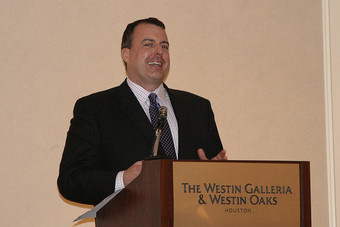
PRSA Houston Speech
Bryant A. Hilton, a public relations representative for Dell, giving a speech entitled “Going Green: Dell’s Journey to Sustainability.”
IMPRESS YOUR BOSS
Success in public speaking indicates creativity, critical thinking skills, leadership abilities, poise, and professionalism–qualities which are very valuable for the job market.
GAIN PUBLICITY
Public speaking is a great way to bring your message to a wider audience.
EXPAND YOUR PROFESSIONAL NETWORK
Public speaking can bring like-minded professionals together to share ideas. These engagements are great networking opportunities!
PERSONALIZE YOUR PROFESSIONAL REPUTATION
If you establish a good reputation as a public speaker, your public persona will set you apart from the sea of faceless resumes and cover letters.
Influence the World Around You
FIND THE RIGHT WORDS TO INSPIRE CHANGE
Public speaking has a long history as a catalyst for nonviolent activism and political change. It is a powerful way to unite people under a common cause and motivate them to take action.
1.3.2: Personal Benefits of Public Speaking
Public speaking has great personal benefits, such as building self-esteem, honing critical thinking skills, and presenting networking opportunities.
Learning Objective
List the rewards of public speaking
Key Points
- Public speaking can be intimidating. It is actually a common phobia. Overcoming this fear can be a satisfying personal victory.
- Public speaking is a great way to further personal development on many levels, since improving communication skills is helpful in every area of life: personal and professional.
- Public speaking engagements are great places to meet new people and build your social and professional networks.
Key Term
- critical thinking
-
The application of logical principles, rigorous standards of evidence, and careful reasoning to the analysis and discussion of claims, beliefs, and issues.
Personal Benefits: Satisfaction, Development, Critical Thinking, Social Connections
Personal Satisfaction
Public speaking is a very common phobia, right up there with spiders and killer clowns. Many people would prefer to do almost anything—even clean the bathroom—instead of standing up and talking in front a crowd of people. Delivering a speech can feel intimidating and risky. Fears and insecurities tend to multiply as the speech draws closer: “What if I freeze up?” “What if I forget my speech?” “What if people get bored and walk out?” “What if the audience tears me apart during the Q&A?”

Common Phobias
Many people have phobias. Just like some people are scared of spiders, others are afraid of public speaking.
If you’re thinking, “Why would I want to do something so stressful?” then remember: no risk, no reward! These fears don’t have to be crippling—practice and preparation can build confidence leading up to a speech. Overcoming these fears is an empowering experience. Public speaking is a great way to show yourself that, with practice, you can do the things that scare you the most. What starts out as a nightmare can turn into a great self-esteem boost.
Once the nervous jitters are under control, you may discover that public speaking is actually very rewarding. It can be satisfying to explain your views to a room full of people. Having the opportunity to share a message you care about is actually pretty special. If you think about it that way, public speaking can be satisfying on a personal level.
Critical Thinking
Public speaking is also a great way to build critical thinking skills. Writing a speech requires a great deal of careful thought, from the audience analysis to the outline to the conclusion. It’s not enough to have a message—you also need to figure out how to tailor the message to fit the needs of your audience. How can you make your points relevant to your listeners? How can you help the audience understand your views? Thinking in this way is a great exercise for improving general communication skills. If you start thinking critically about your speaking style, you may find ways to improve your general communication style at home and at work.
Personal Development
Communication skills are crucial for personal and professional success. Preparing a speech forces speakers to take a step back and think critically about effective ways to communicate. In day-to-day life, it is easy to fall back on communication habits we formed many years ago. If communication is the backbone of the important relationships in your life, isn’t it worth taking some time to work on it? Improving your communication skills can make life more fulfilling on many levels.
Social Connections
Are you looking for new ways to network and make social connections? Try public speaking. Giving a speech is like starting a conversation with a room full of people—and you can continue that conversation as soon as you step down from the podium. You and your audience share an interest in the topic of your speech, so you already have something to talk about! If the schedule allows, try to mingle with the audience after your speech, answering questions and seeking fresh perspectives on your topic. Give audience members the option of getting in touch with you at a later date by listing contact information on handouts or slides. If you have a website, direct audience members to find more information there. If you are part of a speaking lineup, reach out to your fellow presenters. Congratulate them or, if you miss a talk, ask how it went. There are lots of opportunities for networking in the realm of public speaking, so plan ahead and make use of them.
1.3.3: Career Benefits: Advancement
Public speaking is a great tool for career advancement because it provides opportunities to impress the boss, seek publicity, and network.
Learning Objective
Use public speaking as a tool for career advancement
Key Points
- Public speaking is a great way to showcase your talents, skills, and abilities.
- For professionals who want to build a personal brand, increase publicity, or earn a reputation as an expert, public speaking is a great way to further those ambitions.
- Public speaking engagements are great networking opportunities.
Key Term
- networking
-
the act of meeting new people in a business or social context.
Career Benefits: Advancement
Public speaking can be a great way to advance your career. No matter what your goals are, showing your boss that you deserve a raise, advertising your “personal brand,” or finding new career opportunities, public speaking can help you achieve them.
Impressing the Boss
Success in public speaking is a good indicator of valuable professional skills. Composing an effective speech demonstrates creativity and critical thinking. Holding an audience’s attention demonstrates a talent for leadership. Maintaining confidence and poise during a speech and Q&A session demonstrates professionalism under pressure. If you’re trying to impress your boss, public speaking can be a great showcase for your professional abilities.
Self-Promotion
If you’re looking for publicity, speaking engagements are a great place to start. Look for opportunities to discuss your area of knowledge, and present yourself as an expert. One caveat: you still need to do a thorough audience analysis. If you don’t connect your personal story to bigger issues that affect the audience, you will seem self-centered and irrelevant. If you spout opinions without establishing credibility, you may come across as a charlatan. Even if your goal is self-promotion, remember: the world doesn’t revolve around you, and neither should your speech. You want good publicity, not bad publicity!
Networking

Meeting New People
In many business cultures, networking involves meeting new people. A handshake is a common gesture.
Public speaking is a great way to connect with people who share your interests and goals. You can get more mileage out of speaking engagements if you initiate conversations with other speakers and audience members. Find out more about their interests, and take those interests into consideration when you write your next speech.
In terms of professional networking, public speaking can help you gain an edge over the competition. A speech will show more of your personality than a resume or cover letter. You can control the content and tone of a speech more easily than you can dictate the content of a job interview. The primary elements of the typical job application–the resume, cover letter, and interview–are tough to ace, since rigid formatting makes it difficult to stand out from the crowd. When you have public speaking opportunities in a professional context, take advantage of them! Try to be memorable, make connections, and follow up afterward. If your professional connections know you as a speaker, you will be more than just another faceless resume and cover letter.
1.3.4: External Benefits: Influence the World Around You
Public speaking skills can be used to influence the world through public leadership and in personal day-to-day applications.
Learning Objective
Give examples of ways public speaking can lead to influence
Key Points
- There is a strong correlation between communication skills and leadership. Speakers can use knowledge of persuasion to motivate others to take collective action to achieve desired goals.
- Modern communication technology allows speakers to share their message and influence audiences any place in the world, for the cost of an internet connection and camera phone.
- Experienced speakers can use their skills to accomplish simple goals in daily life with new self-confidence.
- Trained speakers should ask, “How will I use my skills to influence the world around me? ” and other relevant questions.
Key Terms
- orator
-
A skilled and eloquent public speaker.
- leadership
-
A process of social influence in which one person can enlist the aid and support of others in the accomplishment of a common task.
Example
- Can words really change the world? When Martin Luther King, Jr. stood on the steps of the Lincoln Memorial and delivered his famous “I Have a Dream” speech, he put his faith in the power of public speaking. King’s faith was justified; that speech is credited with paving the way for the 1964 Civil Rights Act, a bill that took important steps toward making his dream a reality. King remains one of the most revered orators of all time, and a stellar role model for those who believe words can change the world.
External Benefits: Influence the World Around You
Public speaking skills allow people to to influence the world through public leadership in society, including roles in commercial organizations, the volunteer sector, groups, and clubs. They can also enhance one’s personal development and self-confidence.
Public Leadership as Influence
Public speakers have the opportunity to influence others; they can use their knowledge of persuasion to motivate others to take collective action to achieve desired goals. There is a strong correlation between leadership and communication skills. Leadership has been described as “a process of social influence in which one person can enlist the aid and support of others in the accomplishment of a common task. ” Public speaking skills can be used to influence multiple people simultaneously, such as in a meeting or when addressing a large group. Speaking skills can help when setting and agreeing to a motivating vision or future for a group or organization to ensure unity of purpose; creating positive peer pressure towards shared, high performance standards and an atmosphere of trust and team spirit; and driving successful collective action and results.
Martin Luther King, Jr., Winston Churchill, and Nelson Mendela are notable examples of effective orators who used oratory to have a significant impact on society. The influence of the great leaders may have been initially limited to moving an audience in person with written copies of their speeches distributed. With the invention of radio and television, listeners who could not attend in person were still influenced by the words of the speaker.
Global Leadership as Influence
Today, the reach of technology is pervasive and global. In the past, influencing others involved speaking directly to an audience face-to-face or having expensive equipment for broadcasting. Today, modern communication technology coupled with the internet means that speakers can share messages and thoughts with audiences anyplace in the world for the cost of an internet connection and a camera, or simply a smart phone recorder.
How Influence Works in Daily Life
Public speaking skills are not reserved for global leaders; anyone can use the same skills in his or her daily life to speak with confidence. Aristotle defined rhetoric as the “faculty of discovering the possible means of persuasion in reference to any subject whatever. “
For example, imagine someone who wants to persuade his or her parents for money. Chances are that this person will work through strategies for persuading them why he or she needs the money and why the parents should provide it. He or she will reflect on what has and has not worked in the past, including previous successful and unsuccessful strategies. From this analysis, he or she constructs a message that fits the occasion and audience.
Now, imagine that the same person wants to persuade his or her roommate to go out to get Mexican food for dinner. He or she is not going to use the same message or approach that he or she used with the parents. The same logic exists in public speaking situations. Aristotle highlighted the importance of finding the appropriate message and strategy for the audience and occasion in order to persuade.
By training in public speaking and actually speaking in front of an audience, one develops a sense of self-confidence. Public speakers learn to overcome fear of failure and lack of confidence in order to deliver a message to an audience. They learn to think about ideas, evaluate their truthfulness, and then organize them into a message to share with others.
The flip side of public speaking is listening; people can learn how to influence by learning how to listen. Trained speakers know how to recognize sound logic, reasoning, and ethical appeals. A critical listener is less likely to be persuaded by unsound logic and fallacies or to take action that is not in his or her best interest.
How Everyone Can Influence the World
The world is still full of injustice, ranging from major issues such as poverty to minor issues such as people who cut in line. Every prospective speaker should ask, “Is there a particular cause that has personal significance for me? If I could change something about the world, what would I choose? If studying the art of public speaking will give me the tools to influence the world around me, how will I use them? “

Bust of Martin Luther King, Jr.
Martin Luther King, Jr. used his ability to speak to influence and lead a nation to action.
1.3.5: Differences Between Public Speaking and Conversation
While public speaking and conversation share many similarities, they are in fact two very different forms of communication.
Learning Objective
Differentiate between public speaking and conversation
Key Points
- Public speaking is the process of speaking to a group of people in a structured, deliberate manner intended to inform, influence, or entertain the listeners.
- Conversation is a form of interactive, spontaneous communication between two or more people who are following rules of etiquette.
- There are three key differences that set public speaking apart from conversation: organizational structure, use of formalized language, and method of delivery.
- Speeches involve thoughts that are logically organized and structured, whereas conversations may wander around subjects.
- Speeches use formalized language, while conversation may use slang, profanity, or poor grammar.
- Speeches are often delivered in deliberate, intentional settings and contexts, whereas conversations may arise spontaneously.
Key Term
- conversation
-
the expression and exchange of individual ideas through talking with other people; also, an instance of such talking
Differences with Conversation
It may seem rather simple: isn’t public speaking just a form of conversation with an audience? At the most basic level, that might seem true. But under closer inspection, public speaking and conversation are, in fact, two very different things.

Differences in Conversation
While public speaking involves imparting a message to others, there are key differences between public speaking and casual conversation.
Public speaking is defined as “the process of speaking to a group of people in a structured, deliberate manner intended to inform, influence, or entertain the listeners.” Conversation, on the other hand, “is a form of interactive, spontaneous communication between two or more people who are following rules of etiquette.”
You may already notice the similarities: both conversation and public speaking involve speakers and audiences, as well as messages exchanged between the two parties. Depending on to whom you’re speaking, you’ll adjust your message based on both your audience and the context of your speech or conversation. And of course, a good conversation and a good speech both share elements of compelling and engaging storytelling.
But, for the most part, that’s where the similarities between conversation and public speaking end. There are three key differences that set public speaking apart from conversation: organizational structure, use of formalized language, and method of delivery.
Organizational Structure
Speeches and public addresses are far more organized than everyday conversation. A public speaker organizes his or her thoughts in a speech by using three basic structural elements: an introduction, a body, and a conclusion. Conversations can wander and meander without ever coming to a point. Speeches are deliberately structured and organized, whereas conversations are not.
Use of Formalized Language
When you sit down and have a conversation with a close friend, either face-to-face or via text message or chat, you might find that your language and tone are far more casual than if you were to sit down and have a conversation with, say, your doctor. Public speaking formalizes language that much more. When speeches are designed to “inform, influence, or entertain,” they require a certain formality of speaking compared to a casual conversation between friends. Slang, profanity, and poor grammar might be accepted between friends but are definitely not appropriate for any kind of public address or speech.
Method of Delivery
You hear the phrase “strike up a conversation” more than you hear “strike up a speech” because conversations are far more spontaneous than public speeches. And don’t let extemporaneous speaking fool you: extemporaneous speeches merely involve speaking about a subject with no written notes and are not to be considered truly spontaneous. Conversations can spring up anywhere. Public speaking is often organized into events and venues with a set time and location. Public speeches may also fall within certain time constraints, whereas conversations can be as brief or as long as those involved are willing to participate.
1.4: Elements of Speech Communication
1.4.1: Speaker
The speaker is one of the key elements of the basic speech communication model.
Learning Objective
Define the speaker in the basic speech communication model
Key Points
- Speech communication, in its simplest form, consists of a sender, a message and a recipient. The speaker and sender are synonymous.
- The speaker is the initiator of communication.
- Effective speakers are those who can most clearly delivery their message to their recipients.
Key Term
- sender
-
someone who encodes and sends a message to a receiver through a particular channel; the initiator of communication.
Elements of Speech Communication: The Speaker
— Example image of a speaker

The Speaker
President Barack Obama giving a speech in Accra, Ghana on July 11, 2009.
The communication cycle offers a model for communication. In its simplest form, the cycle consists of a sender, a message, and a recipient. Other models include the channel, which is the vehicle in which your message travels. For the purposes of speech communication, the speaker is you!
The speaker is perhaps the second most important factor in the speech communication model, second only to the message (your speech) itself. Let’s take a step back and look at a very specific definition of the message speaker, or sender:
A sender is someone who encodes and sends a message to a receiver through a particular channel. The sender is the initiator of communication.
When you think about how you craft your speech, you’re actually encoding your message. This doesn’t mean that your speech is laced with cryptic clues for your audience to determine the meaning and purpose, rather, it gives you a way to think about your speech in a new light. Your message’s recipient, the audience, will have to decode your message. With their brainpower, experience and intellect, they need to make sense of the very message you’re trying to deliver. This is why it’s so valuable to understand the importance of your role as speaker, as the initiator of communication in the delivery of your message.
When you are able to successfully communicate your message, that is, when the audience can decode your message, then you have become a successful communicator.
1.4.2: Message
The message is the most important and instrinsic element of all speech communication models.
Learning Objective
Define the message of the basic speech communication model
Key Points
- With regard to public speaking, your speech is your message.
- Your audience, the receiver, may send you a message in response to your message in the form of feedback.
- Messages consist of both verbal and non-verbal elements. Your words and how you deliver them equally make up the balance of your message.
Key Term
- message
-
A communication, or what is communicated; any concept or information conveyed.
Elements of Speech Communication: The Message

The Message
What is the message that you’re trying to get across to your audience?
No matter which model of communication you study, every model includes the most important element of all: the message. You can’t have communication without a message. The word “message” actually comes from the Latin mittere, “to send. ” The message is fundamental to communication.
With regard to public speaking and speech communication, your speech is your message. But you may have other intentions for your speech as well: the message behind the message. Perhaps you have a singular goal, point or emotion you want your audience to feel and understand. Every single word that you use to craft your speech then, works to achieve that singular goal, point or emotion.
As the sender, the speech writer and speech giver, you may also be getting messages back from your receivers: your audience. This is what’s known as feedback, when the receiver sends a message of response back to the sender. In this way, messaging becomes a dynamic conversation of feedback as the sender sends his or her message to his or her audience, receives feedback from the audience, and then adjusts the message accordingly based on said feedback.
Messages can be sent both verbally and non-verbally. You can say one thing with your words, but depending on how you say it and the non-verbal cues such as posture and eye contact, you may send an entirely different message to your audience. That said, it’s important to consider all aspects of your overall message, from verbal to non-verbal to the meaning and message behind the message, when crafting your speech.
1.4.3: Channel
The channel is the method (auditory and visual) that is used to transmit the message to the receiver.
Learning Objective
Give examples of auditory and visual channels used in public speaking
Key Points
- In a face-to-face setting, the channel will be primarily audio and visual; in a speaking situation with remote audience via videoconferencing, the channel will be computer mediated audio and visual.
- When the speaker and the audience are in the same room at the same time, the channels of communication are synchronous.
- When listeners receive the speech at some time after the speech was delivered, the channels are asynchronous (that is, in delayed time).
Key Terms
- mediated
-
Acting or brought about through an intervening agency.
- channel
-
The method a sender uses to send a message to a receiver. The most common channels humans use are audtiory and visual.
- co-located
-
To locate or be located at the same site, for two things or groups at same space.
Elements of Speech Communication: The Channel
A basic speech communication model includes a sender (that is, a speaker), a message, a receiver (that is, an audience), and a channel. Claude Shannon, who developed one of the earlier communication models, defined the channel as the medium used to transmit the signal from the transmitter to the receiver. In a face-to-face, in-person speaking situation, the channel will be primarily audio using sound and visual using light waves; in a speaking situation with a remote audience via videoconferencing, the channel will be computer mediated audio and visual.
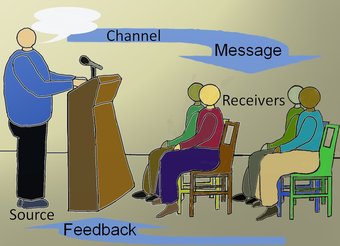
Communication Channel Model
The speaker uses the channel, or speech, to transmit the message to the audience.
Face-to-Face, Co-Located Audience Channel
When speaking to an audience in person, a speaker uses both verbal and non-verbal methods to communicate the message. The sounds that a speaker makes are interpreted as words. The sounds are transmitted through an audio (or auditory) channel as sound waves and are received by the listeners in the audience. Speakers also use their hands to make gestures, change their facial expressions, and project images or words on a screen. These cues are received by the listeners through the visual part of the channel: their sense of sight. When the speaker and the audience are in the same room at the same time, the channels of communication are synchronous, in real time.
Computer Mediated Communication (CMC) Channel
Speakers also use communication channels that are mediated, meaning there is something between the speaker and the receivers. In some cases, the auditory and visual signal is mediated by a computer to convert what the speaker says and does into a digital signal that is transmitted to remote audiences. Computer Mediated Communication (CMC) is able to overcome physical and social limitations of other forms of communication, and therefore allow the interaction of people who are not physically sharing the same space. Computer mediated digital channels may be synchronous, when remote audiences are listening to the speech via computer conferencing or streaming audio and video at the same time the speech is being delivered. The channel might also be asynchronous, when audiences listen to the speech at some time after the speech was delivered, perhaps via a website like youtube.com or vimeo.com. The message delivered through CMC channels could be only audio, but is likely to involve both audio and video, which uses the auditory and visual senses of the humans to decode the digital signals and process the message.

Shannon Weaver Communication Model
The channel in the middle links the speaker with the receiver of the message.
1.4.4: Audience
Your audience represents one very important third in the basic model of communication.
Learning Objective
Analyze your audience based on demographics
Key Points
- “Who is my audience? ” is the first question you should ask yourself before you begin crafting your speech.
- Your audience may share commonalities and characteristics known as demographics. You should never stereotype or generalize your audience by their demographics, but you can use them to inform the language, context, and delivery of your speech.
- Audience demographics to consider include age, culture, race, gender, education, occupation, values, and morals.
Key Terms
- audience
-
A group of people within hearing; specifically a group of people listening to a performance, speech etc.; the crowd seeing a stage performance.
- demographic
-
A demographic criterion: a characteristic used to classify people for statistical purposes, such as age, race, or gender.
Elements of Speech Communication: The Audience

Audience
The audience is the most important part in the model of communication.
At its simplest, communication consists of a speaker, a message, and a receiver. Following this model, your speech represents the message. Naturally, this makes you the speaker. To whom you speak then, represents the receiver: in this case, your audience. When looking at this most basic model of communication, your audience represents one-third of the communication equation, proving it is one of the three most important elements to consider as you craft your speech.
Elements to Consider About Your Audience
Your audience may be represented by a variety of distinguishing characteristics and commonalities, often referred to as demographics. It is important to remember that you should not stereotype or make assumptions about your audience based on their demographics; however, you can use these elements to inform the language, context, and delivery of your speech. The first question you should ask yourself, before you begin crafting your speech, is this: “Who is my audience?”
As you begin to answer this question for yourself, here are some key elements to consider as you begin to outline and define your audience:
- Age: What age ranges will be in your audience? What is the age gap between you and your audience members? Age can inform what degree of historical and social context they bring to your speech as well as what knowledge base they have as a foundation for understanding information.
- Culture/Race: While these are two separate demographics, one informs the other and vice versa. Race and culture can influence everything from colloquialisms to which hand gestures may or may not be appropriate as you deliver your speech.
- Gender: Is your audience mostly women? Men? A mix of the two? It is important to consider your gender and your audience, as the gender dynamic between you and your audience can impact the ways in which your speech may be received.
- Occupation/Education: Just as age, culture, race, and gender factor into your audience’s ability to relate to you as speaker, so may occupation and education. These elements also help to give you an understanding of just how much your audience already may or may not know about your given subject.
- Values and Morals: While these may not be readily apparent, they can factor prominently into your ability to be likable to your audience. Particularly if you are dealing with controversial material, your audience may already be making judgments about you based on your values and morals as revealed in your speech and thus impacting the ways in which they receive your message.
1.4.5: Feedback: Visual and Verbal Cues
Your audience can provide you with immediate feedback; pay attention to the visual and verbal cues they give you in the moment.
Learning Objective
Define feedback and describe how you can receive audience feedback in the moment
Key Points
- An advanced model of communication includes a sender, a message, a receiver, a channel and feedback. Feedback represents a message of response sent by the receiver back to the sender.
- Feedback happens in realtime as your audience provides you with visual and verbal cues in response to your speech.
- If feedback indicates that your message hasn’t been received as intended, you may need to correct course in the moment to make that connection with your audience.
Key Term
- feedback
-
The receivers’ verbal and nonverbal responses to a message, such as a nod for understanding (nonverbal), a raised eyebrow for being confused (nonverbal), or asking a question to clarify the message (verbal).
Elements of Speech Communication: Feedback

Feedback
You audience might give you visual, non-verbal cues that signal how they might be receiving your message.
The simplest model of communication relies on three distinct parts: sender, message and receiver. More complex models throw in a fourth element: the channel via which the message is sent. The most advanced communication models include a fifth element: feedback, that is, a return message sent from the receiver back to the sender. Feedback could be as formal as handing out a presentation evaluation following your speech or presentation. Typically though, you can gauge feedback as your speech is happening by paying very close attention to the visual and verbal cues your audience may be giving you while you speak.
Verbal and Visual Cues
Verbal and visual cues refer to those sounds and reactions you may hear and see made by your audience. If you tell a joke or a funny anecdote, you expect laughter as your feedback. One good way to tell if your joke bombed–no laughter. And, as awkward as it can be in the moment, you get that instant feedback on how you may need to correct course and potentially deviate from your scripted approach in order to make that connection with your audience.
Visual cues can also include making eye contact. As you scan the room, are people returning your gaze? If so, you have an engaged audience, attentively listening to your speech. If you see half-closed or closed eyes, try adjusting your tone and volume: you just might need to wake your audience up a little bit.
And of course, depending on your speech topic, the lack of a smile or a chuckle doesn’t mean your audience is connecting to your words. Tears can indicate that your words have an incredibly powerful effect on your audience if you’re talking about a particularly moving or emotional subject.
The key takeaway is to remember that this feedback loop of immediate audience reaction plays out in real time as you speak, so it’s up to you to be observant and think two to three steps ahead if you need to correct course based on your audience’s feedback.
1.4.6: Noise and Interference
Noise and interference can block your audience’s ability to receive your message.
Learning Objective
Identify methods to cut down on internal and external noise and interference
Key Points
- Noise exists in all aspects of communication, thus, no message is received exactly as the sender intends (despite his or her best efforts) because of the ever-presence of noise in communication.
- Noise can be both external and internal. External noise often relates to your physical environment, such as a noisy room, as well as your physiological state. Internal noise includes psychological and semantic noise, and is how you prevent yourself from effectively delivering your message.
- To combat external noise, speak louder or see if you can be amplified in some way. Alternatively, see if the source of the noise can be stopped or lowered.
- To triumph over internal noise, take a few deep breaths before speaking. Breathe out all of the negative self-doubt and anxieties you may have about speaking. Inhale confidence. You can do this!
Key Term
- noise
-
Various sounds, usually unwanted.
Elements of Speech Communication: Noise & Interference

Noise
Noise and interference can distort the meaning and delivery of your message.
What Are Noise and Interference?
Typically, you know it when you hear it. Noise may be jarring and unpleasant and is usually an interruption or distraction when it occurs. Noise and interference block the sending or receiving of a message. When it comes to public speaking, noise and interference can be a major issue for both you as message sending and for your audience as your message receivers.
Quite simply, noise jams the signal you’re trying to send as you speak.
Noise and interference can be both external or internal. It could be your microphone feeding back through a speaker, causing that ear-splitting high pitch squeal. You could be trying to talk over an auditorium full of chatty high schoolers. Or you could be giving a speech outdoors on a windy day and you’re barely able to shout over the sound of the wind.
Internal noise and interference can be particularly challenging, since this often refers to the internal monologue you might be telling yourself before you get up on stage to speak: “I’m not good enough. I’m going to forget my speech. They’re going to boo me. ” Internal noise can be psychological and semantic in nature, whereas external noise can be known as or include physical and physiological noise. Often, internal noise and interference are the result of anxiety, nervousness, or stress.
Whether internal or external, unless you’re giving your speech in a vacuum, noise is unavoidable. Noise exists at all levels of communication and thus, no message is received exactly as the sender intends (despite his or her best efforts) because of the ever-presence of noise in communication.
Learning How to Tune It All Out
With regard to external noise, double check to see if there are any ways to boost your volume. You might need to physically project your voice a little more to be heard over a low din. You might even need to call attention to yourself so that your audience pays attention. And it’s okay to ask your audience before you speak: “Can you hear me in the back? “
As for internal noise, fear is the enemy. If you’re nervous about speaking, take a few moments before presenting to inhale some nice, deep breaths for a count of four: in through the nose for four, blow it out through the mouth for four. Repeat this until you can feel your heart rate slow down a little and the butterflies in your stomach settle down. You can do this!
1.4.7: Presentation
How you deliver your speech presentation may be just as important as the speech itself.
Learning Objective
Demonstrate how to appropriately present yourself when giving a speech
Key Points
- Remember to “dress to impress”–when in doubt, go for business professional. It’s better to be overdressed for a speech or presentation than underdressed.
- Your verbal communication, in how you phrase and intone your actual words, is vital to building auditory interest for your audience. Try to play with the pitch and tone of your speech; avoid speaking in monotone.
- From gesture to posture, your non-verbal communication via your body language also adds visual depth and engagement for your audience. Maintain eye contact. Don’t wander around stage or gesticulate too much. Make your audience feel comfortable by being comfortable in front of them.
Key Term
- non-verbal communication
-
Nonverbal communication is usually understood as the process of communication through sending and receiving wordless (mostly visual) cues between people. Messages can be communicated through gestures and touch, by body language or posture, by facial expression and eye contact.
Elements of Speech Communication: The Presentation

Presentation
How your message comes across is just as important as the message itself.
The delivery of your message may be just as important as the words you speak. There are a number of factors to consider when delivering your speech that can help or hinder your efforts to an effective overall presentation.
Appearance
You may have heard the phrase, “Dress to impress. ” This couldn’t be more true when getting up to deliver a speech. While some speech venues and settings might be more casual, chances are, you should be dressed in business attire. While fashion may change as quickly as the seasons, some basic tips regarding business professional or business formal attire hold true:
For men: A suit is a good staple for any business professional wardrobe. When in doubt as to just how formal or professional, stick with button-down shirts and add the tie (as cumbersome as it might be). If you can swing a blazer or suit coat, do it. If not, the tie is a good business formal backup. Hair should be neat and faces clean-shaven.
For women: What constitutes business casual versus business professional or formal is always changing, but a good rule of thumb is to keep your shoulders covered and skirts knee-length or longer. Dress and pant suits are usually acceptable as well as single-piece dresses. Avoid any plunging necklines. Keep the makeup to only what’s necessary and hair should be neat. If you’re comfortable in tall heels, go for it. Otherwise, choose a pair of shoes in which you are confident you can be sturdy when entering and exiting the stage as well as standing for the duration of your speech.
Verbal Communication: Your Words and Ideas
The actual words that you say certainly influence your presentation. Make sure that you rehearse often so that the words feel comfortable in your mouth as you speak them aloud. Be on the lookout for phrases that might trip you up or leave you tongue-tied. Practice your speech in front of another person or small group of people: ask them if what you’re saying–from the ideas to which you’re trying to get across to your phrasing, tone and style–make sense to them.
Non-Verbal Communication: Your Body Language
Your non-verbal communication is equally as important as the words you have to say. Your body stance and posture and your eye contact (or lack thereof) can be crucial in making yourself relatable to your audience. You’ll want to keep an assertive body posture: stand up straight and maintain eye contact when you can (if you’re not reading from prepared remarks). Be mindful of gesture: don’t overdo it, but don’t stand there rigidly, either. Gesture and movement build visual interest for your audience. If you’re able to get out from behind a podium or lectern, do so.
1.4.8: Situational and Environmental Context
It is important to understand the environmental and situational contexts in which you are giving a speech.
Learning Objective
Define situational context, environmental context, and situational awareness
Key Points
- Without context, your audience may not understand your message. Conversely, you might not understand your audience.
- Situational context refers to the reason why you’re speaking. Think of situational context as the event itself.
- Environmental context refers to the physical space and time in which you speak. Think of environmental context as the time and venue of the event.
- The key to understanding your context is to cultivate a habit of situational awareness. It’s not something you’ll learn overnight, but by being keenly aware of your surroundings, you’ll learn to always think one step ahead should context change suddenly when speaking.
Key Terms
- situational awareness
-
the perception of environmental elements with respect to time and/or space, the comprehension of their meaning, and the projection of their status after some variable has changed, such as time, or some other variable, such as a predetermined event.
- context
-
the surroundings, circumstances, environment, background, or settings that determine, specify, or clarify the meaning of an event or other occurrence.
Example
- A politician gives a stump speech on the campaign trail. A best man gives a toast at a wedding. The Queen of England knights actor Ian McKellan. In each of these instances, context is crucial. A politician wouldn’t knight Sir Ian nor would a best man give a stump speech at a wedding. Remember: if you can’t fully grasp the context in which you’re speaking, your audience won’t understand you.
Elements of Speech Communication: Situational and Environmental Context

Environmental and Situational Context
The environmental and situational context in which you give a speech is important.
Just as you consider your audience when crafting your speech, you’ll also want to consider the context in which your speech will be given. While context certainly includes your audience, it also encompasses many other factors that are important for you to consider as you craft your speech.
Consider for a moment when you hear just the tail end of a conversation in passing. It doesn’t always make much sense. What you’re missing, in this instance, is the context of that conversation. Just as you need it to understand the conversation you just missed, both you and your audience need to be on the same page about the context of your speech.
Situational context refers to the actual reason why you are speaking or presenting. If you’re campaigning for office, you might deliver what’s called a “stump speech” – a speech you repeat over and over on the campaign trail that gets at the main talking points and promises of your campaign. If you’re at a funeral, you may be asked to deliver a eulogy. On a lighter note, you might be at your best friend’s wedding and asked to give one of the first toasts.
The manner in which you deliver your speech, from the words you say to how you say them, relies on the situational context. For example, you wouldn’t read a eulogy at a wedding?
Environmental context refers to the physical space in which you’re speaking. Whether you’re in a classroom presenting the findings from a lab report or in a stadium that seats thousands, environmental context can influence both your message and delivery. The audience will connect with you in different ways depending on the environmental context. You may need to work harder to build individual connections with your audience members the larger the audience you have.
The key then, to understanding your context is to develop a habit of situational awareness. Situational awareness refers to one’s perception of their environment and situation around them on a moment by moment basis. In being situationally aware, you can anticipate changes to your environment. In this way, you’re always thinking just one step ahead in any given situation or environment, and can be able to adapt accordingly. Cultivating this skill (and it does take time and a keen awareness of your surroundings) is especially helpful when your context may shift or change in subtle or major ways, or in an instant.
1.4.9: Context of Culture and Gender
Understanding the cultural and gender context of your speech is vital to making a connection with your audience.
Learning Objective
Define gender and culture in relation to public speaking
Key Points
- Gender and culture are societal constructs of sex and (sometimes, but not always) race, respectively.
- People who identify as one sex (i.e., female) may not necessarily associate with the corresponding gender traits (i.e., feminine). The same is true of race and culture, respectively.
- Both gender and culture come with their own set of biases: bias that you may have toward differing genders and cultures, and the biases that differing genders and cultures may have towards you.
Key Terms
- culture
-
The beliefs, values, behavior and material objects that constitute a people’s way of life; the arts, customs, and habits that characterize a particular society or nation.
- bias
-
An inclination towards something; predisposition, partiality, prejudice, preference, predilection.
- gender
-
The sociocultural phenomenon of dividing people into the categories of “male” and “female,” with each having associated clothing, roles, stereotypes, etc.
Elements of Speech Communication: Cultural and Gender Context
Both culture and gender play key roles not only in how you perceive your audience, but in how your audience perceives you.
Understanding Gender
When we think of gender, we often think of male or female; that’s only half of understanding gender. The denotations of male and female actually refer to biological and physiological sex. Gender is a sociological construct of values, ideals, and behaviors about what it means to be either male or female, and are often regarded in terms of masculine or feminine, respectively. Many people use sex and gender interchangeably, but one does not have to be male to identify as masculine, and vice versa.
Understanding Culture
In the example above, we have both a biological, physical characteristic (sex) with a superimposed cultural construct (gender). The same applies to both race and culture, respectively. Race refers to groups of people who are distinguished by shared physical characteristics, such as skin color and hair type. Culture refers to the customs, habits, and value systems of groups of people. People of the same race may not share the same culture; similarly, a culture isn’t necessarily comprised of people of the same race.
How Gender and Culture Can Impact Public Speaking
When considering both gender and cultural contexts, we often encounter bias, both intentional and unintentional, and implicit or explicit. We may have presumptive judgments or opinions about those cultures and races that differ from our own, which are often the result of our own upbringing. And as much as you might be biased toward or against certain gender and cultural groups, your audience will have just as much bias as you, and in different ways.
As such, it is radically important to know exactly to whom you’re speaking when giving your speech. It’s helpful for you to anticipate not only the biases you might bring to the podium, but those biases of your audience towards you as well.

Cultural and Gender Context
The speaker’s gender and cultural identity and the audience’s cultural and gender identities invariably influence one another.
1.5: Types of Public Speeches
1.5.1: Informative Speeches
An informative speech involves a knowledgeable speaker transferring some of their knowledge to their audience.
Learning Objective
List the types of informative speeches and describe their use
Key Points
- A speaker should be very knowledgeable about the topic of their informative speech.
- The topic of an informative speech can range from a detailed method to an abstract concept.
- Narrower topics make for more robust and comprehensible speeches.
- Practice any speech multiple times.
Key Terms
- object
-
A thing that has physical existence.
- inform
-
To communicate knowledge to others.
- concept
-
An understanding retained in the mind, from experience, reasoning and/or imagination; a generalization (generic, basic form), or abstraction (mental impression), of a particular set of instances or occurrences (specific, though different, recorded manifestations of the concept).
Example
- A professor giving a lecture, which provides technical information on a given topic to the audience of students, is an example of an informative speech.
An informative speech is one in which the speaker relays knowledge to an audience on a specific topic. There are four distinct categories of topic:
- things, people, or places
- methods
- events
- ideas
Speeches About Objects
For the purposes of this type of informative speech, anything that is visible and tangible is considered an object. Object speeches seek to impart knowledge about this object to the audience. Whether your object is the human body or the most recent episode of Family Guy, informative object speeches provide a comprehensive overview of your object as topic.
It’s important that object speeches have a purpose: using our previous examples, you may discuss the complex, myriad ways in which the endocrine system functions and how it regulates metabolism; similarly, you may describe how Family Guy serves as a modern form of satire in pop culture. It’s one thing to spout off facts about an object, but there must be a purpose to those facts.
Speeches About Processes
A process is the manner in which something is created, made, done, or works. An informative speech about a process then describes how something is made, done, or works. Processes could include anything from how the modern electoral college works to how an ice cream sandwich is made on the factory line. Informative process speeches work to help your audience both understand the process, and possibly be able to replicate the process for themselves (if applicable).
Speeches About Events
Any occurrence that happens is regarded as an “event. ” A speech about an event then, describes the occurrence in full: the time, date, location, and circumstances of that occurrence. Like all informative speeches, event speeches must also serve a purpose. You may talk about how the Battles of Lexington and Concord came to be known as the “shot heard ’round the world,” or describe the experience of your first week at college. In either case, your speech must have a purpose to it.
Speeches About Concepts
Concepts refer to ideas, beliefs, theories, attitudes, and/or principles. When speaking about concepts, you may have to find concrete ideas in order to make abstract ideas more relatable and tangible to your audience. Whether discussing the theory of the origins of the universe to whether there’s any truth to the phrase “love at first sight,” concept speeches break down complex ideas into manageable chunks of understanding for your audience.
Crafting an Effective Informative Speech
A narrowly focused speech topic can really hone in on an object, process, event, or concept, thus making it easier for the audience to understand that topic. A broadly chosen topic usually entails lots of different kinds of information, which might complicate the informative quality of a speech and confuse the audience members. A narrowed focus also makes researching more manageable for the speech writer and increases his or her ability to understand that topic thoroughly before presenting it to others.
When writing an informative speech, pick out a small number of key points on your specific topic that you want the audience to take away from your speech. Use these points to develop an organizational structure to your speech, which should include an introduction, body, and conclusion. This structure will provide a trajectory that guides your audience as you elaborate the key points of information. Having a structure gives you, as the speaker, an opportunity to introduce the key points in the introduction and revisit them in the conclusion, increasing the likelihood that the audience will walk away with the key knowledge about your topic.

Informative Speech
A lecture is an example of an informative speech.
1.5.2: Persuasive Speeches
In a persuasive speech, a speaker attempts to persuade the audience to adopt his/her position in relation to a topic.
Learning Objective
Explain how to compose a persuasive speech
Key Points
- A persuasive speech intends to persuade the audience to adopt the position of the speaker.
- Know your audience: in order to be persuasive, the form and content of your speech must take into account what the audience knows and how it wants to be addressed.
- An appeal to ethos is used to show the character of the speaker and make him/her more credible.
Key Terms
- audience
-
A group of people within hearing; specifically a group of people listening to a performance, speech etc.; the crowd seeing a stage performance.
- pathos
-
That quality or property of anything which touches the feelings or excites emotions and passions, esp., that which awakens tender emotions, such as pity, sorrow, and the like; contagious warmth of feeling, action, or expression; pathetic quality.
- persuade
-
To successfully convince someone to agree to, accept, or do something, usually through reasoning and verbal influence.
Example
- A persuasive speech can be seen in the image where William Jennings Bryan gives a campaign speech. Here he is trying to persuade the audience to cast its vote for him.
The purpose of a persuasive speech is to convince the audience to adopt the speaker’s perspective on a given topic. The core of a persuasive speech is pathos: appealing to and resonating with the audience’s feelings and emotions.
In order for the pathos contained in a persuasive speech to be effective, the speaker has to understand the audience he/she is addressing.To be convincing, the speaker has to take into account the behavioral motivations and foundational beliefs of the audience.
Showing empathy with the audience is crucial. Drawing parallels between yourself and the audience reduces the distance between you and them, making your speech that much more persuasive.
In addition to pathos, persuasive speeches contain appeals to ethos and logos. An appeal to ethos is used to show the character of the speaker and make him/her more credible. For the audience to be persuaded, they have to feel that the speaker is a credible and worth listening to. An appeal to logos requires referencing evidence. This demonstrates the extent to which the speaker is knowledgeable about the topic he/she is speaking about, making their speech more persuasive than if he/she appeared ill-informed on the topic.

William Jennings Bryan, 1908
A picture of William Jennings Bryan giving a campaign speech in 1908.
1.5.3: Informative vs. Persuasive Speeches
Many speeches will contain elements of both informative and persuasive speeches.
Learning Objective
Distinguish between an informative speech and a persuasive speech
Key Points
- An informative speech aims to inform the audience about a specific topic.
- A persuasive speech aims to persuade the audience to perform a certain action or convince the audience to adopt the belief or opinion of the speaker.
- Many speeches will combine features of informative and persuasive speeches.
- Know the audience: the types of knowledge they possess, the core beliefs they hold, and what motivates them to undertake actions.
- Considering the purpose of the speech will help determine if the speech should use more of the features of informative or persuasive speeches.
Key Terms
- pathos
-
That quality or property of anything which touches the feelings or excites emotions and passions, esp., that which awakens tender emotions, such as pity, sorrow, and the like; contagious warmth of feeling, action, or expression; pathetic quality.
- persuasive
-
Able to induce to believe by appealing to reason or understanding; convincing.
- informative
-
Providing knowledge, especially useful or interesting information.
Example
- The State of the Union is an example of a speech that is instructive, because the President of the United States is supposed to tell the members of Congress what the state of the union is, while also being persuasive, by aiming to persuade citizens to adopt the beliefs of the President.
When choosing between writing an informative or persuasive speech, the speaker should consider the purpose of the speech. Is it to share information about a particular event, topic, or subject? Or is it to persuade the audience to hold a certain belief or attitude about said event, topic, or subject?
The focus of the thesis, or the main argument of the speech, often dictates whether the speech will be mainly informative or persuasive in nature. However, keep in mind that some speeches will contain a combination of both types of speech.
Informative speeches describe knowledge about a particular event, process, object, or concept. The goal of an informative speech is for the audience to fully comprehend this knowledge. Persuasive speeches are those that seek to have the audience share a belief or feeling about a particular event, process, object or concept. The difference is subtle, and yet mighty.
For example, imagine a topic that could fall into either category, such as reproductive choice. An informative speech may track the history of reproductive choice in America. A persuasive speech may discuss the pros and cons of Roe v. Wade, or how some groups feel that reproductive choice is threatened. In the latter instance, using examples from history may bolster that argument. As noted above, all persuasive speeches will be informational in nature, but not all informational speeches may be persuasive.
Fully understanding the informational or persuasive purpose of the speech will help the speaker determine what rhetorical strategies to use in the pursuit of achieving his or her goal. If the purpose is simply to provide information, then the speech will likely rely less on pathos and more on evidence, statistical data, or charts and graphs. If the purpose is have the audience believe or feel a certain way about the subject, then the speaker will tailor the evidence and specific data with appeals to emotion to lead the audience to the desired point of view.
When writing a speech, take into account the intended audience that will be addressed; never underestimate the importance of knowing the audience. For example, when giving an informative speech, the speaker must take into account not only the audience’s familiarity with any technical terms, but also what sort of pathos he or she may want to use. Some audiences will respond to certain appeals to emotion, while others might be turned off to the speaker if he or she makes what is seen as an inappropriate appeal to emotion. Therefore, always consider the specifics of your audience–age, occupation, beliefs, motivations–and then use these specifics to inform the form and content of the speech.
The State of the Union is a good example of a speech that contains elements of informative and persuasive speeches. In the State of the Union, the President of the United States is supposed to inform the members of Congress on the state of the union. Therefore, it commonly contains specific information (for example, the number of jobs created in a certain time period).

President Truman, 1950
President Truman delivers his State of the Union to Congress in 1950.
However, the State of the Union also contains heavy pathos that is intended to make citizens feel confident about the President’s handling of the nation and hopeful about the future. The President will spin data and use emotional appeals to make his or her case to the American people. This specific speech makes it clear that a speech can combine the features of informative and persuasive speeches.
1.5.4: Speeches for Special Occasions
Some special occasions require speeches that are different than speeches aimed at informing or persuading audiences.
Learning Objective
Differentiate a special occasion speech from an informative or persuasive speech
Key Points
- Special occasion speeches tend to be shorter speeches, commonly less than ten minutes.
- Special occasion speeches are commonly addressed to a particular audience.
- Depending on the context, special occasion speeches can be funny or sad.
Key Terms
- context
-
the situation in which something happens.
- pathos
-
an appeal to an audience’s emotions or sensibilities.
- toast
-
to engage in a salutation and/or accompanying raising of glasses while drinking alcohol (or other appropriate beverage) in honor of someone or something.
As the name implies, special occasion speeches are speeches that are given on special occasions. There are many examples of special occasions where it might be appropriate to deliver a speech. For example, an individual might give a speech at a wake or memorial for an audience of friends and families who knew the person being memorialized. Clearly this speech will be very different than a toast given at a wedding, which is also an example of a special occasion speech and which will have a much more celebratory tone. A commencement ceremony or award ceremony are some other special occasions during which someone may give a speech.
Special occasion speeches are usually shorter than informative or persuasive speeches. Special occasion speeches are usually less than ten minutes long, which demonstrates that their purpose is different than other types of speeches delivered at a conference or political rally. Depending on the context, the purpose of a special occasion speech may be to remember, to praise or to humorously tease. They may contain a use of pathos that aims to convince the audience to be happy, possibly by being comedic. However, they may use a pathos intended to make the audience reflective, as in a speech given at a memorial service.
Special occasion speeches might inform the audience. For example, someone may give a speech at a wedding and share a specific memory, thus informing the audience of that particular incident and possibly articulating its importance in relation to the newlyweds. While special occasion speeches may be informative, their purpose is always specific to the context and audience that will be hearing them.

A wedding toast
The toasts that are given at a wedding are an example of special occasion speeches.
